The Premier Pantomime Cartoonist
If you looked at a newspaper or magazine cartoon in, say, the 19th century, it might seem a little … off. The illustrations were packed with pen strokes, and captions were often comprised of two to four lines of wordy dialogue, resulting in the effect of a short conversation between two sketched characters.
One of the cartoonists responsible for upending this style — and pioneering the kinds of strips we know today — was Otto Soglow, born on this day in 1900. At The New Yorker and, later, in this magazine and newspapers across the country, Soglow pared down lines in his illustrations, presenting a clean, minimalist rendering of whimsical characters. In the way of captions, uniquely, he often used very few or none at all, making a name for himself as a pantomime cartoonist with his popular strip The Little King, which ran for almost 40 years.
Soglow didn’t set out to become a cartoonist. A passionate performer, he dropped out of high school to pursue a career in acting. He worked as a shipping clerk, a packer, and even as a baby rattle painter before taking up illustrating professionally. In the 1920s, Soglow drew toons for the pages of radical New York publications like The New Masses and The Liberator. Influenced by the politics and aesthetics of the Art Students’ League, his work during this time depicted gritty cityscapes, working-class scenes, and socially-conscious themes.
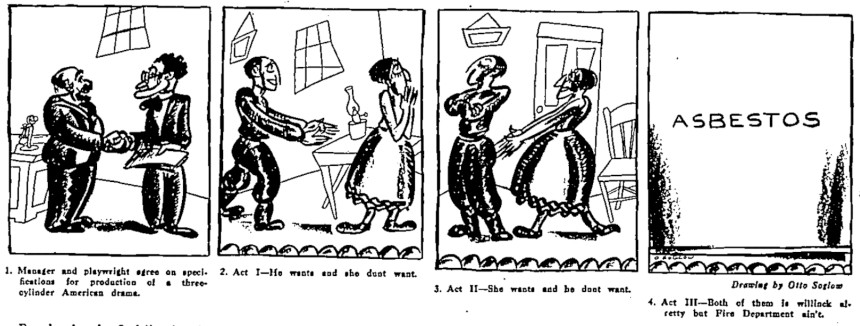
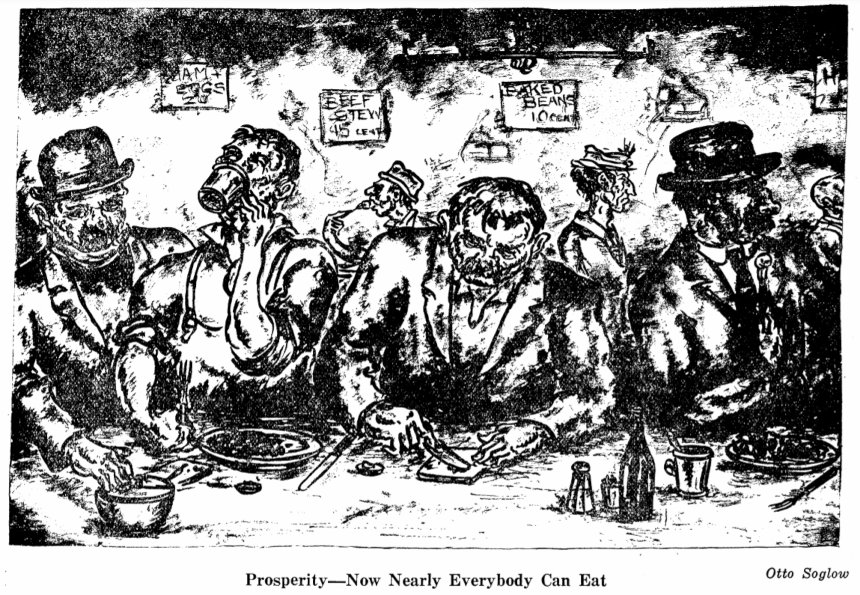
In the August 1922 issue of The Liberator, which had published one of Soglow’s earliest illustrations the month before, the editors apologized for neglecting to credit him, saying “Soglow is to give the Liberator more of his strong work, so full of atmosphere, poetry, and sensitive observation.”
By the late ’20s, he was publishing toons and small illustrations in The New Yorker, alongside names like Peter Arno, Helen Hokinson, and James Thurber. In the magazine’s obituary for Soglow, the author noted that while his style was once busy with ink, it became purer over the years, eventually omitting all details except the most necessary: “There was nothing to distract the eye or the mind.” The New Yorker was also where Soglow introduced his most famous and enduring character: the little king.
In various weekly adventures for more than 40 years, Soglow’s “cartoon monarch” stumbled through silent, playful scenarios at the perplexity of his royal court. Far from a stereotypical depiction of a severe ruler, Soglow’s childlike king displayed no interest in power, but rather enjoyed simple pleasures like ice cream and zoo animals. While his barrel-chested guards smoked cigars, the short stubby sovereign blew bubbles out of a toy pipe. Soglow’s sight gags in his Little King strips — which were syndicated in papers around the country from 1934 to 1975 — were endearing nods to our better, more innocent, angels.
In taking his cartoons to a larger audience, the once-socialist Soglow struck a deal with newspaper magnate William Randolph Hearst. If this move wasn’t quite contradictory, his career quickly took a commercial turn as he began illustrating ads for Realsilk socks, Mutual Life Insurance Company, Fleischmann’s Yeast, Pepsi-Cola, oil companies, and others. His ads — of course, lacking the quaint charm of his other work — appeared in The Saturday Evening Post for decades. Soglow was also a staunch supporter of the war effort, designing propaganda posters and supporting art programs for soldiers.
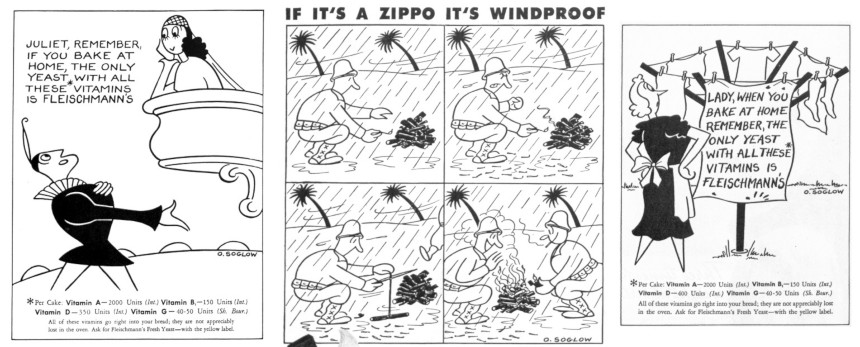
Although he likely made a great deal of money illustrating and cartooning, Soglow never lost his desire to perform. New York newspapers in the ’30s and ’40s described him as a hit at parties, giving impersonations and magic tricks that rivalled Chaplin’s. Given his earlier penchant for the poetic and the critical, discerning audiences might be tempted to read some semblance of subtle geopolitical commentary into The Little King, but Soglow said that was baseless and “just plain silly.” As for the origin of the beloved character that graced funny pages for decades, he gave no deep, revelatory explanation; “He just happened.”
Soglow drew The Little King until he died in 1975. Although he isn’t remembered widely by the populace, the cartoonist is decidedly among the ranks of important New Yorker illustrators, and the magazine still uses his artwork in print and online. In a review of a new Little King coffee table book in 2012, Jeet Heer called Soglow “one of the central cartoonists of mid-century America.” Flipping through the comics of any paper in the country before and after Soglow, it would be difficult to disagree.
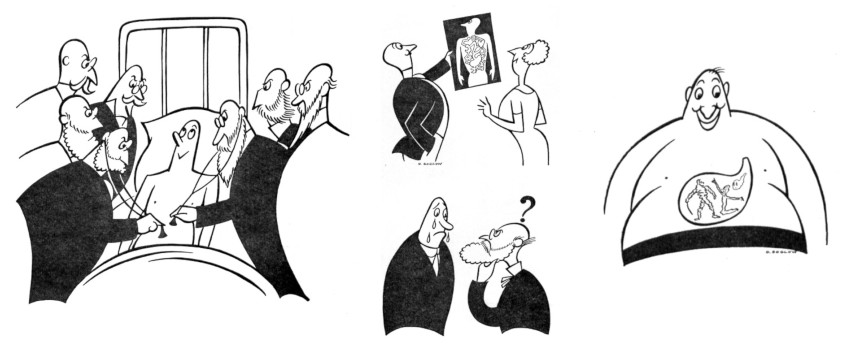
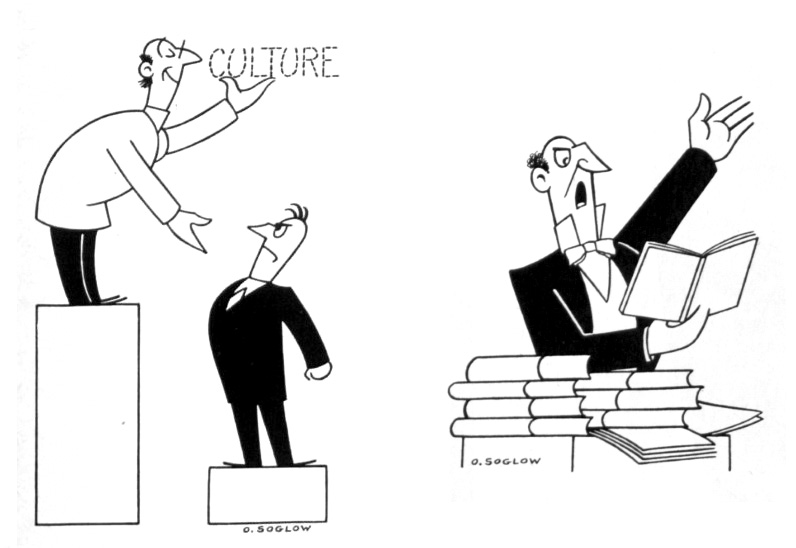
“Who Says I’m Uncultured?”/ “Let’s Keep the Filibuster,”The Saturday Evening Post, June 16, 1962, July 14, 1962
“The Art Movement in Real Estate” by Lucian Cary
Over the course of his career, Lucian Cary contributed more than 60 short stories to publications such as Collier’s, Ture Magazine, and, of course, The Saturday Evening Post. He was also a notable spokesperson for rifles and firearms, but assured Post readers in 1935 that his passion was but a “reasonable enthusiasm.” In “The Art Movement in Real Estate,” Cary tells the relatively peaceful tale of a peculiar group of artists living together in a picturesque Long Island town.
Published on October 30, 1920
Deep Harbor is a village of white houses with green blinds fifty-two miles from New York. Fifty-two miles has always been too far for any but the hardiest commuters. Fifty-two miles means getting up in the dark of wintry mornings to catch the six-fifty-five train. The price of real estate reflects the fact. A piece of land on the Sound big enough for a country estate has always been priceless, but a house in the village has long been cheap. Indeed, houses have often sold of late years in Deep Harbor for a good deal less than it cost to build them. And the highest known rental was thirty dollars a month, which secured a colonial mansion of fourteen rooms set in five acres of park with trees older than the town debt.
Ten years ago an impecunious illustrator discovered this delectable village. His visits to art editors called him to New York only once in ten days, even in his luckiest months. The fifty-two miles did not so much matter: The white houses with the proportions of Greek temples, with small-paned windows, with real fireplaces did matter. Steve Laidlaw loved them, and so did his wife. Those white houses awoke some desire in them that the most elegant of studio apartments in New York did not so much as stir. Besides, a white house with a barn and four apple trees and a place for a garden was actually within their reach. They bought it with what cash they could scrape up, put a studio light in the barn, and settled down to raise a family, with Rhode Island Reds on the side.
The next spring Arthur Millingham, who does those humorous drawings in color for magazine covers, and Bill Montaigne followed the Laidlaws to Deep Harbor. A landscape painter, passing through when the apple trees were in blossom, dropped off to stay a week and remained to buy a white house with lilacs in the dooryard. Another year Joe Hartley moved from Brooklyn to Deep Harbor with his whole retinue of satellites and pupils, a veritable school of illustration.
In time the village acquired a curious flavor — a piquancy. The original New Englanders possessed their full share of that strange power which enables them to take in the outlander without being themselves modified. They ran the town as they had run it since 1674; they elected the selectmen; they owned the bank; they made the roads as they had always made them, exactly as if the automobile and the motor truck had not been invented. But they, whose ancestors had admired the Greek, were tolerant of art. The illustrators found themselves free to wear their old clothes every day, to turn barns into studios of a spaciousness known only to millionaires in New York, free even to argue in the village square whether Gaugin was the most sophisticated or the most primitive of painters, or no painter at all.
As they learned more of the country of their adoption they complained bitterly among themselves of the schools and the roads and the fact that when one of them bought a house from a native and put a bathroom in it the assessment was promptly doubled on the tax list. But their complaints were only proofs of their affection. They liked Deep Harbor, and felt that they owned it, or at least that it had been created for their especial benefit. As Bill Montaigne always said when he broke a spring going over the bumps in the road that led from his house to the village center: “Anyhow, it isn’t suburban.” And Steve Laidlaw, who had been born in the Dakotas and gone to art school in San Francisco, and wandered from Yucatan to Nome, and from Honolulu to Valladolid, and never stayed more than a year in one place before, called it “home.”
II
To this Arcadia came Jimmy Dowling one blustery afternoon in November. Jimmy presented himself at Steve Laidlaw’s studio about the time the daylight failed and Steve turned on the powerful electric lamp above his drawing table. Steve was engaged in finishing the second of three drawings he had promised to deliver the next morning to an art editor in New York. He had figured that he could finish the third before eleven o’clock that night and drive to Bridgeport in time to catch the midnight mail train. He did not intend to be interrupted by anybody. He did not get out of his chair when Jimmy knocked; he yelled “Come in!” and went on drawing. But when he saw Jimmy he instantly laid down his pencil and kicked a chair nearer the big stove and hunted for the cigarettes. Jimmy was a boy of perhaps twenty-two or twenty-three with the look of one who hasn’t had a good meal for two days. He sat down abruptly and lighted a cigarette with fumbling fingers and looked at Steve with eyes like those of a setter pup who has wandered from home and been kicked and lost his illusions. Steve told Ann afterward that he guessed Jimmy’s story in that first minute. He had met it before. Jimmy had spent a season or two at the Art Students’ League and now he had come to the end of his father’s patience.
“I haven’t any excuse for interrupting you at your work, Mr. Laidlaw,” Jimmy said. “I don’t know why I came — except that I’ve always admired your stuff — and imitated it as much as I could. I just thought I’d have to see a real illustrator once before I — before I went back to Dayton, Ohio, and my father.”
“That’s all right,” Steve said. “Is your father a businessman?”
“Yes,” Jimmy said.
Steve grinned.
“My father was a farmer.”
Jimmy grinned back at Steve.
“That’s just as bad, isn’t it?”
Steve laughed.
“It was pretty bad,” he confessed. “I had to farm or else get out. So when I was seventeen I got out.”
“How did you get along?”
“I don’t know, but I did — somehow. You can if you have to.”
“That’s just it,” Jimmy admitted. “I don’t know that I have to be an artist. I don’t know but I ought to go back to my father’s office.”
Steve reflected that Jimmy was hardly the type to fight his way up. He looked intelligent but he didn’t look strong. He himself had stood six feet at seventeen and done a man’s work in the threshing field and on the San Francisco docks.
“Have you got any money at all?” Steve asked.
“I’ve got the price of a ticket to Dayton,” Jimmy said.
“H’m,” said Steve thoughtfully.
“I know I’m interrupting you,” Jimmy said. “I wish you’d go on with your drawing. I’d like to sit here and watch you work for a few minutes — and then I’ll go.”
Steve picked up his pencil.
“I am in a rush,” he admitted. “But you’re going to stay to dinner with us, and spend the night, and in the morning when I’m through with this job we’ll talk.”
“Gee!” said Jimmy Dowling, and somehow managed to put into that small word a great deal of the gratitude he felt at being thus accepted by Steve Laidlaw.
The next morning Steve led Jimmy round to Hartley’s place and introduced him to Joe and the three young chaps who were working under his tutelage. Hartley had worked out a system suggested by a reading of Vasari’s lives of the painters. His own work was in great demand but it pleased him to spend a great deal of his time in trying to teach young men his own skill. He was an entirely self-taught draftsman himself. He did not call his establishment a school, but a shop, and his young men were anything you pleased except pupils. He was always plugging for them with art editors, and when one of them got a commission he saw to it that the commission was satisfactorily executed even if he had to go over every square inch of the drawings with his own masterly hand.
“Want to join my gang here?” Hartley asked. He was a small man with a big voice, a voice that rather overawed Jimmy.
“Why,” said Jimmy, stammering and blushing, “II-I’d1-1-like t-to. But I haven’t got any money.”
“Who said anything about money?” roared Hartley. “If you have any talent I’ll show you how to make money.”
“I d-d-don’t know if I’ve g-g-g-got any talent,” Jimmy stammered. “The Art Students’ League said I hadn’t.”
“What do they know about talent? “ roared Hartley. “I-I-I-I d-d-don’t know,” Jimmy said.
“They don’t know anything!” said Hartley. “You come round here tomorrow morning and we’ll find you a table and you go to work.”
Afterward Jimmy admitted to Steve Laidlaw that he wished he had the nerve to accept Hartley’s offer.
“Why don’t you?” Steve asked.
“I’ve only got fifty dollars.”
“I’ll lend you another fifty,” Steve said. “Be glad to. And in time Hartley’ll get you jobs to do. You might make a go of it, you know.”
“Think I might?” Jimmy asked. “Of course. Why not?”
“I don’t know,” Jimmy said. “I just can’t see myself making a living out of art.”
Steve couldn’t see Jimmy making a living at anything but, as he said afterward to Ann, “You never can tell.”
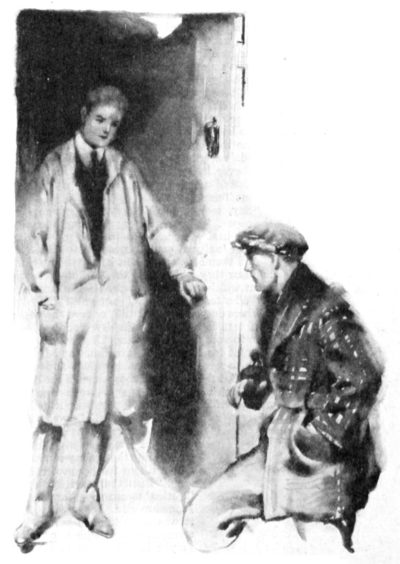
Jimmy stayed on with the Laidlaws a week, and after a day or two he joined Hartley’s gang, and after a week he insisted on finding a place of his own to live in. Steve knew a little old house of the sort that the early Connecticut farmer built round a chimney and that he thought might be cheap. He took Jimmy to see it. Jimmy was entranced at the idea of having a house of his own. But the owner did not wish to rent. She wished to sell.
“How much do you want for it, Mrs. Thorpe?” Jimmy asked.
“I’m asking fourteen hundred dollars,” Mrs. Thorpe said.
“I’ll tell you what,” Jimmy said, “I’m short of cash just now. But I’d like to buy it. Suppose you give me an option for six months at fourteen hundred dollars.”
Mrs. Thorpe nodded.
And in the meantime,” Jimmy continued, “you rent it to me for ten dollars a month.”
“Would you pay ten dollars a month?” Mrs. Thorpe asked.
“I would if you’d let me use the furniture,” Jimmy assured her.
So it was settled by the magic of Jimmy’s phrase, “option for six months.”
Everybody in the Deep Harbor crowd kept an eye on Jimmy and saw that he got a good dinner occasionally and never went really hungry.
And if Jimmy had had just enough talent for drawing to hang on in Hartley’s shop he might have become an illustrator and even have earned his living at it. But he hadn’t any gift for drawing. Hartley hated to admit it, but the Art Students’ League had been entirely right in its estimate of Jimmy. It was in January that he told Jimmy the truth.
And if Jimmy had been the unhappy young vagabond he looked he might have gone on, leaving his several debts behind him, and Deep Harbor would have known him no more, and nothing would have happened.
But Jimmy wasn’t that sort.
He couldn’t bear to treat Steve Laidlaw and his wife thus, nor Bill Montaigne, nor Joe Hartley, nor the Russells.
He spent three days pacing the floor of the little house, and thinking out a scheme by which he could repay them not only the money he had borrowed but the kindness he had received; and in the end he evolved a plan, which he mightily resolved to execute.
III
On Sunday morning Ann Laidlaw addressed her husband.
“Now what do you suppose this means, Steve?”
“What?” said Steve.
He did not even look up from the sporting page. “Listen.” And she read aloud from the classified columns in the Times:
“’For sale: Colonial house of six rooms with studio; more than a hundred years old. Four fireplaces, original quaint iron latches, and small-paned windows; the home of a painter; charming Connecticut village; unspoiled; artist colony; fifty miles from New York, on the Sound and river. $3,000. Golf club, express stop, peace.”’
“What’s that?” Steve asked.
“You didn’t listen.” Mrs. Laidlaw read the advertisement aloud again.
“Whose ad is it?” Steve asked.
“I don’t know. It says: ’Address RX2, The Times..’ But it must be somebody in Deep Harbor. We’re the only town fifty miles from New York on the Sound. But whose house is it?”
“Might be Millingham’s. He was talking last fall about moving nearer New York.”
“The Millinghams have talked about moving nearer New York every winter for six years. Besides, they’ve got seven rooms and two fireplaces. It might be the Binghams’.”
“Their house isn’t a hundred years old.”
“Well, whose is it?”
Steve got up and leaned over Ann’s shoulder and read the advertisement with his own eyes.
“Damned if I know,” he said.
“But, Steve,” Ann said, “we know every house in town that’s got a studio. We ought to be able to figure out what house this is.”
“And what if we could?” he said. “What difference does it make?”
“But, Steve, aren’t you interested?”
“No,” said Steve, “I’m not interested in any ad that calls Deep Harbor an artist colony. Deep Harbor is a Connecticut village.”
In the afternoon Steve got into his rubber boots and started out to find somebody to talk to. It had been a real winter and there was still enough snow to make walking necessary. Steve wandered down the road with no very definite objective. At the corner where the village street joined the Post Road it occurred to him that he hadn’t seen Jimmy Dowling for a week. He crossed the road and walked on toward the Thorpe house. As he approached it he noticed that the woodshed had been moved from its position behind the house and now stood almost beside it, one corner touching the northeast corner of the house.
“That’s funny,” Steve said to himself.
He knocked on the door. He waited three minutes without getting an answer. He had turned to walk on when Jimmy Dowling opened the door. He was wearing a fresh, not to say new, painter’s smock. Now whatever may be the convention in their illustrations, it is not the custom of illustrators to wear painters’ smocks in their houses. Indeed, the smock which incased Jimmy Dowling was the only garment of the sort that Steve had ever seen in real life. Steve eyed Jimmy with a growing disfavor. He shook his head.
“Take it off, Jimmy,” he said. “Take it off before anybody else sees you. It won’t go.”
Jimmy grinned uncomfortably. “I wouldn’t have put it on if I’d known it was you, Steve,” he paid.
He seized his skirt with both hands and, lifting them high above his head, removed the smock with a single gesture.
“Come into the studio and I’ll tell you about it.”
“Studio?”, said Steve. “I didn’t know you had a studio.”
“Well,” said Jimmy, “it was the woodshed, but I’m learning to call it a studio. I’m using it for a studio, and so I guess it’s perfectly honest to call it the studio.”
James led the way to the woodshed and Steve followed him.
“How’d you get this shed over here?” Steve asked as he entered.
“I got a couple of men to help me move it last week.”
Steve looked round. The most conspicuous object in the room was an enormous wooden easel with a canvas in place. The canvas had been painted black. There was a great shapeless splash of vermilion near the middle of it, but no man could have guessed what it was going to be. At least Steve couldn’t.
“What is it?” he asked Jimmy.
“Well,” said Jimmy, “I haven’t decided. It’s anything you please. Of course it isn’t finished.”
Steve looked at the painting with narrowed eyes. “No,” he said; “no, it isn’t finished.”
Against one wall was a stack of canvases. Steve advanced toward them.
“Those aren’t mine,” Jimmy said. “I just borrowed them.”
Steve paused. In the middle of one wall was a large Franklin stove. One leg had been replaced by a couple of bricks.
“Where’d you get that?” Steve asked.
“I found it in the attic.”
Steve sat down in one of those straight chairs that had once had a rush bottom, the sort of chair that is characteristic of New England kitchens.
“What’s the big idea?” he asked.
“Well,” said Jimmy Dowling, “I decided I’d just have to make some money.” He waved his hand at the room. “I’m going to sell this place.”
Steve looked puzzled. He didn’t understand how Jimmy could sell a house he didn’t own.
“I’ve been setting the stage a bit,” Jimmy explained, “but it’s perfectly legitimate, don’t you think?”
“But you don’t own it.”
“I’ve got an option on it until May first,” Jimmy said. “Don’t you remember?”
“Yes,” Steve said, “but I thought you had to pay about fourteen hundred dollars for it.”
“Yes,” Jimmy said. “Fourteen. hundred.”
“ Don’t you know that you will have to sell it for more than that to make any money?”
“Yes,” said Jimmy Dowling. “I intend to sell it for more than that. I intend to sell it for twice that. I’ve advertised it for sale at three thousand dollars.”
“Was that your ad in the Times this morning — that guff about a colonial house more than a hundred years old in an artist colony, the home of a painter?”
Jimmy blushed and squirmed.
“Well,” he protested, “I didn’t say a good painter, did I?”
Steve deliberately lit a cigarette; He didn’t know just why he resented that advertisement but he did resent it
“Was there anything the matter with that ad?” Jimmy asked. “Every word of it was true, wasn’t it?”
“That may be,” Steve said. “But if anybody comes all the way out here from New York on the strength of that ad and finds that there isn’t a plumb wall in the house and that your floors run up and down hill, and that you haven’t got running water, let alone a bathtub, they’ll be sore. ’
“I didn’t say the house had a bath, did I?”
“No,” Steve admitted; “you didn’t mention it.”
“I didn’t say the walls were plumb either. I said the house was more than a hundred years old. If it isn’t plumb that just proves how old it is.”
“Yes,” Steve said. “But you said the price was three thousand dollars. Do you think that anybody who sees this house is going to pay three thousand dollars for it?”
“Well,” said Jimmy, “that’s an asking price.”
“Asking!” said Steve. “Asking! Asking is good.”
“Steve,” said Jimmy, “you’re a corking illustrator. If I could draw the way you can for one year I’d give away the rest of my life and die happy. But on this real estate thing you just aren’t there. You don’t understand what makes real estate valuable.”
“No,” Steve admitted; “if this shack is worth three thousand dollars I don’t understand — I don’t understand it at all.”
“Let me explain it’ to you,” Jimmy said briskly. “You know how rents have gone up in New York, and all over the country, for that matter?”
“Yes, I have heard about that. I read the papers.”
“You know that there are thousands of people in New York who can’t afford to live there. They’re moving farther and farther out every year.”
“Yes,” Steve said. “But they aren’t moving to Deep Harbor. It’s too far.”
“It has been too far. But it won’t be too far much longer, the way rents are going in New York. Property in this neighborhood is going up.”
“Sure,” Steve said, “it’s going up. It’s worth ten per cent more than it was when we came here ten years ago, maybe twenty per cent, but not a hundred per cent. And a place like this is deteriorating. In ten years it’ll fall down. Why, fourteen hundred dollars is a high price for it. I wouldn’t pay that much.”
“But there are people nowadays who will pay more than that. You don’t seem to realize that there’s been a boom in old colonial. People go crazy over anything a hundred years old. Why, they’ll pay more money for a house like this than they would for a new one.”
“I know all about the old-colonial kind of thing,:’ Steve said. “Of course a piece of furniture that’s antique is worth money, even if it’s in rather bad shape. But it must be something that was elegant to begin with.
“A real old-colonial highboy may be worth a thousand dollars. We’ve got ourselves that we wouldn’t take three hundred for, even if Ann did get it for fifty. But you can’t get any more for a rickety old kitchen table than you can for a new one — not so much. And this house is in the kitchen-table class.”
“Surely — and it’s only three thousand dollars. Nobody expects to get a colonial mansion for that price.”
“No,” Steve said, “but he expects to get a roof that will shed rain, and windows that will open and shut, and floors he can walk across without going into low gear.”
Jimmy waved a tolerant hand.
“There’s another thing you don’t understand, Steve, and that’s what art does to real-estate values.”
“Art?” said Steve.
“Art,” said Jimmy. “Do you know the history of Greenwich Village in New York?”
“What about it?”
“You know that it was once a fine residence district, and then everybody moved uptown and values dropped and dropped and dropped, until it became almost a slum. And then artists went in there because they could get a whole floor in an old red-brick mansion for twenty-five dollars a month. Gradually they revived the old district, and the Sunday papers played up the story, and Greenwich Village became Bohemia.”
“Yes,” Steve said, “and all the nuts in the country flocked to it and ruined it.”
“That may be,” Jimmy Dowling said. “The point I’m making is that rents doubled and tripled and quadrupled.”
“Rents have gone up all over New York since the war,” Steve said.
“They doubled and tripled in Greenwich Village before the war, “ Jimmy countered. “And it was artists that did it. Just give any place in the world a name for being an artist colony and people will go there — people with money.”
Steve shook his head.
“That’s all very well, and it makes a good story, but I don’t believe it. I don’t think it was the artists who were the attraction. I think it was the houses. While Manhattan Island was getting more and more crowded the artists were improving those old houses; and when they were improved the pressure for a place to live had got too strong. People with more money gobbled up those houses.”
“Well,” said Jimmy Dowling, “why couldn’t that happen in Deep Harbor?”
“I dunno,” Steve admitted. “I just don’t think it will. And I think you had better be drawing than wasting your time on these childish schemes.”
“Hartley has fired me,” Jimmy said. “Fired you?”
“Yes; he said it was simply no use for me to keep on.”
“I see,” Steve said.
“And so don’t you think it’s perfectly legitimate for me to try to sell this house?” “Legitimate? Of course it’s legitimate. If you can get anybody to pay three thousand dollars for this house after he has seen it nobody has the slightest objection to your doing it. All I was trying to make you see is that you can’t.”
“Well,” Jimmy said, “I’m going to have a try at it anyway.”
Steve stopped at Hartley’s place on the way home.
“He can’t draw anything,” Hartley said.
“He just hasn’t got the stuff; he’s got all the will in the world but he just can’t draw. He’ll never be able to draw.”
“I suppose you’re right,” Steve admitted. He trusted Hartley’s judgment in this matter.
“It’s too bad,” Hartley said.
“Yes,” Steve said. “And the worst of it is that he can’t do anything else. He’s full of the wildest ideas.”
“He ought to be driving a truck.”
“He’s too much of a dreamer.” Steve laughed. “He’d be running into things.” Steve went home and told Ann all about it and when they had laughed over Jimmy’s absurd scheme for selling Mrs. Thorpe’s little house, so much the worse for age, for three thousand dollars, they fell suddenly sober.
“Steve,” Ann said, “I think we ought to do something for that poor boy. He must be terribly hard-up.”
“He’s so hard up that he’s gone a little bit crazy thinking about money.”
“Yes,” Ann said. “He probably hasn’t had enough to eat. People who go hungry get lightheaded.”
Steve was very thoughtful.
“Poor little devil. Hartley says he can’t draw. He’s never sold a picture in his life and he never will.”
“I’m going to get Katy to bake meat pies tomorrow,” Ann said, “and you can take two or three of them round tomorrow noon. That’ll mean he will get one good meal tomorrow, and I think you’d better give him some money.”
“I will,” Steve said.
Steve went round the next day. He paused as he approached Jimmy’s house. Steve wondered whether it had ever been painted. He decided that it had once been whitewashed. But it had now the color of wood that has been exposed to fifty years of New England weather.
Jimmy Dowling came to the door in his painter’s smock. It was no longer fresh. Indeed it looked as if it had been painted in for months.
“Hello,” Jimmy said. He took off the smock. “I put this damn thing on,” he added, “whenever anybody knocks, in case it might be a customer from New York. But of course as long as it’s you I’m glad to take it off.”
“How’d you get all the paint on it?” Steve asked.
Jimmy Dowling blushed.
“With a brush,” he said. “I thought it wasn’t realistic enough before.”
“I’ve got a meat pie Ann sent you,” Steve said.
“Fine,” said Jimmy Dowling.
“And,” Steve continued, “I — I — happen to be flush right now, and I thought if fifty dollars would help out.”
“Why,” Jimmy said, “I owe you fifty dollars now.”
“That’s all right,” Steve said. “I don’t need it.”
“Well,” said Jimmy Dowling, “I’ll give you a note for it — thirty days.”
“No,” Steve said. “You can pay me back when you sell your house.”
“All right,” said Jimmy Dowling. “I’ll be glad to get your fifty. I know where I can get a roomful of old furniture for that.”
“A roomful of old junk,” said Steve.
“You wait and see,” said Jimmy Dowling.
Steve took a small wad of bills from his pocket. He wished Jimmy Dowling were going to spend it for food, but it was not for him to say.
“There’s another fifty where that came from,” he said to Jimmy Dowling. “Just you let me know if you need it.”
“That’s awfully good of you, Steve, but I don’t think I shall need it — not if I sell the house anyway.”
Steve went home to discuss with Ann the possibility of finding a job for Jimmy Dowling.
“Do you think he’d take a job?” Ann asked.
Steve looked thoughtful.
“Maybe not now,” Steve admitted, “but he’ll have to do something pretty soon.”
IV
“For two weeks Steve was so busy with a rush job, illustrating a serial against time, that he thought very little about Jimmy Dowling. Ann noticed that Jimmy’s ad appeared in the Times on the first Sunday, but not on the second. She drew Steve’s attention to the fact.
“I suppose,” Steve said, “he didn’t have enough money to put it in again. An ad like that must cost five or ten dollars.”
Ann turned to the rate card and did some figuring.
“It cost at least nine dollars,” she said to Steve.
“Poor little devil.”
“We’ve got to find him a job,” Ann said. “Think what a state of mind he must be in, not knowing where his next meal is coming from.”
“Yes,” Steve said, “I know what state of mind he’s in. I’ve been there myself. I’ll look round and see if I can’t turn up something. The only thing is I hate to tell him I’ve found him a job. It’s just the same as saying that I think he can’t be an artist. And of course he thinks he can.”
“I thought Hartley told him he couldn’t draw.”
“I know,” Steve said. “But by this time he’s just persuaded himself that Hartley didn’t know what he was talking about. I know how it is. Lots of people told me I couldn’t draw.”
One evening just before dinner Jimmy came over. Steve sat down to talk while Ann went out to tell Katy to set another place at the table.
“Steve,” said Jimmy Dowling, “how much would you take for your place?”
“I don’t want to sell. It’s my home.”
“I know,” Jimmy said. “I didn’t ask you how cheap you would sell it. But suppose somebody came along and asked you to name your price?”
“ Why, I wouldn’t take ten thousand dollars for this place.”
“Well,” said Jimmy Dowling, “would you take twelve thousand dollars for it?”
Ann came in just then.
“You bet I would!” she said.
“Well,” said Steve slowly, “if I could actually get twelve thousand dollars I might fall. I hope I wouldn’t. But there isn’t any more chance of that than there is of your getting three thousand for the place you’re in.”
“I’m not in it anymore,” said Jimmy. “I sold it.”
“When?” said Steve Laidlaw.
“This week.”
“How much?” Ann asked. “Twenty-eight hundred.”
“What!” Steve cried.
“Twenty-eight hundred,” Jimmy repeated. “I made an even fourteen hundred dollars — less eighteen dollars and fifty-four cents for advertising.”
Jimmy produced a check book and a fountain pen.
“Here’s that hundred dollars I owe you,” he said, and tore a check out of the book. “I can paint for a year now, and nobody can stop me. I’ll have over a thousand dollars left after I’ve paid up everybody I owe.”
Steve and Ann stared at Jimmy Dowling.
“Who bought it?” they both asked at once.
“The nicest old maid you ever saw,” Jimmy said. “She told me it was the kind of place she’d dreamed about all her life. She’s going to put in a bath and a one-pipe furnace and flower boxes and live there the rest of her life.”
“I hope she’s going to put on some paint,” Steve said.
“No,” Jimmy said. “That’s one of the things she was most enthusiastic about. I hadn’t ruined the place with a coat of nasty fresh paint — it had the color that no painter could mix — the color that only Nature could give.”
Steve considered.
“Jimmy,” he said, “I hope you realize that you’re just plain lucky. You happened to find a woman who was crazy enough to want that house and who had the money to pay your price for it. Don’t gamble on finding crazy people with money.”
“Well,” Jimmy said, “I know I can’t draw but I do love to paint. If I can dabble in real estate enough to keep going, and spend most of my time painting, I’ll be happy.”
“Lightning,” said Steve cleverly, “never strikes twice in the same place.”
“Well,” said Jimmy Dowling, “I’ve rented another house, with an option to buy, and — well, you wait and see. I’ve got several things up my sleeve. And I do wish you two would keep this thing under your hats until I get a chance to spring my little stunt.”
“We won’t talk,” Steve assured him. “But I do wish you knew when to quit.”
On succeeding days there was a series of small teasing advertisements in the classified columns of the Times. They held out to the harassed rent payers of Manhattan the prospect of a happier way of life. They began with the time-honored question, “Why pay rent?” and concluded with alluring references to white houses and apple trees, but without describing any particular house.
Ann would not ordinarily have noted them. She read them now because her interest was up and she suspected Jimmy Dowling.
The last ad specifically described a house of nine rooms, in the colonial fashion, with a large studio and a view of the Sound, in an artist colony, at thirteen thousand dollars. Ann showed it to Steve on Sunday afternoon.
“Who has the nerve to put that price on his house?” Steve asked.
“It must be somebody we know,” Ann argued. “It says there’s a studio and it’s fifty miles from New York. Do you suppose it’s the Williamses?”
“They haven’t got any more view of the Sound than we have,” Steve said.
“We’ve got a view of the Sound,” Ann said roundly. “You can see the Sound from the hill back of the studio.”
“When there aren’t any leaves on the trees.”
“You can see it from our room, even in summer.”
“You don’t call catching a glimpse of the Sound from a second-story window having a view of the Sound, do you?”
“It is a view of the Sound just the same,” Ann said.
Steve got up and looked out of the window.
“You can’t see it from here anyhow,” he said.
Ann joined him at the window. As they gazed an automobile came to a plunging halt in the snow.
“Who’s that?” Steve asked.
Jimmy Dowling got out of the car. He was followed by a well-dressed man and woman of middle age. They began slowly to ascend the hill toward the Laidlaws’ front door.
“Good Lord!” Ann said. “They’re coming here, and you in corduroy pants and a blue flannel shirt, and me in a kitchen apron and the Sunday paper all over the living room!”
She flew at the room, piling up the Sunday paper, straightening the furniture, capturing a child’s toy. When the doorbell rang she disappeared upstairs.
“Hello, Steve,” said Jimmy Dowling. “Mr. and Mrs. Whittaker have come out from New York to look at your house.”
“Why — uh,” Steve gulped. “All right,” he said. “Come in, won’t you?”
They came in, they shook hands, they beamed upon Steve.
“I know your illustrations in the magazines,” Mr. Whittaker assured him.
“Yes, indeed,” said Mrs. Whittaker. “I think they’re perfectly lovely, but I never dreamed that I’d actually meet you. I’ve never met a real live artist before in my life. But even I can see you’re an artist just by looking at you.”
Steve stood on the other foot. He was not easily embarrassed among his own kind but he hadn’t learned how to accept the lay compliment gracefully, and he was entirely aware that he hadn’t. The fact that he realized his own ineptitude made it harder for him to think of something to say. But he found it didn’t greatly matter. It was unnecessary for others to hunt for words while Mrs. Whittaker was present.
She went into ecstasies over the fireplace with its warming oven; over the latches on the doors; over the wide oak boards of the floors in the second story. And then she insisted on seeing Steve’s studio. Steve hesitated. He was afraid Mrs. Whittaker was the sort who expected a place of Turkish rugs and old armor and Chinese curios. Steve’s studio suited him, but there was nothing arty about it, no more than there is in a carpenter’s shop. He was keenly aware of the pile of galley proofs containing the short stories he had illustrated and which he was accustomed to throw under the table as fast as he read them; of the rusty iron stove that heated the room; of the place about his chair, littered with pencil shavings and cigarette butts. Steve told himself he didn’t care what Mrs. Whittaker thought of his studio. He didn’t want to sell her his house.
But Mrs. Whittaker VMS not to be daunted by the studio’s want of elegance. “A-a-ah!” she said. “Now I have found a real studio — the workshop of a real artist. I’ve always wanted to know a real artist. I’ve always wanted to have a home that was an artist’s home. I’ve always wanted to sit in a studio in which real beauty had been born.”
Mrs. Whittaker turned to her husband.
“This is what I want,” she said. “Mr. Whittaker smiled amiably.”
“She usually gets what she wants,” he said to Steve.
Steve grinned weakly. Did these people really mean what they said or were they just talking? As they left, Steve reached out and collared Jimmy Dowling.
“What does this mean?” he whispered.
“Well,” said Jimmy Dowling, “I think they’re going to buy, don’t you?”
“Buy!” said Steve.
“Yes,” said Jimmy Dowling.
“But I don’t want to sell. Where would I go if I did? What did you tell them?” “Didn’t you read my ad — nine-room house with a view of the Sound for thirteen thousand? Of course my commission of five per cent has to come out of that, but if they buy you’ll get more than twelve thousand, and you told me you’d sell for twelve.”
“I hadn’t any idea that anybody would buy at that price. Didn’t I tell you I didn’t want to sell?”
“I’ll talk to you later,” Jimmy said.
“I’ve got to go along now.”
Steve stood watching Jimmy Dowling chaperon his clients into the car.
“Oh, Steve!” Ann cried.
Steve turned to her. Her face was aglow with hope. Steve regarded her glumly. “Ann,” he said, don’t understand you. I thought you loved this place — the thing we’ve spent ten years making. This house means more to me than any picture I’ve ever made or ever shall make. And
I thought you cared — too.”
Ann stood beside him and put her around his neck.
“You know I care, Steve. You know I love this place. You know I’m proud of it — busting proud.”
“Then why do you want to give it up?” “I don’t want to give it up.”
“Ann,” he said, “don’t lie to me. I could see it in your face — you want that thirteen thousand dollars.”
“Yes, I do — don’t you?”
“No,” Steve said grandly; “thirteen thousand dollars is nothing to me beside this house.”
“Steve dear,” said Ann patiently, “have you forgotten the Arkwright house?”
Steve sat down. Presently he lit a cigarette. Ann sat on the arm of his chair. Their eyes took on the gaze of those who see visions.
The Arkwright house had been built about the time George Washington entered on his second term as President. It was the perfect example of the colonial tradition — a large house-of beautiful proportions and matchless simplicity. You entered a hall baronial in size but intimate in feeling, a hall with its original floor of wide oak planks, its great fireplace set in a wall entirely composed of exquisitely made paneling. The rest of the house was like that, with a bedroom forty feet long, designed for use on occasion as a ballroom. And the setting was most perfect.
“Of course I haven’t forgotten it,” Steve said at last. “We talked about it for two years, but we knew all the time we couldn’t afford it.”
“We could afford it if we sold this place for thirteen thousand dollars.”
“Arkwright wants eleven thousand, doesn’t he?”
“Exactly,” said Ann. “Now do you see why I was excited over the idea of selling the place?”
Steve saw. What was more he began to feel Ann’s excitement. He wished he had been more gracious to Jimmy Dowling’s clients. He wished he had expatiated on the merits of his house. He could have told them about the garden. He could have shown them photographs taken the previous summer.
“Ann,” he said judicially, “they won’t do it.”
“How do you know?”
“It isn’t reasonable — thirteen thousand dollars for this house.”
“Why not?”
“Do you remember what we paid, Ann? Three hundred down and a mortgage for three thousand!”
“Oh, well,” Ann said, “we’ve practically rebuilt the place since then. What about the new wing, and the studio, and all the planting we’ve done? We’ve put in three thousand in improvements — at least.”
“At most,” Steve said.
“What about our work?”
“We did that for fun.”
“Of course. But we didn’t do it for the Whittakers. There’s no reason why they shouldn’t pay for it.”
They argued the worth of their house for half the afternoon, and discussed the possibilities of the Arkwright place for the other half.
About dusk Jimmy Dowling came in.
“They want to buy,” he said. He fumbled in his wallet. “Here, Steve,” he continued, “is his check for five hundred to bind the bargain pending the search of the title and that sort of thing.”
Steve looked at Ann and Ann looked at Steve and with a common impulse they both looked round their pleasant living room, with the mantel they had discovered on an abandoned farm in the back country, and the corner cupboard with its handwrought “H” hinges that they had found in a junk shop, and the oak settle that Steve had made out of planks from an old barn.
Jimmy Dowling shook the small strip of paper which meant so much more than the five hundred dollars it stood for — which meant giving up all this to a stranger.
“Here’s your check,” Jimmy repeated.
And into Steve’s mind there floated a picture of the Arkwright house, with the three great elms that shaded it, with its beautiful old living hall, with its bedroom that was a ballroom. He took the check, folded it without looking at it, thrust it into his pocket.
“All right,” he said grimly.
Jimmy Dowling rose.
“I’ve got to be on my way,” he said.
“But I hope you’ll come over and see my new house — it’s the old Wilkinson place.” Jimmy left. Steve paced back and forth.
Ann sat silent beside the fire.
“Are you sorry, Steve?” she asked. “Aren’t you?” he challenged.
“A little — but I know we’ll like the Arkwright house a thousand times better.”
“Sure we will,” Steve said. “And I’ll go down tomorrow morning and clinch the deal with old John Arkwright.”
“Let’s go over and see the Montaignes,”
Ann said.
The Laidlaws always went to see the Montaignes when anything happened. But on this night of nights the Montaignes weren’t at home.
V
On Monday morning Steve Laidlaw went down to Arkwright’s.
“I hear you sold your place,” John Arkwright said.
“Why, yes,” Steve said. “And I’ve come in to see you about yours. We want a place to live and we’ve always liked that place of yours.”
“I know it and I sort of felt I oughtn’t to do anything without letting you know. But it’s been three or four years since you and I were sort of dickerin’, and this chap sort of talked me off my feet.”
Steve sat down heavily.
“Have you sold it?” he asked.
“Well, now,” John Arkwright began, “I
wouldn’t say as I’d sold it. But I did give him an option.”
“Who?”
“Dowling,” said Arkwright. “He come in here a week or two ago with a story as how he thought he could sell it for a good price. He offered me a hundred dollars for a thirty days’ option at twenty thousand dollars.”
“Twenty thousand dollars?”
“Yep; twenty thousand dollars.”
“But you were going to sell it to me for eleven thousand dollars, John.”
“I know I was,” John Arkwright admitted, “and I would have, too; but this Dowling says property has gone up from fifty to a hundred per cent hereabouts.”
“It has, has it?’ said Steve.
“So he says. What did you get for your place, Steve?”
“Thirteen thousand.”
“So I heard,” said old John Arkwright. “And “ — he paused and lit his pipe and pressed the coals with a horny thumb” ain’t .that just about twicet what it was worth?”
Steve glowered.
“It’s more than I thought it was worth or I wouldn’t have sold.”
“’Course, ’tain’t your lookout what some fellah from New York pays,” old John Arkwright continued. “I suppose it’s worth it to him or he wouldn’t buy. Pshaw, I c’n remember when that house of yours sold for sixteen hundred.”
Steve walked slowly home. He was in no hurry to see Ann. Of course he had been a damn fool to suppose it was only his house that had risen in value as a result of Jimmy Dowling’s efforts. What would Ann say? He tried to think of a house in Deep Harbor that Ann would like. He was in a mood to buy anything that was for sale on the old Deep Harbor scale of prices. The Sherrill house might be for sale. It wasn’t such a beauty as the Arkwright
house but it was a fine old house. He decided to stop and have a look at it on the way home.
Steve had gone perhaps a hundred yards in the direction of the Sherrill place when he saw Bill Montaigne’s car coming down the road. Bill drew up.
“We were over to see you last night, Bill,” Steve said, “but you weren’t at home.”
“I wish I had been,” Bill said. “I might not have made such an ass of myself if I’d talked to you first. I sold our house.”
Steve flushed. “What?” he said.
“Yep. Twelve Thousand Dollars, cash.” Bill could not speak the words without a certain pride. But his face fell the moment he had spoken them. “We thought we’d take it and just go up the street and buy the Sherrill place. We’ve always liked it, only we never felt we could afford it.”
“And you found the price of the Sherrill place had gone up just as much as yours had?”
“They want eighteen thousand for it now!” Bill said.
“Didn’t you know that if your house was worth twelve thousand the Sherrill place would be worth eighteen thousand?”
“I didn’t think at all, Steve,” Bill admitted. “I wish I’d talked to you first. But I didn’t really have a chance. That young Dowling did it. He just brought some people out and I was sort of dazzled, I guess”
“I know how it is, Bill,” Steve said grimly. “I sold too.”
He repeated the details of the Whittakers’ visit and his talk with old John Arkwright.
Bill laughed.
“It’s nothing to laugh at, Bill,” said Steve soberly.
“No,” Bill admitted. “I’d like to wring young Dowling’s neck.”
“I’d like to have my house back,” said Steve. “I don’t dare go home and tell Ann the news.”
Of course he did go home and tell Ann the news. Ann burst into tears.
“It looks to me,” Steve said, “as if we’d have to leave Deep Harbor for good.” “Where’ll we g-g-go?” Ann sobbed.
The telephone interrupted Steve’s reply. It was Hartley.
“Do you know what has happened?” he roared. “That little shrimp of a Dowling has set this town crazy. Greenwood won’t renew my lease. He says he’s put the place on the market.”
“Why don’t you buy it?” Steve asked wickedly.
“He wants twenty-one thousand dollars for it.”
“It isn’t worth it,” Steve assured him.
“Worth it!” Hartley’s voice rose to a point that made the next sentence unintelligible over the telephone.
“Hartley,” Steve said, “I’m in the same boat. I’ve sold my house.”
“For how much?”
“Thirteen thousand.”
“You ought to be indicted!” roared Hartley.
During the week it developed that the
Millinghams and the Wilkies had given Jimmy Dowling options on their places, that Jimmy had already sold the Russells’ house, and the Binghams’, and the Williamses’. Real estate had jumped from one hundred to two hundred per cent in Deep Harbor. And even if the illustrator crowd had been willing to pay the new prices there weren’t enough houses to go round. The influx of half a dozen New Yorkers had created an actual shortage of desirable houses.
“I don’t understand it,” said Bill Montaigne. “How could prices change so much in two or three weeks?”
“The thing would have come sooner or later anyway,” Steve said. “Jimmy just happened to see it coming before anybody else did.”
“See it coming!” Hartley roared. “He hornswoggled us.”
Hartley was for. running Jimmy out of town on a rail. Bill Montaigne was for exploring the country three or four miles inland in search of cheaper houses.
“You know what the back-country roads are, Bill,” Ann said.
“We’ll improve them,” Bill announced. “We can go to town meeting and vote, can’t we?’
But a couple of trips into the back country over March roads disillusioned Bill. He dropped into the Laidlaws’ one night to report that he had to hire a team to haul out his car on three different occasions.
“You know,” he added, “this situation is really serious. We’ve got to give possession on May first and I can’t find a place to go. What are we going to do?”
“Let’s go and see Jimmy,” Steve suggested. “Let’s get everybody he has sold out,” Ann said. “I think we ought to put it up to him.”
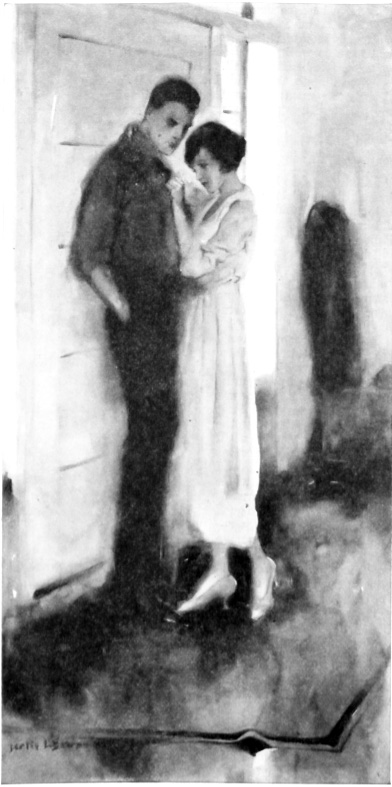
“What can he do?” Bill asked.
“He can’t do anything,” Ann admitted. “But he acts as if he had done us all a favor. I think he ought to know what he has done to us.”
They started out in Bill Montaigne’s car. On the way they stopped for Ethel. The Wilkies were out, but they collected Hartley and the Millinghams and the Russells and the Williamses, and, a party of a dozen in their cars, they drove over to the old Wilkinson place.
A colored maid in a white cap and apron opened the door. Jimmy wasn’t at home, but he was expected momentarily.
“Let’s wait for him,” Mrs. Montaigne suggested.
They filed into Jimmy’s living room and found chairs and examined Jimmy’s stage setting.
There was an ancient spinning wheel beside the fireplace; a pair of whale-oil lamps on the mantel; and a sea chest in the corner.
Ann Laidlaw pointed to the open doorway.
“Look at that,” she said. In the room beyond was the big easel that Jimmy had brought with him from the Thorpe house. Beside it, on a stand, lay a palette laden with all the colors that come in tubes. On a chair lay Jimmy’s smock. By these simple devices the Wilkinson back parlor had become a painter’s studio.
“You know,” said Bill Montaigne, “I think he’s clever. We’ve got to hand it to him.”
“I’ll call him clever if he can undo the harm he’s done,” said Hartley. “Can’t draw,” he muttered. “Never will be able to draw.”
Jimmy Dowling dashed in a few minutes later.
“Hello,” he said. “Won’t you all have tea?”
“We’ve come,” said Hartley, “to hear what you’ve got to say for yourself — and not for any tea.”
“Oh, come,” said Jimmy, “do have tea!” He shot out of the living-room into the kitchen to consult the maid.
“Now,” he said, when he had given his orders, “what can I do for you?”
Steve cleared his throat.
“You can tell us where we can get places to live — that we can afford,” he said. “None of us can stand the pace in this town since you began to advertise it.”
Jimmy leaned against the mantel and smiled engagingly at the dozen who confronted him. Steve observed that he was not the same Jimmy who had knocked at the studio door a few months back. He was no longer an unhappy boy looking for sympathy. He was a man who had found himself. And it wasn’t the new suit he was wearing, either.
“I’ve been thinking about your problem,” Jimmy said. “In fact I’ve found the answer.”
“What is it?” barked Joe Hartley.
“Old Port Orchard,” said Jimmy. He paused a moment. They must all know Old Port Orchard.
“Go on, son,” said Hartley. “What about Old Port Orchard?”
“Old Port Orchard,” Jimmy said impressively, “is probably the loveliest old village in New England. It’s thirty miles farther from New York. But it’s on the Sound, and it’s quite unspoiled. Real estate values are lower than they were in Deep Harbor before the — er — present boom.’
“Thirty miles farther!” said Bill Montaigne.
’What’s thirty miles to you?” Jimmy asked. “You don’t go to New York more than once a month.”
“But — “ Steve began.
“In my opinion,” Jimmy interrupted, “Old Port Orchard is a more charming place than Deep Harbor ever was. And if you’ll appoint a committee of one to go up there with me and look the place over I’ll undertake to manage the business end of it so quietly that there won’t be a tremendous jump in values.”
The white-capped maid brought in tea then, and Jimmy answered questions, and within an hour it had been agreed to send Ann Laidlaw with him to see Old Port Orchard. Only Hartley was unappeased.
“Look here, Dowling,” he growled, “what are you going to do? Are you going to settle in Old Port Orchard and pull this same stunt over again?”
“No,” said Jimmy Dowling. “I’m going to Massachusetts as soon as I’ve cleaned up here. I hesitate to mention it in this company, but there’s a man there who thinks he can make a painter out of me. He admits I can’t draw, but — well, he likes my color. Anyhow, whether I can paint or not I’m going to paint. I’ve got money enough to last me for two or three years. And when it’s gone I’ll make some more.”
It was Steve Laidlaw who asked the last question. He hung back as the rest said good-by to Jimmy Dowling, in order to ask it.
“Jimmy,” he said, “you told me that day you came to my studio how you hated your father’s business. What is his line?”
“Real estate,” said Jimmy Dowling.
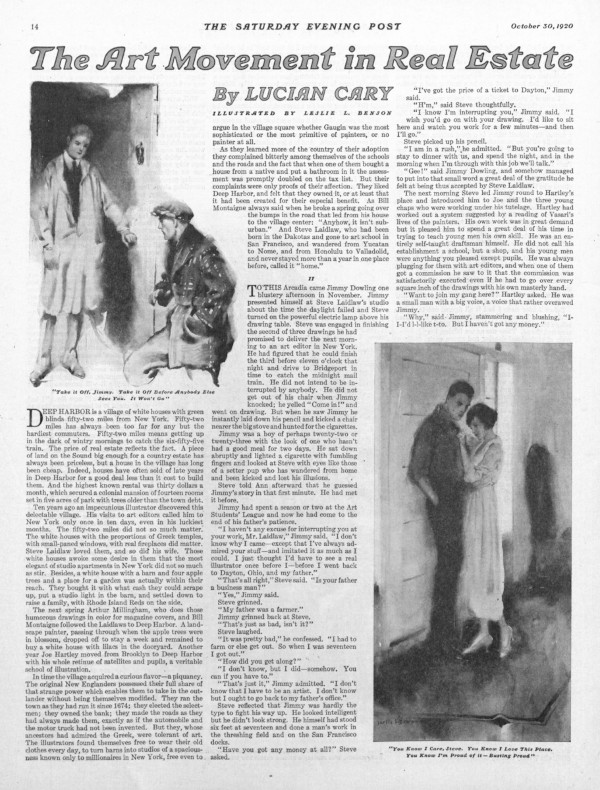
Illustrations by Leslie L. Benson/ SEPS
Rockwell Video Minute: Cousin Reginald
See all of the videos in our Rockwell Video Minute series.
Featured image: Norman Rockwell / SEPS
The Art of the Post: The Art of…the Refrigerator?
Read all of art critic David Apatoff’s columns here.
The first practical refrigerators were invented a century ago and instantly transformed American domestic life. The Saturday Evening Post was flooded with advertisements for the strange new devices. Illustrators were hired to help the public imagine how refrigerators would fit into a home and envision the role they could play. Some were more successful than others.
Inventor Fred Wolf of Ft. Wayne, Indiana started the rush in 1913, with the announcement of the first refrigerator for home and domestic use. A year later, an engineer in Detroit jumped in with his suggestion for an electric refrigerator, the predecessor of the famous Kelvinator. By 1918, the demand for the new invention had become clear, and the Frigidaire company was founded to mass produce refrigerators.
Rival companies popped up, each trying to outdo the others with features they thought the public might like. For example, Kelvinator touted the first refrigerator with an automatic control. Electrolux offered what it called the first “absorption refrigerator.” Inventors and engineers battled over the science. Here is a two-page ad from the Post bragging about the factory where the “hermetically sealed refrigerating unit” is contained within the “steel monitor top.”
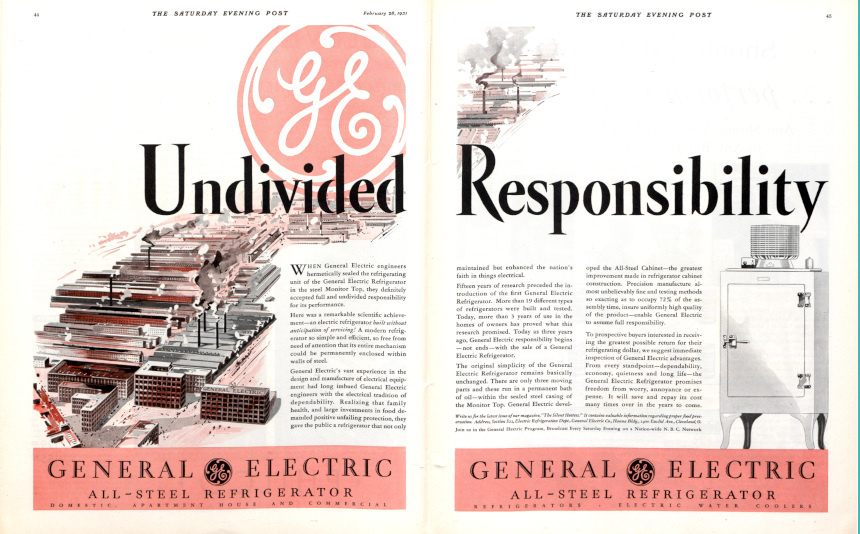
But it took art, not science, to humanize the strange new invention. Refrigerator companies faced a big challenge selling the new invention to everyday Americans; in 1922 a refrigerator could cost over $700 while a new car (the Model T Ford) cost only $450. The public wouldn’t buy refrigerators without a vision for how they would fit into the American lifestyle.
Here we see a 1929 painting by Walter Biggs of a high-class social event:
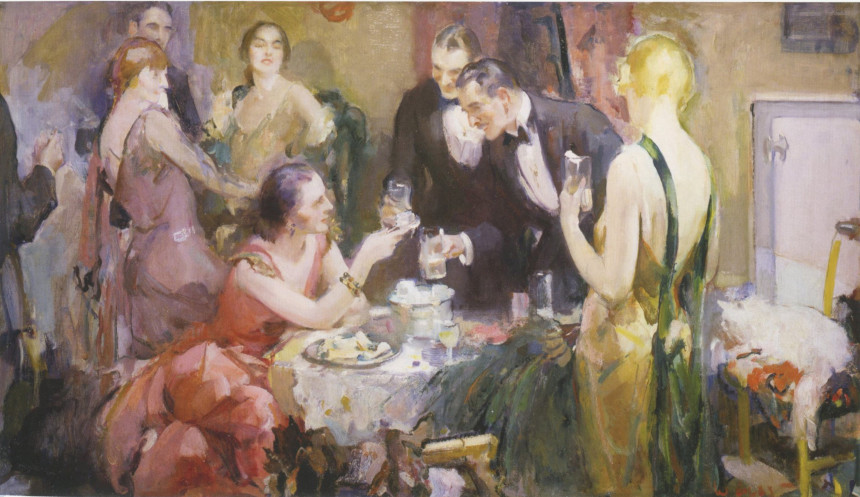
The men are wearing tuxedos and the women dressed in fashionable gowns. They smile as they exchange witty banter about cultural events. But the real star of the party—and the whole reason for the painting—is that brand new refrigerator in the far right hand corner.
Right smack dab in the center of the painting is the modern miracle… glasses filled with ice! Ice was readily available for guests for the first time with the invention of the refrigerator. Today we wouldn’t think of keeping our refrigerator in the middle of our dining room with the guests, but this picture tells us that it was a mark of prestige.
Next, this enterprising artist tries to portray the refrigerator as a springboard to romance. (Hah! Good luck with that!)
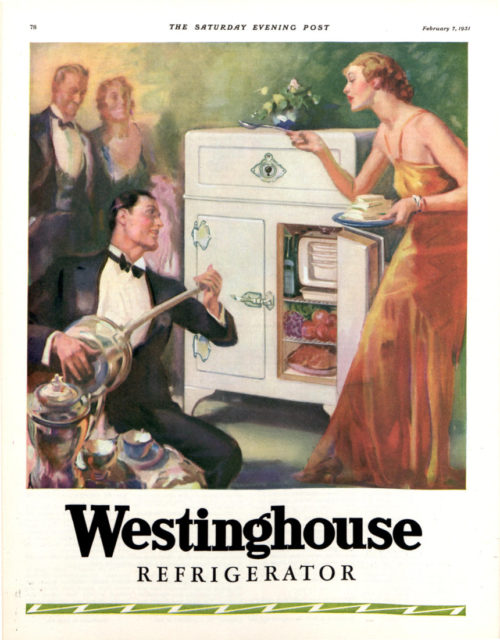
Another artist felt he could make the new invention popular with a “science fiction” approach:
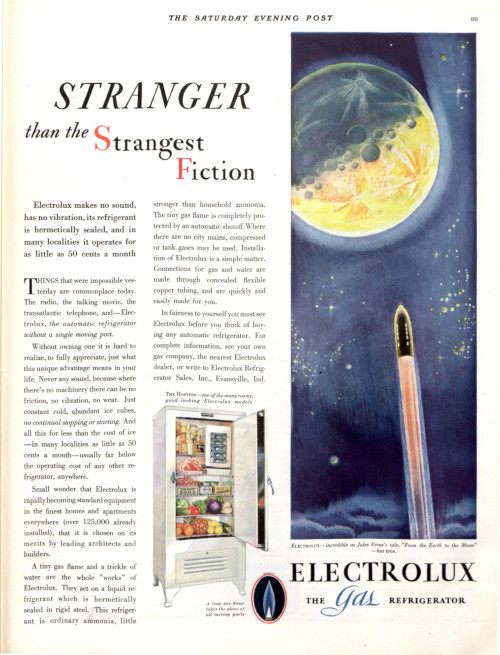
This artist does his best to make a white metal cube look stylish by making it a tiny element in a large, black and gold art deco picture. Note that Al Dorne’s harried, overworked housewife has become an elegant young woman of leisure in an evening gown.
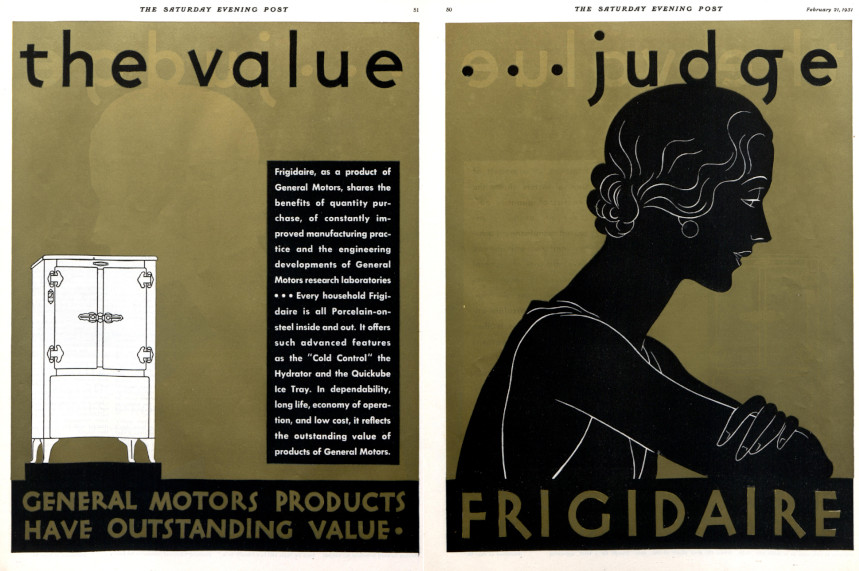
There were even illustrations for consumers who felt that a refrigerator was “like magic.”
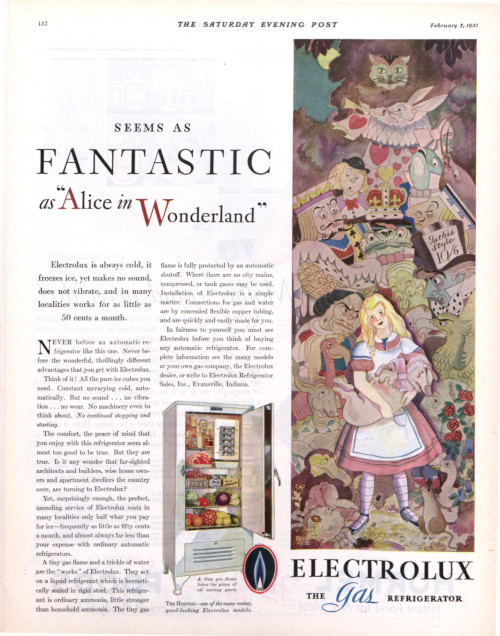
Today many of these approaches seem silly to us, but in the beginning before the identity of the refrigerator had been firmly established, artists could let their imaginations run wild.
It always takes a while for people to figure out the proper role for the new invention; when trains first arrived on the scene, they were noisy and frightening. They spooked horses and polluted the environment with smoke and cinders. But artists and musicians and storytellers began to humanize the new machine, singing folk songs and telling tales, and pretty soon we welcomed trains into our cultural heritage.
We rely upon the artistic imagination to help us view our strange new inventions and assimilate them into our natural world. Nothing like the refrigerator had ever existed before, so there were no precedents for artists to rely on. Some of the earlier efforts make us laugh today, but eventually illustrators found their footing.
Featured image: Courtesy of the Kelly Collection of American Illustration
The Art of the Post: Norman Rockwell’s Most Important Art Lesson
Read all of art critic David Apatoff’s columns here.
When Norman Rockwell was a young art student, he idolized Joseph Leyendecker, who he called “the most famous illustrator in America.” Leyendecker was a cover artist for The Saturday Evening Post, and painted more than 300 covers between 1903 and 1943. Rockwell dreamed of becoming a cover artist too, but didn’t know how he could ever paint as well as the great Leyendecker.
In his autobiography, Rockwell recounted how he spied on Leyendecker, trying to learn his artistic secrets:
I’d followed him around town just to see how he acted…I’d ask the models what Mr. Leyendecker did when he was painting. Did he stand up or sit down? Did he talk to the models? What kind of brushes did he use? Did he use Winsor & Newton paints?
Unfortunately, none of this information seemed to make Rockwell a better painter.
A few years later, Rockwell finally got to visit Leyendecker in his studio and watched first-hand the master working on a painting. It turned out that Leyendecker’s secret had nothing to do with his brand of brushes or paint. Rockwell recalled:
New Rochelle published a brochure illustrated with reproductions of paintings by all the famous artists who lived in the town. Joe worked on his painting for months and months, starting it over five or six times. I thought he’d never finish it.
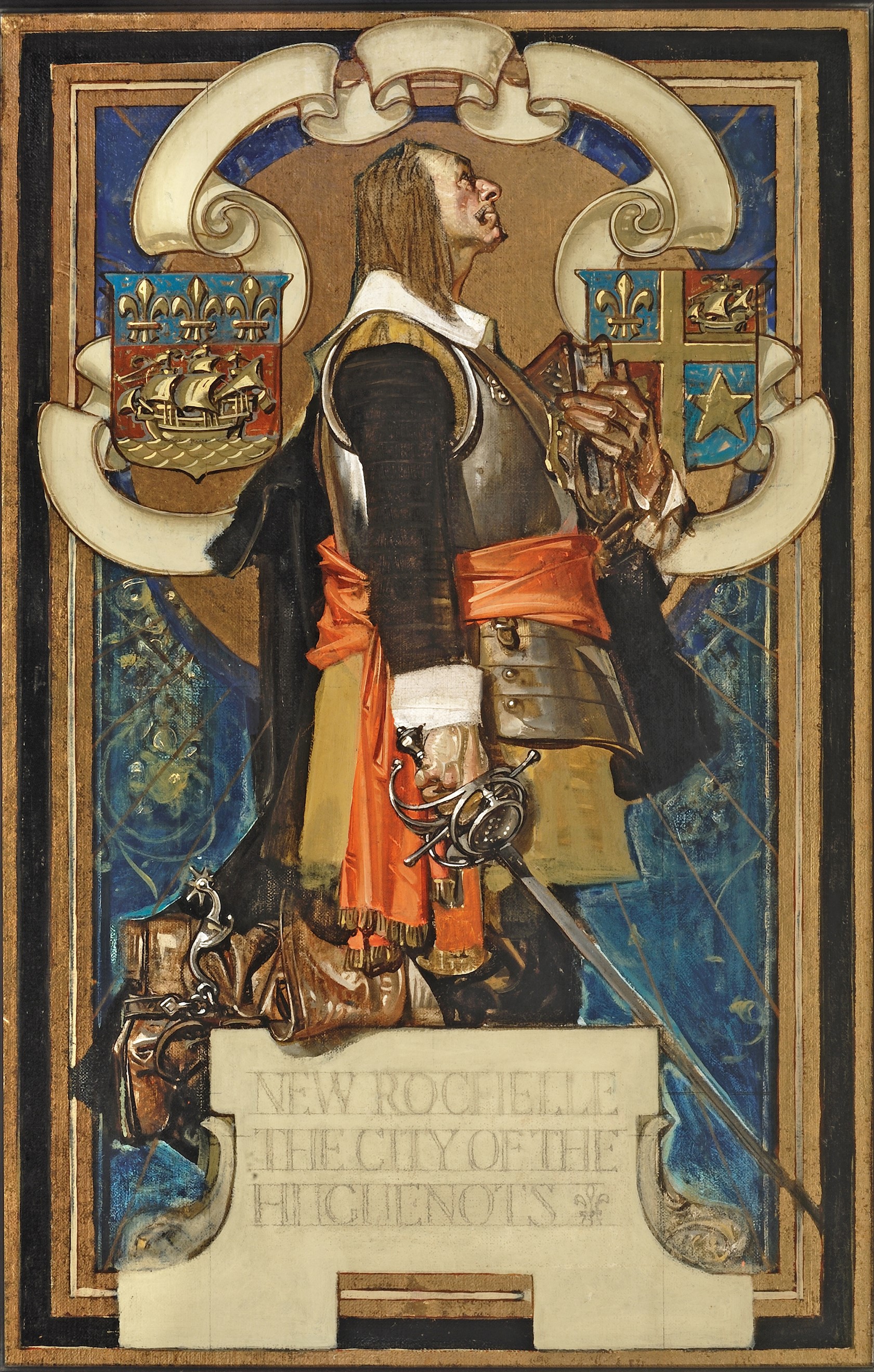
The painting that Rockwell saw on Leyendecker’s easel was beautiful, with many fine touches.
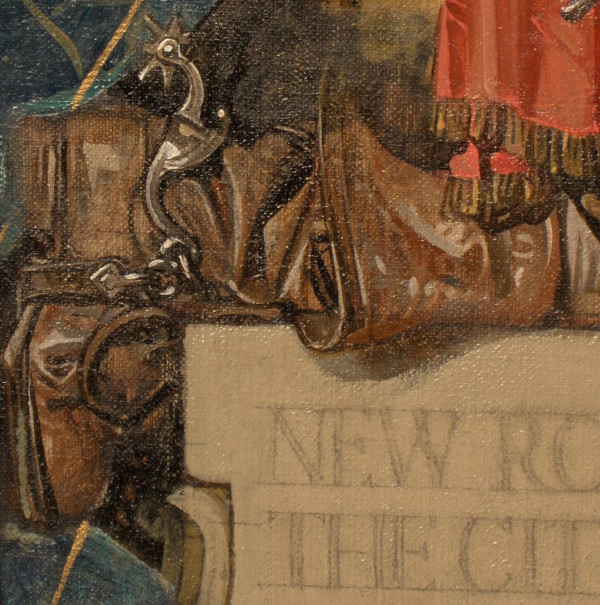
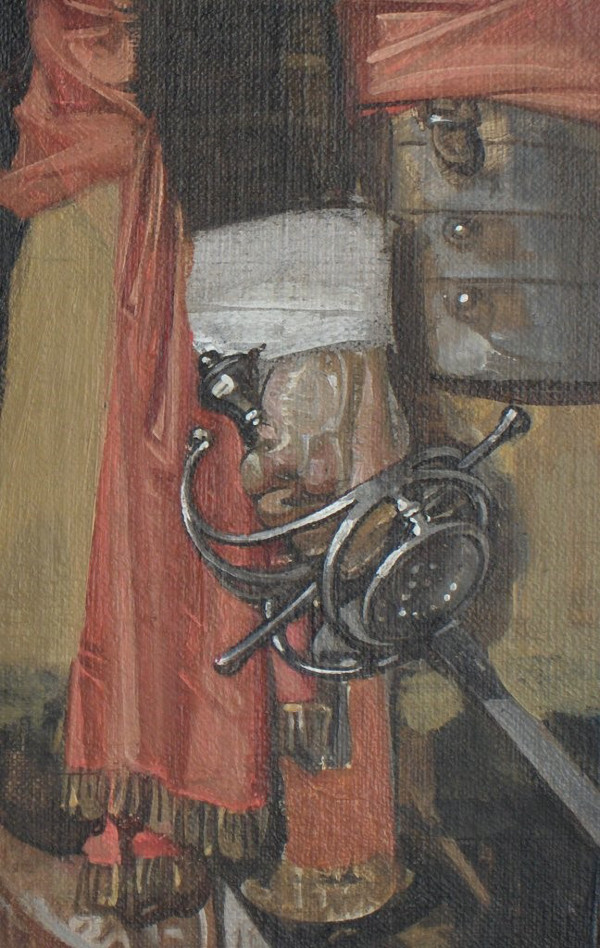
The painting was 95 percent finished and the client would have been happy to pay for it. All Leyendecker needed to do was finish this hand and a few other touches.
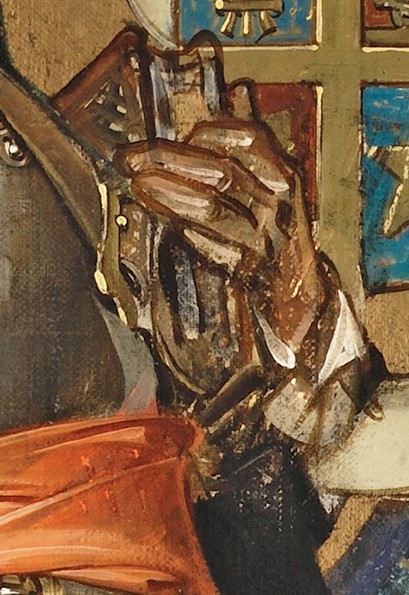
Yet, Leyendecker remained unsatisfied. The painting didn’t meet his high personal standards.
Rather than correct the parts he wanted to improve, Leyendecker set the entire painting aside and started all over again, searching for the exact image he envisioned.
Later, when Rockwell saw the final version published by New Rochelle, it looked like this:
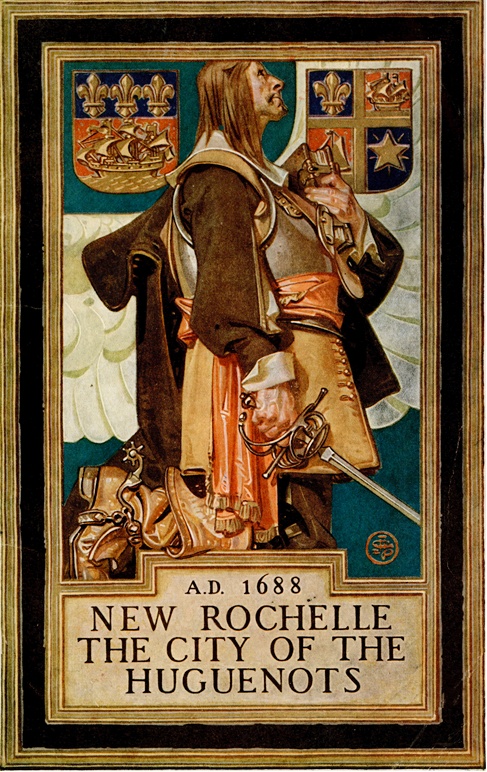
This gave young Rockwell a lot to think about: Leyendecker’s first version was perfectly acceptable; it just wasn’t 100 percent what it could have been. Leyendecker seemed to spend a lot of time starting over in search of that elusive missing five percent.
Leyendecker’s high standards made Rockwell nervous about showing his own work to the master. Rockwell wrote, “You never asked Joe…what he thought of your painting unless you wanted a real critique; he thought nothing of starting a picture over again.”
But when it was Rockwell’s turn to become a professional illustrator, it seems he had learned the lesson. He painted “100%” in gold at the top of his easel to remind himself never to give anything less. That philosophy kept Rockwell at his easel seven days a week painting countless studies in order to get the details right. If he’d been willing to accept 95 percent, Rockwell could’ve worked faster, made more money and spent more time with his family. But he learned the lesson of Leyendecker, and that’s why people still remember him and admire his work today.
Featured image: Painting by J.C. Leyendecker. Photo courtesy of David Apatoff
“Home-Brew” by Grace Sartwell Mason
With more than 80 short stories and eight novels, Grace Sartwell Mason’s thematically diverse work found many publications in the period before and after World War I. Though her fiction and criticism has slipped through the cracks of familiarity over the years, her story “Home-Brew,” about the secretive and adventurous family of a budding New York writer, was an O. Henry Award finalist.
Published on August 18, 1923
Content Warning: Racial slurs
“Of course, they’re all dears, my family,” said Alyse; “but as fiction material there is nothing to them; no drama, you know; no color; just nice, ordinary, unimaginative dears. They’re utterly unstimulating. That’s why I can’t live at home, and create. They don’t understand it, poor dears; but what could I possibly find to write about at home?”
She crushed down upon her hair, with its Russian bob, a sad-colored hat of hand-woven stuff, and locked the door of a somewhat crumby room over the Rossetti Hand-Loom Shop, where she worked half time for a half living. A secondhand typewriter accounted for the other half; or, to be quite truthful, for a fraction of the other half. For her father, plain George Todd, helped out when the typewriter failed to provide.
She then betook herself on somewhat reluctant feet to the nearest Subway. For this was her evening at home with her unstimulating family; and though she was fond of them all, her predominating feeling for them was a mixture of amusement, tender tolerance and boredom. Moreover, they lived in Harlem, which was a deplorable wilderness, utterly lacking in atmosphere and a long, long way from the neighborhood of the hand-loom shop.
In the Subway, miraculously impelled through the bowels of the earth, Alyse — or Alice, as she had been christened — refrained from looking at the faces opposite her. The Subway does something curious to faces. It seems to drain all life out of them; it strips from them their defensive masks and exposes the deep and expressive scars of existence. A secret and hidden soul comes out in each Subway face. But Alyse averted her eyes.
“Dear me,” she sighed, “how dull they are! Isn’t there any beauty left in the world?”
Her father and his chum, Wally, were just ahead of her as she came up from the Subway depths. They were wending their way to their respective homes, having come up from downtown together, as was their invariable custom. Alyse gazed at their middle-aged backs without seeing anything unusual about them. Just two plodding men, getting tubby about the waist, with evening papers under their arms, walking along, not saying much. But when they reached George Todd’s door they would look at each other, and the passerby might well have stopped and taken off his hat, as before something rare and soul-satisfying. For here was perfect peace in friendship.
But all they said was: “S’long. See you tonight, ol’ hoss.” Or, “See you t’morrow mornin’, Georgie.”
Alyse had heard the tale of her father’s miraculous reunion with Wally so many times that it meant nothing to her. It seemed that as boys they had lived within two doors of each other in a small New England town, and they had been inseparable. First thing in the morning and last thing at night they were whistling outside each other’s windows; they owned a dog in common; and when George had scarlet fever, Wally nearly died from anxiety. Then, at sixteen, life had borne them in different directions. Wally drifted finally to Alaska and George got a job in New York. For a time they corresponded, but after a while letters began to come back to George marked Not Found, and then in a roundabout way he heard of Wally’s death.
Although George Todd was happily married, with a growing family, he admitted that the world would never seem quite the same to him with Wally out of it. Then came the happening that convinced him there are mysterious and unexplainable things in the world, say what you like. He was coming home from work one night, walking from the Subway rather more slowly than usual and enjoying the spring twilight, when in some strange way his heart stirred. He remembered how on evenings such as this he and Wally used to play a game in which one tossed a ball over the house to the other and gave a peculiar call. The middle-aged George declared that all of a sudden he could hear this call, and wanting to fix it in his memory, he endeavored to imitate it by whistling its rather melancholy intervals.
And at his whistle a man walking in front of him suddenly whirled and stared at him. It was Wally — Wally, with a newspaper in his pocket and a bundle of shirts from the laundry under his arm. He had been living within half a block of George for two years.
When her father told this story to Alyse he always at this point gave her an affectionate poke.
“Now there’s a story for you, Allie. You write up about Wally being washed out to sea and given up for dead and working his way around the world, and finally settling down in Harlem right next door to his old chum. And that about the whistle. What was it made me think of that old call?”
Alyse would explain that it was coincidence, and coincidence was the lowest form of literary life. She was patient about it, but there was nothing stimulating to her creative imagination in Wally and that come-and-find-me voice he had listened to half his life. Still less was she stimulated by her father, George Todd, owner of a feed and grain business of the most eccentric instability. He was a dear, and she loved him; but she hoped as they all sat down to supper that he wouldn’t begin to joke her about her work or offer her the plot for a story.
It was a spring evening and the dining room windows were open to the two lilac bushes which Alyse’s mother had nursed for years in the narrow, sooty backyard. The room was filled with an unreal light, as if the air was full of golden pollen dust. And something else, invisible and palpitant, was in the air of the homely room, something not to be seen but only sensed. Some intense preoccupation a sympathetic eye could have noted in three of the faces around the table.
“Well, well, we’re all dressed up tonight,” said George Todd, unfolding his napkin. “Look at Miggsy, Allie. Won’t she knock somebody’s eye out tonight?”
Alyse looked at her young sister, Mildred, aged sixteen. Mildred blushed, fidgeted, pouted entreatingly at her father. She was a thin little beauty, with a soft cloud of corn-silk hair about her face. In her red mouth desire and wistfulness mingled. Tonight her eyes were stretched and brilliant. She twitched at the table silver and appeared to have no appetite.
“Eat your spinach, dearie.” Her mother’s eyes brooded over her tenderly. “I thought you liked it creamed.”
“I do, but — Goodness, mother, is that clock right? I must fly!”
“But there’s chocolate pudding for dessert, dear.”
“Now, Miggs, finish your dinner. Why be so fidgety?”
Mildred looked in desperation from her father to her mother.
“But I don’t want any dinner, please! I — I have to be there early. Please let me go now, mother.”
She danced from one foot to the other, the secret excitement in her eyes threatening to change to anger. She had spent most of the time since she came home from school that afternoon in front of her mirror, and she was now exquisitely polished, powdered and perfumed. From under the fluff of hair over each ear an earring of blue to match her eyes dangled.
Alyse disapproved of the earrings and of the general effect of Milly tonight. She made a mental note to speak to her mother about letting the child go out so many evenings. But beyond the earrings and the general overstrung and overdressed effect she did not penetrate. She made no attempt to interpret the secret excitement in her young sister’s eyes. The affairs of a girl of sixteen were too inane and foolish to be taken seriously.
At the table when Milly had gone flying up the stairs there remained Alyse, her father and mother, Eddie, twenty-one, and Aunt Jude. Alyse glanced around the table and suppressed a sigh. The monotony of the lives of her family sometimes oppressed her. Take her mother, for instance. She seldom went outside the house except to church or to an occasional motion picture with Wally and George. All day she did housework or looked after Grandma Todd when Aunt Jude was at work. She did not have a cook because of a queer passion for feeding her family herself. But when she had them all there in front of her, ranged around the long table, and she had put onto their plates the well-cooked, savory dishes they liked, she would sit, eating little herself, looking from one to the other with her slightly anxious, tender glances, while gradually an expression of peace and satisfaction stole into her face; and Alyse wondered what her mother was getting out of life.
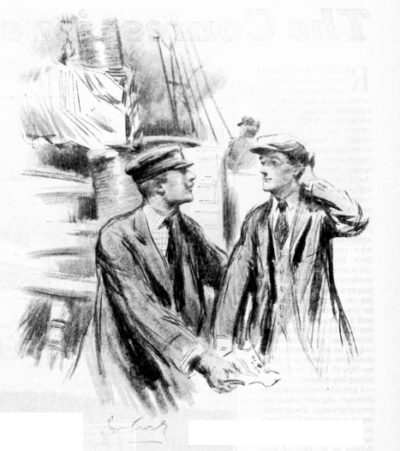 Take Eddie, also. No one, except perhaps his mother in odd moments, ever got a peep-in at Eddie’s thoughts. Alyse was of the opinion that he didn’t have any. There had been a time when she had tried to bring Eddie out by coaxing him down to her rooms over the hand-loom shop and introducing him to some of the girls she knew. But those clever and voluble maidens had abashed Eddie unspeakably, and Alyse had let him lapse back into his own plodding life. He apparently had no imagination. Soon after he left high school he had gone to work for a seed house downtown — George Todd badly needing help that year with the family expenses — and there he still was. Alyse hadn’t the slightest idea what were his amusements. Saturday and Sunday afternoons he generally disappeared, and when asked what he had been doing, he had been to a ball game or just taking a stroll around. He subscribed to a marine journal, which seemed strange reading for a packer in a seed house.
Take Eddie, also. No one, except perhaps his mother in odd moments, ever got a peep-in at Eddie’s thoughts. Alyse was of the opinion that he didn’t have any. There had been a time when she had tried to bring Eddie out by coaxing him down to her rooms over the hand-loom shop and introducing him to some of the girls she knew. But those clever and voluble maidens had abashed Eddie unspeakably, and Alyse had let him lapse back into his own plodding life. He apparently had no imagination. Soon after he left high school he had gone to work for a seed house downtown — George Todd badly needing help that year with the family expenses — and there he still was. Alyse hadn’t the slightest idea what were his amusements. Saturday and Sunday afternoons he generally disappeared, and when asked what he had been doing, he had been to a ball game or just taking a stroll around. He subscribed to a marine journal, which seemed strange reading for a packer in a seed house.
And there was Aunt Jude. Really, when you considered everything, what had Aunt Jude to live for?
Judith Todd was at that moment preparing a tray for Grandma Todd, who was having one of her faint spells and declined to come down to supper. With her long, slender fingers moving deftly, Judith made the tray inviting with the china she had bought especially for it. She had hurried her own supper so as to have plenty of time for the tray, and she moved from the table to the sideboard with the air of detached and ironic competence she sometimes wore when she was, as Alyse said, spoiling Grandma Todd. She was George Todd’s younger sister, thirty-eight, a spinster with the reputation of having been in her youth very high-spirited, adventure-loving, and moreover with a streak of queerness about her. As, for instance, her ambition to be a sculptor. In those days and in the Todds’ native village a girl might as becomingly have wanted to be a circus rider. It was said there had been some stormy scenes over days wasted in the attic with messy clay. But finally life itself had put a bit between her teeth — life and her mother’s well-timed heart attacks. Her father had failed in business and died, George had married early, and the brunt of taking care of her mother had fallen to Judith.
After a while she had brought her mother to George’s house, which helped George out with expenses and enabled Judith to make a living for herself. It was the nature of her job that convinced Alyse there couldn’t be anything in that old story about Aunt Jude’s having wanted to be an artist. It was such an absurd job. She worked for one of those concerns that produce novelties — favors, table decorations, boudoir dolls — designing many of these silly fripperies, often making them with her own hands. She had remarkable hands.
If she had an ounce of talent, Alyse decided, how could Aunt Jude go on, year after year, squandering herself on these silly and often grotesque objects? Alyse felt that it would have killed her to have so degraded her talent.
But Judith actually appeared to get a certain amount of fun out of the dreadful things. She would bring home samples of her handicraft and bedeck the supper table with tiny fat dolls in wedding veils, droll birds and beasts in colored wax, and so on. And in one of her high moods she could set the family to laughing with a single tweak at one of these grotesqueries. On these occasions a gay and malicious sparkle would come into her dark eyes, and her laugh would be high and reckless, rather like a person who has taken a stiff drink to ease up an ancient misery.
Two evenings a week she went out, no one knew where. Alyse had seen her once at the opera, leaning far out from the highest gallery, a frown between her brows, seeming to watch rather than to listen, with a wild brightness in her dark eyes. The general impression of the family was that these regular evenings away from home had something to do with her work. On these particular evenings there was always a breathless air about her. She would hasten in from the street, and as she climbed the stairs to her mother’s room her face would stiffen as if for conflict. For Grandma Todd resented these evenings.
“Traipsin’ off,” she called it. “Lord knows where. Something will happen to you, coming home alone after ten o’clock. I don’t think you’d better go out tonight, Judith. My heart has been fluttering this afternoon. If I have to lie here worrying all evening I shall probably have a bad spell.”
And then into her daughter’s face would come the expression of a person swimming painfully against the tide. Love and pity had overcome her at every turn of her life, until at last she had almost nothing of herself left, except her freedom for these two evenings. As if the call of them was more imperative even than her long habit of abnegation, she fought for them with a sort of desperation.
Tonight as she arranged her mother’s tray her fine hands trembled a little; she looked more than ever as if she were straining at a leash. There was an unusual color in her face, a sort of flame, which for an instant attracted Alyse’s attention. Aunt Jude, she reflected, must have been almost beautiful when she was younger, before the expression of half-defiant endurance came into her face. Her dark hair was still lovely, with its blue-black shadows. Over her brow was a white lock, which she took no pains to conceal. She wore it rather like a defiant banner, and it went well with a certain gallant air she sometimes had.
As soon as supper was finished the family began to melt away. Wally called for George Todd and they went out. They admitted, grinning, that they were going to an express-company auction of unclaimed packages. It was one of their pet forms of entertainment, and they frequently brought home queer bundles, which they opened with shouts of amusement. Alyse thought they were dears, but rather foolish. She could not guess that when they started out of an evening arm in arm they became boys again, and forgot that life had been a somewhat niggardly affair for them.
A moment later Miggs made a dash for the door, pulling on her long gloves. Her face was flushed and exquisite under her modish hat.
“I’ll have Eddie come around to Jane’s for you, Milly,” her mother called to her.
A shadow of fright and annoyance came over Miggs’ face.
“No, please don’t, mamma. Jane, or somebody, will come home with me. Besides, we — we may go to a movie. Don’t fuss over me, mamma. I’m not a baby.”
Then she darted back into the room, caught her mother’s head in her slim arms, snuggled her little powdered nose into her neck.
“Oh, mamma, I’m all right. I’m just so full of pep tonight I’m — I’m snappy. Don’t you worry, darling.”
And licking her scarlet lips, glancing once more into the mirror of the old-fashioned sideboard, she was off — a hummingbird caught in a mysterious gale.
Then appeared Aunt Jude, her jacket over her arm, the tray in her hands. Her dark eyes were feverishly bright, but her face looked pale and strained. Would they mind just cocking an ear now and then toward mother’s room? She would probably drop off to sleep soon, though she had made up her mind she wouldn’t.
“But I must go tonight,” she said; “just tonight. Perhaps after this I — won’t be going out Tuesday and Thursday evenings.”
She stood still, staring down at the tray she had put on the kitchen table. Then she threw up her head with the familiar defiant movement, made a sound as if of scorn at her own weakness, and shrugging herself into her old blue serge jacket, she, too, darted out into the evening.
Eddie stood by the window. He stooped to look up at the dark blue of the night sky — a gesture habitual with him — fiddled wistfully for a long moment with the shade, and then pulled it down as if resolutely shutting something out. But a moment or two later he took his hat down from the hall rack, muttered to his mother “Be back early,” and slid out the front door, as if suddenly afraid of being late for something.
The house fell silent. Alyse’s mother put a dark-red spread on the dining-room table and placed her darning basket under the light.
“Now this is cozy,” she said happily. “We’ll have time for a nice visit. Tell me about your work, dear. I’ve been hoping maybe you’d feel like coming home to stay as soon as you’d got some material to work on. Of course, I understand,” she added humbly, “you have to have something to inspire you.”
“That’s exactly it, mother. I must know interesting persons. It’s very important to be stimulated. Sometimes I’ve thought that if I could only go to Russia or Austria or some place where there is a sense of crisis, a — a vividness, you know; strife of souls. That’s what I want to study. You see, mother? And, of course, here at home — ”
Her mother sighed.
“I know we’re all pretty ordinary, and nothing much happens, here at home.”
She looked apologetic, as if she realized the family’s limitations and wished she could offer something more interesting to her talented daughter. She dropped the old darning egg into the heel of a sock. The homely house was very quiet.
And a few miles farther south Milly was running breathlessly up the Subway stairs, an eager, half-frightened Proserpine coming up from the bowels of the earth into flowery meadows, into the glare of the electric flowers of Broadway.
And a few blocks north Judith Todd stood in a dark doorway and whispered: “I mustn’t hope for anything. If nothing comes of tonight, I can go on. But, O, God, make something come out right for me at last, at last!”
And Eddie —
At about this moment Eddie’s mother was rolling a pair of his socks into a neat ball. She sighed unconsciously.
“Sometimes it seems to me,” she said, “as if Eddie has never really waked up. I can’t express it the way you would, Alice; but as if he was driving himself — dumb, you know.”
“Doesn’t he like his job?”
“I don’t know. He never says. But sometimes he looks — And then there’s that Haskins girl. I’m afraid he’s let her push him into being engaged. I wish I knew — he’s so silent lately … When he was a little boy he used to lie on the floor by the hour, so happy, drawing pictures of ships.”
Ships! Alyse had never noticed them, but they lay like a fringe about the tall city, slowly rising and falling with the tide, lying there waiting to be unloosed to the seven seas. But Eddie knew they were there. All the miles of wharves he knew, from Sunday and evening rambles, from noon hours when he went without food to stand looking at some lovely visitor from an unknown port. And now at this moment he was making his way as fast as he could to say farewell to one that had become the very core of his heart.
More eagerly and more swiftly than he ever had made his way to the Haskins girl he traveled toward the North River. Just before he reached the corner beyond which he could look down upon the river he felt his heart grow cold with the fear that sometime during the day she may have slipped out to sea. It seemed to him that if she had gone he could not bear it; and yet he told himself that tomorrow night she would not be there; they had begun to ship her cargo.
But when he had rounded the corner, there were her masts against the deep blue of the night sky — five masts, the beauty! He had seen them two weeks before one night when he was leaning over the wall of Riverside Drive, and his heart had leaped. He had made his way down to the wharf alongside which the schooner lay, and stood there studying her, feasting his eyes on her. The tall cliffs of houses towered above her, but she smelled of many cargoes and of the sea. He could imagine her furled canvas slowly shaking out to the breeze, the deck tilting. The mate had come up on deck with his pipe and talked to him over the side.
Next evening Eddie was there again, and the mate invited him on board; he talked about the schooner as a man might about a wife whose very faults he loved. And Eddie had asked him questions which had been storing up in his heart since he was a boy. He could talk to this man Jennings, for they had a passion in common. Evening after evening they leaned over the deck rail or sat in the cabin, smoking and talking, and a deep friendliness developed between them.
Tonight when Eddie came to the edge of the Drive he did not hurry down as usual to the wharf where the schooner was tied up, but stood looking down at her. In his brain there was a misery and a battle. They were working overtime down there, loading the last of a general cargo, and that meant they would take advantage of the first tide. Tomorrow she would be gone, off to the River Plate. He shut his eyes hard and gripped the wall against which he leaned.
Tomorrow he would go downtown as usual in the Subway, and all day long he would be nailing up boxes in the basement of the store, and in the evening he would go around to see Lily Haskins. Under his breath he uttered a sound between a groan and an oath. He felt bewildered when he thought of Lily. He gazed at the five masts against the sky and they were like a shining vision beside which Lily Haskins was but a dull unreality. Was it actually true that he was going to marry, to go on all his life nailing up boxes as if they were his own coffin?
His feet carried him slowly down toward the wharf. He must say goodbye to Jennings, no matter how much he shrank from going on board the schooner again, and as he went down the long stairs he was wondering at the stupidity of his own life. Why hadn’t he talked things over with someone? Perhaps someone else could have told him whether he was really obliged to marry Lily. But he guessed that he had always been dumb. Life had gone on within him, half alseep, in the dust of the packing room, until he and Jennings and the schooner became friends.
And after that he had awakened, but he was still dumb. Perhaps if years ago he had begun to talk about what he wanted to do — But that year when he was eighteen, and making his secret plan to join the Navy, was the year dad’s business was so poor. He couldn’t desert him when he was so hard pressed. Perhaps later, when dad had got on his feet, he might have broken loose, if only he had believed in his dream; if he hadn’t been afraid of being laughed at.
His thoughts went still farther back, to the days when he used to cover immense sheets of paper with pictures of ships, full-rigged, with each detail as correct as he could make it from pictures he had seen.
He remembered looking up one day from his drawing with a sudden vision in his heart and crying out, “When I grow up I’m going to be a sailor!”
And someone, he could not remember who, had laughed. For a long time they called him Yeave-Ho. The door of his heart through which this cry had gone out had closed.
If he had cared less about his dream, the door would not have closed so tightly, perhaps; or if there had been anyone in his world who did not regard the sea as merely a blue blur in a geography.
Well, if a man was a sensitive fool, he had only himself to blame. He closed his lips more tightly and went on down the wharf. Two fellows passed him with bundles over their shoulders. The crew was going on board. In the light of torches the last of the cargo was being hustled on board. The light streamed upward and touched the masts; the vessel moved slightly with the tramping of feet and the lifting of the tide. With the lights, the shouting and movement of men, the schooner seemed to rise on tiptoe, eager and expectant.
In a shaft of light stood Jennings, checking off the crew as they came aboard. Down the wharf came the captain, a man behind him carrying bags and bundles. As soon as he climbed on board, Jennings could be seen showing him a telegram, and the captain frowned. Eddie, his habitual diffidence overcoming him, shrank back into shadow; but presently when the captain had gone into the cabin, Eddie moved over to the edge of the wharf and called, “Goodbye, Mr. Jennings! Just thought I’d come down to wish you — wish you — ”
But before he could finish, Jennings leaped and grasped his shoulder.
“Eddie! By cricky, boy, you look good to me! Look here!” He waved the telegram under Eddie’s nose and dragged him on board. “Look here, it’s Providence sent you down here just now. Petersen’s in hospital. We’re short a hand. My boy, it’s your chance! You’ll never have a better one. How about it? You’d have time to get your dunnage. Le’s see — tide will be right in two hours and fifteen minutes; all the time in the world. What say?”
The night reeled and rocked around Eddie.
“Tonight!”
The mate drew him forward, whispering, “Look here, you know as much about a vessel now as Pete ever did. You were born for the sea, and that’s the truth. This is your great chance to get your apprenticeship — good captain and a dandy vessel.”
Eddie stared about him while his heart pounded. He looked down the long lines of the schooner, he heard the masts faintly creaking and whispering in the rising wind, he smelled the unforgettable smell of a ship, and he choked with longing. He thought of his mother, but not at all of Lily Haskins. Could his father do without him? Would they all think he had gone crazy? Would they laugh? And at that instant the wind ruffled the water, the smell of the sea came stealing up the river, and the deck rose under his feet, an imperceptible movement to anyone not tuned to the sea. But to Eddie it was as if his heart itself turned over. His heart was like a seed, long buried in the dark and cold of the earth, which has been pushing blindly upward, and now at last sees the sun. His hand on the smooth curve of the mast tingled and drank in the feel of the ship, while into his soul there poured a new steadiness, a clean new certainty. His dumb boyhood was over and his beloved was under his hand.
Alyse yawned and her thoughts came back from her novel about Russia as her eyes fastened themselves on the chiffon stocking her mother was carefully mending.
“Really, mother, it’s ridiculous the way Mildred dresses. And ought she to go out every night? When I was sixteen I didn’t want to do anything but read.”
Her mother smiled and sighed.
“I wish to goodness Milly would sit down at home with a book. But she says life is so much more exciting than books. She told me the other day that she had to live her own life.”
“Life!” Alyse laughed scornfully. “That baby!”
It was at about this moment and several miles farther downtown in a dancing place called Poppy Gardens that Mildred, the baby, was on the verge of learning something about life. She was also being called an infant, but in quite a different tone.
“I’d jus’ soon tell the world,” said Dion Delanoy, holding her closer, “that you’re some little dancer, baby.”
And at the half-lazy, half-insolent caress in his voice, Milly thrilled with rapture and with discomfort. But it was very queer — there seemed to be two of her. One was intoxicated with delight and wonder, and the other held herself cool and aloof and, looking on, curled her lip. Overhead in the ceiling electric bulbs were stuck like pins in a cushion. When you tilted your head back so that your cheek touched your partner’s shoulder, all these lights reeled and swam after you around the room, and the floor undulated in long flat waves. When you floated through the green spotlight, Dion Delanoy’s eyes, like large shoe buttons in an ordinary light, became queer and sinister. When at the other end of the room the red spotlight washed over you, his pale dusky skin with the blue tinge from shaving had a bloom like an exotic fruit, and he became beautiful; he became what she had come out to meet, a romantic hero.
And she had reached that brief, glamorous season when there must be a hero to worship or one goes hungry and thirsty. When she had seen him in a bull fighter’s costume, with the footlights performing their nightly miracle with him, her hunger had fed itself upon him. Jane Tremont had been almost as bad, but it was her note he had answered, and she alone whom he had invited to meet him in the Peacock Alley of a Broadway hotel. It was Fate, his choosing her and not Jane, and it could only mean that they were meant for each other.
Having only just begun to learn about life, Milly didn’t suspect that the trysting spot Delanoy had chosen could be neatly overlooked from a balcony, and standing here, he could scrutinize his latest conquest and decide whether or not he cared to keep the appointment. He had been a bit taken aback by Milly’s youth, but it happened to be a dull evening. And besides, in the dressing room, heavy with the odor of stale powder, Milly had used a forbidden lip stick. He could not possibly know that in spite of her desirous lips her heart was pounding with fright.
But now, since they had danced for half an hour, fright had given place to this queer mixture of emotions; elation, dizzy wonder — she, Mildred Todd, dancing with a famous dancer, or at any rate a nearly famous dancer — hadn’t he had a dance practically alone, with the spotlight once directly on him? — and a curious undercurrent of vague unhappiness, as if already she had said good-by to someone she had shrined and now had lost. And those two individualities into which she had divided, the one whose lip curled sometimes, who looked on, not happy and yet not unhappy — homesick, rather — and the other, confused, ecstatic and silly.
“I feel funny,” thought Mills, “and nothing is quite like I thought it would be.”
Then the next minute she thrilled when someone behind them said “That fella’s Dion Delanoy.”
They had iced drinks at a sloppy table in a room off the dancing floor. He poured something into her glass from a flask, under the table. She became dreadfully sleepy and wished she were home and in bed. Then the lights around the dancing floor grew suddenly brighter and danced, and everything was gayer. Dion Delanoy became again a hero, and she knew that she herself was very wicked and beautiful. The cool half of her gave her lips one final curl of scorn and retired to an immense distance. The vague ache of disillusion left her too. She saw herself engaged to Dion Delanoy, giving a theater party in a box, and afterward taking Jane behind to meet him. He was her hero. He was marvelous. She clung tight to this thought, as if she knew that once she let it go she could not stand him.
And they wandered down to the street and into a taxicab. The drive was a flash and blur of lights, with Dion Delanoy holding her uncomfortably close. The taxicab increased her sense of wickedness, and she thought of a word she had recently added to her vocabulary — “insouciance.” She was convinced that she had a great deal of it, and as for Dion Delanoy he was magnificent with it. If only the cool and critical half of her would drop behind, and take with her the dim sense of sadness that was so oddly like homesickness.
“Wouldn’t it be perfectly terrible if I should cry?” thought Milly.
The cab stopped in front of a studio building.
“Friend of mine let me have his studio,” murmured Delanoy vaguely. “Let’s go up and start the phonograph.”
Milly hung back.
“I — I ought to go home. It’s getting late.”
He laughed at that, without any particular merriment in his watchful eyes.
“Aw, baby — that’s what you are, a baby.”
There was no taunt that could have hurt Milly more deeply. She looked up at him pleadingly, when an incident, small but important, as many small incidents are, occurred. Two markedly elegant young women approached and passed, perfuming the air. They bowed and smiled at Delanoy. He swept off his hat with a gesture nicely combining hauteur and suavity. In the light from the apartment-house doorway he looked for the first time that evening as she had seen him on the stage.
“Evelyn’s looking all to the good tonight,” he said, gazing after the two young women with a careless appraisal.
“You don’t mean Evelyn Beverly, of the Follies, do you?”
“Sure,” he replied, rather too quickly; “old friend of mine. She and I was dancing up here in Jack’s studio last night. Come on. Don’t pretend you’ve never been out after dark before. That kind of bluff makes me sick.”
She felt a desperate necessity not to displease him, this godlike being so handsome as he stood frowning down at her. And she would die rather than let him think her less endowed with insouciance than Evelyn Beverly. Meekly, with her lips parted childishly and her flower-blue eyes very wide, she followed him to the elevator.
In spite of Alyse’s contempt for coincidence, it does happen in life. For instance, there was the sprig of lilac in the buttonhole of the negro elevator boy. As Milly stepped out of the elevator this bit of flower, stuck so casually in a buttonhole, sent a sort of message to her brain. On the supper table at home that night there had been a sprig or two from the bush in the back yard. Her mother had always been foolish about that bush, coaxing it, feeding it, ever since Milly could remember. And now the perfume of lilac acted like a reagent in Milly’s subconscious mind. As she watched Dion Delanoy searching his pockets for his key, bending over the keyhole, it was as if her vision for the first time that evening was quite clear.
And nothing can be more merciless than a young girl’s scrutiny. Milly saw the ignoble back of his head, his hair sleeked back with pomade, a slight sprinkling of dandruff on his coat collar, the pinched-in waist of his coat, his commonplace hand, not too clean. He smelled slightly of the barber shop and of toilet water.
She was kept waiting only a few seconds, but in this interval a romantic hero died. liked his necktie. She had a sudden, furious distaste for this cheap stranger, and her heart ached too. She wanted dreadfully to be at home. But she felt helpless; she couldn’t think what to do next or how to get away. Delanoy had at last got the door open. He opened it, turned to her.
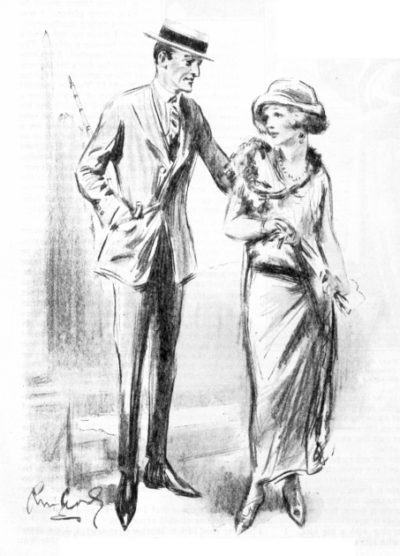 And at that instant behind a door at the end of the short hall a woman laughed low and happily.
And at that instant behind a door at the end of the short hall a woman laughed low and happily.
“Why,” exclaimed Milly, “that sounds exactly like Aunt Jude!”
Judith Todd, when she had left the house and her mother behind her, became as usual a thing with wings on her feet. She flew toward the Subway entrance, her dark eyes eager, her chin outthrust, her tall figure leaning forward as if the waiting to get there was intolerable. Sometimes she took a quick and happy look up at the sky, as a girl may who is hastening to meet a lover.
At Columbus Circle she came up to the surface and walked quickly across to a certain somewhat shabby studio building. Usually she could not reach it quickly enough; but tonight she passed the door twice, and finally stepped into the shadow of another doorway to have it out with herself. She told herself that tonight was not different from any other Tuesday or Thursday night, and she was a fool to be so excited. But all day it had hung over her, a prescience that this was the most important hour of her life. She longed for it and she dreaded it terribly. If it brought her disappointment, it would be no ordinary disappointment; it would mean the death of something in her without which her life would become merely an existence — hope. Tonight she realized that she had never really lost it — hope — and an undying belief in her own genius.
But tonight could kill them both, or it could turn them into strength and glory. She clenched her hands in the pockets of her old serge jacket and set her lips in their lines of endurance.
The colored boy in the elevator smiled at her and eyed the sprig of lilac in her buttonhole. She had taken it from the supper table and completely forgotten it until this instant.
“Looks like summer’s comin’,” he drawled.
She held the flower out to him.
“For luck,” she smiled.
Then at the top floor she went on down the short hall to the door behind which every Tuesday and Thursday night she came to life.
With her hand on the knob, she heard voices within. She shrank back. So, already it was here, the life or death of her hope, waiting there beyond the door. She had expected to have a half hour to herself, to quiet in work this sickening tremor of her heart. Well, nothing for it now but to harden herself for whatever verdict those voices in there would soon utter. She threw her head back defiantly and opened the door.
Three men were in the high, bare studio, standing about a long table. They turned toward her at the sound of her entrance, and one of them, a tall, thin man of forty, with quiet eyes and a sensitive mouth, came quickly forward to meet her. But she looked past him toward the table on which stood ten or twelve little figures, some of them still mere lumps of clay. Not even in this moment could she keep her eyes from them, the objects into which she had poured herself in delight and in suffering.
The tall man, John Richmond, followed her glance with understanding.
“You see, I got them back safely; and these gentlemen asked to meet you.”
He presented them, and at the name of one of them she flushed — Ybarra. She knew him by repute as a Fifth Avenue art dealer whose galleries were noted for the cleverest and most daring of the exhibitions. The second man stood a little without the circle of white light that beat down from overhead. He appeared to her as merely a little grizzled man, and the name, Mr. Purcell, meant nothing to her, until stepping toward the table and thus coming under the light, some feature or gesture arrested her attention sharply. She caught her breath and fixed her eyes on him in a startled stare. George Jean Purcell. She knew him now. She had seen him in his box at the opera one night. A girl sitting next to her in one of the topmost balconies had pointed him out. A fabulously rich man, and a discriminating collector. She had often longed to see the inside of the little white marble gem which was his private museum.
Something like terror invaded her. She had an impulse to gather them up in her arms, those bits of clay which were part of her, to protect them from the eyes of these two men who could command so much of the beauty of the world. She gripped the back of a chair, while a defiant glare came into her bright dark eyes.
The little grizzled man touched one of the clay figures. It was a study, a fantastic interpretation of a famous tenor in one of his most picturesque roles.
“You knew him very well, didn’t you?”
She smiled her fleeting, ironic smile.
“From the top gallery. Once I bribed an usher to let me into the dress circle.”
George Jean Purcell and Ybarra, the art dealer, looked at her sharply.
“My dear young lady,” cried Ybarra, “do you mean to say none of these people sat to you?”
“To me! Why should they? And, anyway,” she added, “I didn’t want them to sit to me. These are not portraits. They’re — bits of what goes on inside of me, I suppose.”
Ybarra started to speak, but Purcell held up his hand. He looked from Judith Todd to the bits of clay on the table. The tallest were perhaps fourteen inches, figures of famous men and women, of little shopgirls, of an ancient hag of a woman, of a blind mail, Fantastic, gay, sinister and pathetic, each one had its authentic breath of life. They had been done with the lightness of touch, the half-bitter whimsicality of a genius that is afraid of itself. And into them there had been poured the hunger and the rebellion of long repression.
George Jean Purcell shot a keen glance from under his gray brows at the woman who stood clutching the back of a chair, trying to keep defiance in her eyes. He noted the old serge suit, carelessly worn, the unfashionable hat; and over and beyond these details he observed the lines of endurance about her mouth, which could not obliterate its humor. He also saw the rather bitter keenness of her dark bright eyes.
“Spinster,” he thought; “iron-bound sense of duty; starving for proper soil to grow in. What miracle was it that let her do these amazing things?” And aloud he said, “How did you happen to wait until now?”
She looked as if she thought the question a little stupid.
“I never had time or a place to work in, where I could do as I liked.”
“You have ties, obligations?”
She smiled without bitterness.
“I have to make a living; and I have a mother with a weak heart, who can’t realize I’ve grown up.”
“You know you have genius?”
Her face became gay with a touch of impish humor.
“I know. It’s God’s little joke with me.”
Purcell chuckled grimly.
“You’re not giving anything away, young lady.” He offered his hand. “I’m going to leave you with Ybarra and John. They’ll tell you what I want you to do. And I hope, for the sake of an old man who treasures beauty wherever he can find it, you will accept their advice.”
Without another glance or word he walked briskly out.
The instant the door closed on him, Ybarra seized her hands with an exuberant Latin gesture.
“Congratulations, my dear young woman! I’ve never known old George Jean to go so far for native talent.”
She looked past him appealingly at John Richmond, her face white.
“What does he mean?”
John Richmond detached Ybarra and himself took her hands and looked into her eyes. “Judith Todd, it means the end of the long road; it means a fair chance at last. You know, don’t you, that when George Jean Purcell puts in an order for an artist’s work, he’s got a pretty canny idea that that artist has a future? Isn’t that so, Ybarra?”
“It has meant just that several times in the past.”
“Very well, that’s that,” said John Richmond. “Now, you’re to finish up a certain number of those figures — yes, yes, we know you can’t afford to have them cast, but Mr. Purcell will attend to that. In return you will sell him six that he chooses. I believe he gave you a check, Ybarra? Perhaps if she sees that she’ll believe us.”
But though they put in her hands the slip of pale-green paper with its figure which exceeded her earnings for a year in the novelty shop, she did not look at it. Instead, her burning gaze clung desperately to John Richmond’s face.
“You’re not fooling, are you? You wouldn’t be so cruel as that, would you?”
Richmond’s eyes blurred. He made a signal to Ybarra, and the dealer slipped out of the room, murmuring something about an engagement.
“Remember,” he said as he went out, “one of my galleries will be ready for your exhibition in the autumn.”
With the sound of the closing door, Judith Todd collapsed upon a chair. She was not the crying sort of woman; tears hurt her as they do a man; but now the floods rushed over her. All the years when she had borne the pain and the wonder of her gift alone, all the years when it had been denied, were in that flood. And John Richmond went down on his knees. He held her racked body close, murmuring his deep sympathy and understanding. But presently, when she had grown calmer, she tried to draw herself away, looking much ashamed.
“I’m a frightful fool, letting go like this; and I haven’t thanked you yet. If you hadn’t lent me this studio, if you hadn’t encouraged me — “
“Don’t, Judith! You know — I’ve told you — ever since that rainy Sunday afternoon in the Museum, when I saw you prowling around the Rodin things like a hungry ghost, and finally got up courage to speak to you because your face had such longing in it — ever since then I’ve believed in you.”
“Yes, you’ve believed in me,” she whispered, as if the wonder of it were something she could never fathom. “The first one to believe in me.”
“But more than that,” he went on in a low voice. “I’ve loved you.”
She shrank a little and put up her hand.
“No, no, that can’t be so! Look at me, a shabby old maid. I know! I haven’t got young nieces for nothing; and I’m considered a bit queer too. That has always been rubbed into me too. But it doesn’t matter now. You don’t need to think you love me, for I have so much now. A chance to work, unashamed — and your friendship. I — I shall be content with that; I don’t ask more than that.”
“Judith, don’t you know it’s a privilege to love you? Don’t you know you’re wonderful, in your courage and strength? Don’t you know you’re beautiful?”
All the light and amazement there was in the world seemed to be in her enormous eyes.
“It is too much,” she whispered, “to be offered love and fame all in one hour. I’m afraid. I’ve never been afraid before, but now I’m scared. I’m afraid of waking up.”
He drew her to her feet.
“Come and look at something real and you’ll know this is no dream.”
Together they stood beside the long table and bent over the little figures so vital and so gay, which were the soul of Judith Todd squeezed out of her by the drab discipline of the years, turning itself at the first touch of encouragement into these vivid and mordant fragments.
“How did you do it?” he cried. “How did you get underneath the surface like that, as if you had stripped off the smooth skin and seen what was rioting underneath, the ridiculous and sublime fantasy of the soul?”
It was then that she laughed, low and happily.
“Because I am like that — all smooth and gray on the surface, and underneath amazing — little colored worlds within worlds, always something dying and something else being born. No one ever is commonplace, underneath. Why, take my family — at the supper table we sit, a dull family in a narrow house in a Harlem street. But if you watch with patience and insight, you see worlds opening up behind each pair of eyes, longings, incredible dreams — ”
She stopped abruptly, her eyes fixed on the door.
“What is it?” he asked.
“I thought I heard my name. Wait, let me look. Someone out there — ”
She threw open the door. A sleek young man dropped his hand from the arm of a girl who sprang forward with a cry of the frankest relief, “Aunt Jude! I want to go home with you.”
The socks and stockings were all darned and they lay neatly folded in a ring around the darning basket. The evening noises in the street outside were stilled, and the narrow house in the Harlem street was quietly breathing, waiting. Alyse yawned, looked at the clock and put on her sad-colored hand-loomed hat. Another evening practically wasted. Of course, she had a sense of having done her duty, and it was nice to spend a peaceful evening with mother. But from the point of view of literature she had got nothing out of it. Families were mostly like that, nice as something to come home to occasionally, but utterly unstimulating to the imagination.
“Mother, do you suppose father could afford to send me to Russia — ”
And just there the telephone rang. It was her father, and he told Allie to tell her mother not to be worried if he was a bit late getting home. The fact was, he chuckled, he and Wally had got arrested.
“Arrested! Father! What for?”
“Well, you see,” he explained, “Wally bid on a package at the express-company auction, and we were taking it away down a side street, sort of dark, you know, when the darned thing dropped and broke. A policeman came snooping along just at that minute and he ran us in.”
“But why, why, father?”
“I guess he thought we were bootleggers, because Wally, for a joke, kind of helped it along, and — ”
“But what was in the package, father?”
“Well, that was a joke on us,” said George Todd, and she could hear his appreciative chuckle over the wire. “You see, there was two dozen bottles of hair tonic in that darned package.”
Alyse hung up the telephone with a disapproving face.
“You might know that if anything happened to father it would be something ridiculous,” she sighed.
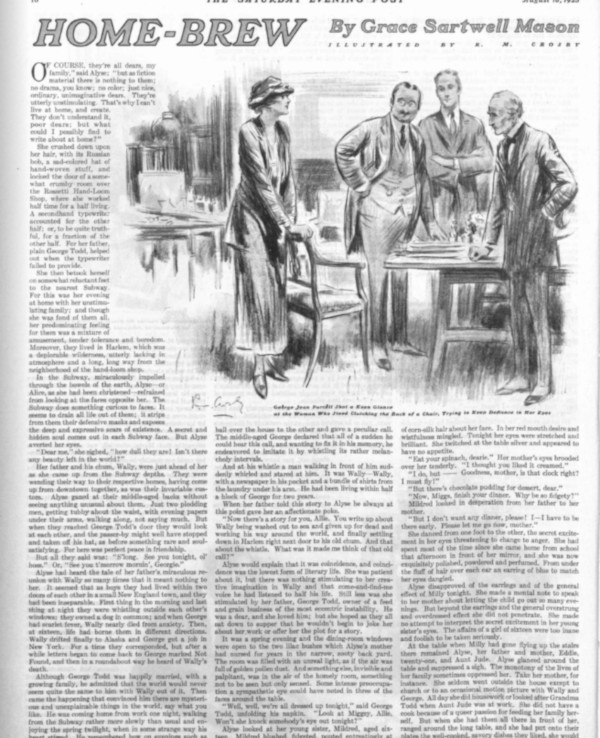
Illustrations by R.M. Crosby
How to Look at a Norman Rockwell Picture: Part 5 — Light and Color
Read all of art critic David Apatoff’s columns here.
This is the fifth in a series of columns on how to appreciate the artistic side of Norman Rockwell’s paintings. See Part 1 on Rockwell’s use of hands, Part 2 on his use of black and white, Part 3 on how he leads your eye, and Part 4 on his interaction with the great artists in history.
You couldn’t be blamed for thinking that this painting, entitled “A Day in the Life of a Girl” is about a day in the life of a girl.
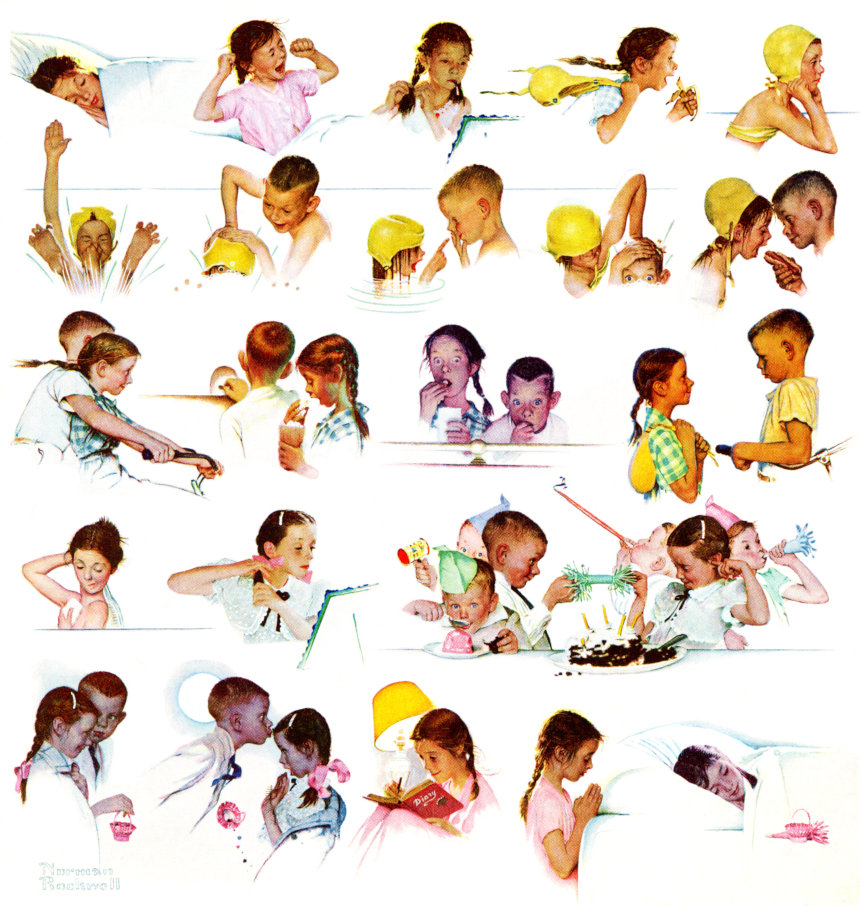
But if you look closely there’s a second subject staring you right in the face: that subject is “light.”
Rockwell could easily have painted each event in the same consistent light. Instead, he spent a great deal of effort capturing light’s subtle changes throughout the day. Light is a separate character in this painting, as important as the girl.
For example, compare the girl at the beginning and end of the day. Rockwell saw that the morning sun illuminates the full range of color in her skin and hair, with emphasis on warm colors such as red, orange and yellow. Moonlight, on the other hand, diminishes the color spectrum and creates cool colors such as blue and gray.
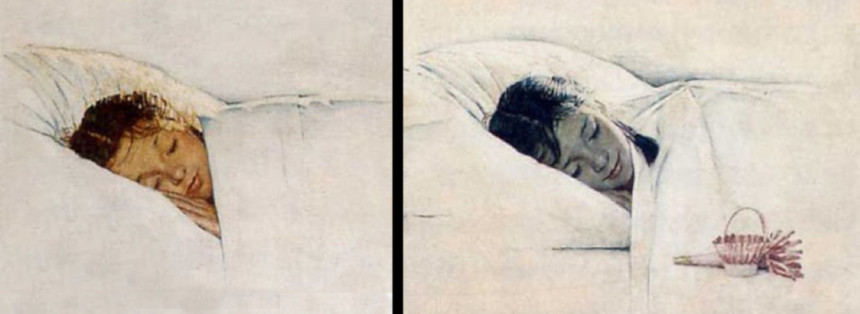
Next, notice how Rockwell captures the way artificial light from a bedside lamp looks different from natural light:
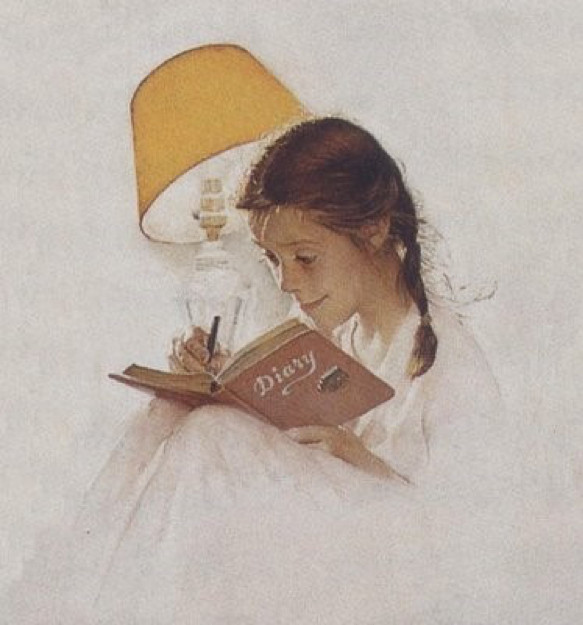
And electric light from the bedside lamp looks very different from the electric light of a movie theater marquee (below):
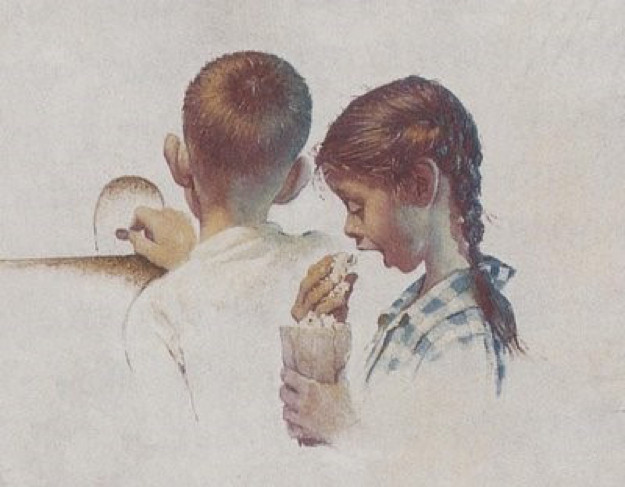
The sharp-eyed Rockwell can even distinguish between two different kinds of theater lighting: he paints the light from the marquee (above) differently from the way he paints the light from the silver screen (below). Then, after the movie ends and the children step out into the golden glow of the late afternoon sun, the light transforms their color completely:
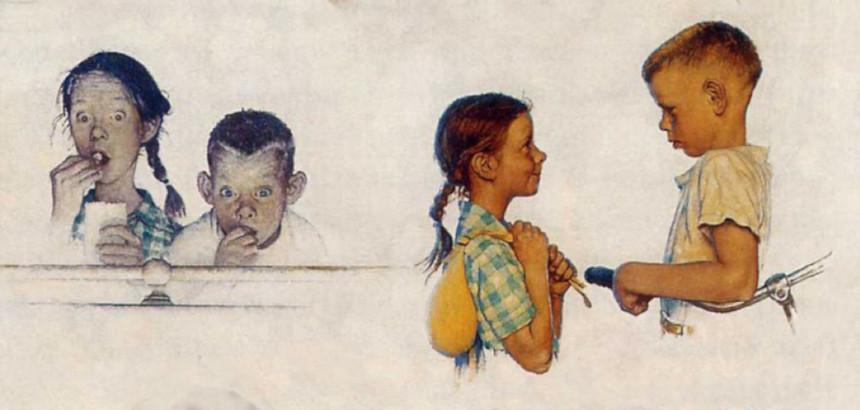
Painting the effects of light required as much artistic skill and observation as painting the girl. This brilliant painting could just as well be called, “A day in the life of light.”
Artists have always been inspired by light; it is the magic ingredient, the source of what we perceive as color. Rockwell may have been a commercial illustrator who painted entertaining magazine covers for a corporate employer, but he was simultaneously a gifted artist, solidly within the artistic tradition that regards light as a source of wonder. (In a previous column I compared Rockwell to the famous impressionist Monet, who painted the same haystack several times to show that color looks different at different hours of the day.)
If you want to appreciate the artistic side of Rockwell’s work, look for the ways in which his paintings celebrate the qualities of light.
For example, why does the lighting of this fellow in the doorway look so warm and welcoming?
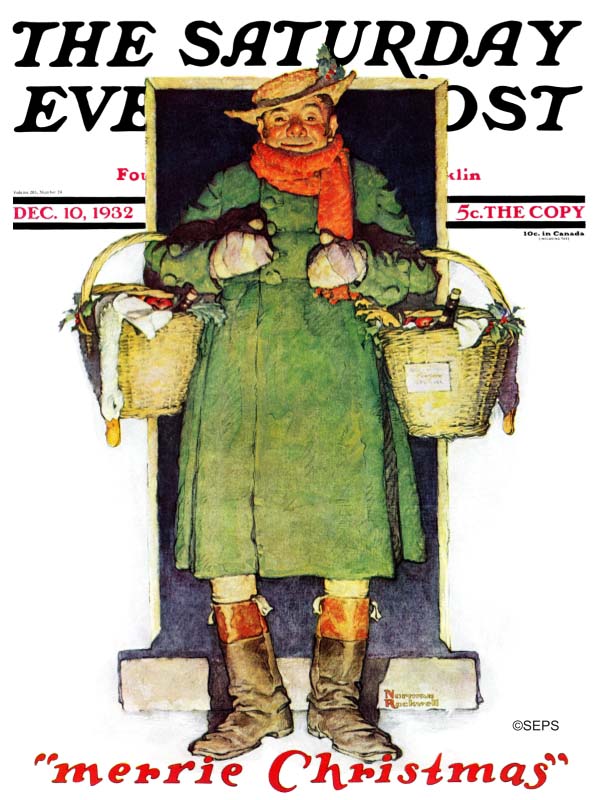
The source of light is from the ground up, rather than from the normal top down. Also, the light has an unusual warm glow. This is because the light is coming from a crackling fire in a fireplace. Rockwell doesn’t need to paint the fireplace for us, he can imply a fireplace using light.
In the next example, Rockwell uses color to contrast an ancient scholar at night in his study with a bold young explorer sailing into the dawn.
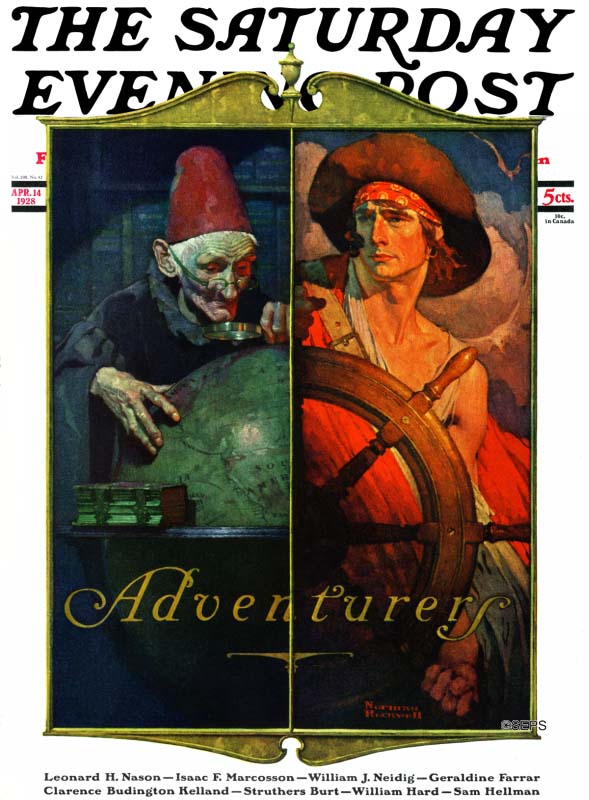
Rockwell didn’t have to clutter up his painting by showing additional objects, such as a black sky with stars and a moon, in order to set the scene. He was able to explain to viewers that it is night because he understood the palette of moonlight.
Finally, it’s important to emphasize that the artistic role of light goes beyond having the keen eye and technical skill to reproduce shades of light accurately. Light can also play a major emotional and psychological role in art. For example, look at Rockwell’s Post cover of a group of amateur musicians playing together after hours in the back of a barbershop:
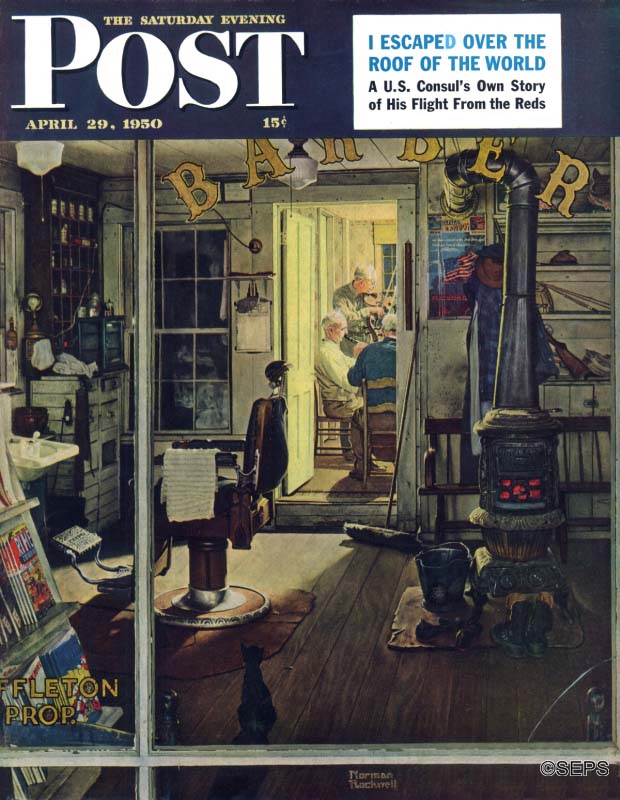
Why didn’t Rockwell paint the entire scene in a well-lit room so he would have more space to show all those warm, folksy details and facial expressions for which he was famous?
The answer is that it was psychologically more effective to use a narrow sliver of light to reveal a partial glimpse of the beating heart of the picture. The joy of this picture is that these musicians are playing for their own private pleasure, not performing publicly. Their shining time together is surrounded on all sides by the darkened place of business, which makes this a more powerful, emotionally moving painting.
All this was achieved with color — one more example of how the mastery of light made Rockwell an excellent artist.
Featured image: Norman Rockwell/SEPS.
Post Artists: The Majestic Art of N.C. Wyeth
For a generation of readers, N.C. Wyeth’s pictures were as well known as the books they illustrated: Treasure Island, Last of the Mohicans, and Robinson Crusoe. Learn how this illustrator of swashbuckling pirates, the Wild West, and Maine fishing life got his big break and went on to found America’s greatest art dynasty.
See all Post Artists Videos.
Featured Image: Smokey Face by N.C. Wyeth (Brigham Young University Museum of Art)
How to Look at a Norman Rockwell Picture: Part 4 — Building on the Work of Other Greats
Read all of art critic David Apatoff’s columns here.
This is the fourth in a series of columns on how to appreciate the artistic side of Norman Rockwell. See Part 1 on Rockwell’s use of hands, Part 2 on his use of black and white, and Part 3 on how he leads your eye.
The greatest artists sometimes painted their own version of another artist’s work. For example, Vincent Van Gogh admired Rembrandt’s 1632 picture of Lazarus Rising From the Dead, so in 1890 he recreated Rembrandt’s picture as an homage:
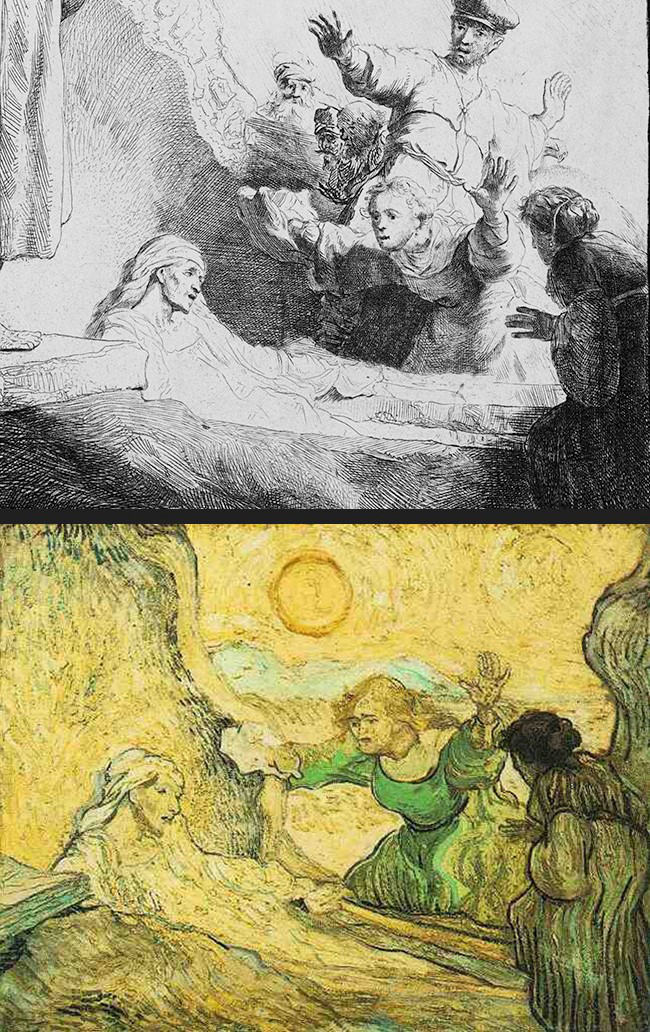
Similarly, surrealist painter Salvador Dali took Vermeer’s painting “The Lace Maker” as his inspiration.
Norman Rockwell was no different. He was inspired by the greatest artistic geniuses and felt challenged by their accomplishments. Even though he was a “mere illustrator” he felt he could learn important lessons from their work. If we recognize these influences in Rockwell’s work, we can better appreciate the scope of his ambition.
For example, Rockwell’s 1943 cover illustration of Rosie the Riveter was a direct tribute to Michelangelo’s famous painting of the prophet Isaiah on the ceiling of the Sistine Chapel:
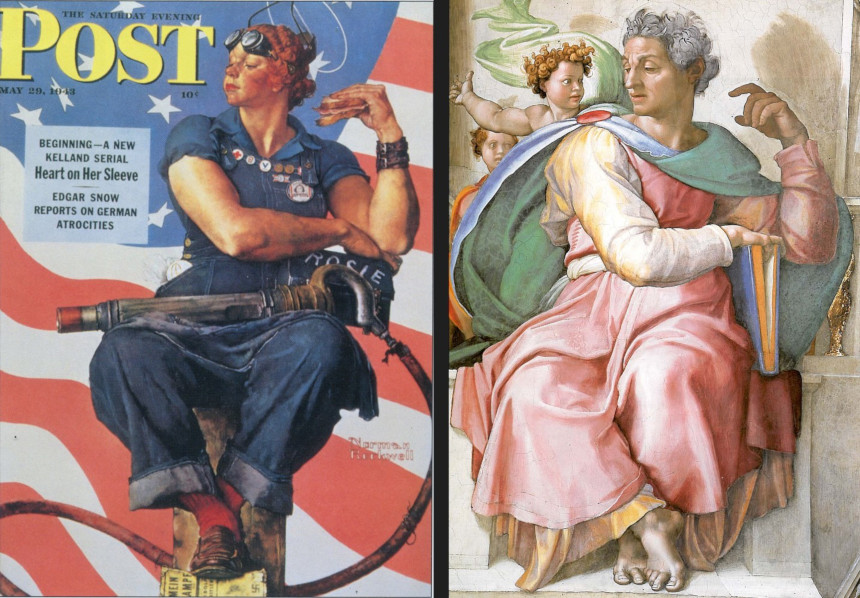
Similarly, when Rockwell wanted to paint a picture of murdered civil rights workers he used as his model Manet’s famous composition of a fallen matador:
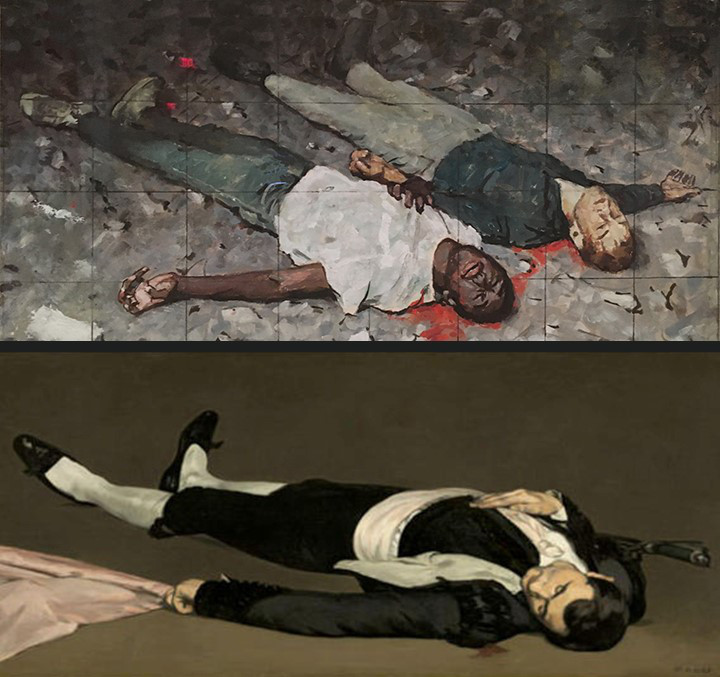
And Rockwell said that his model for this urban street scene for the cover of The Saturday Evening Post was Vermeer’s famous painting, “The Little Street in Delft.”
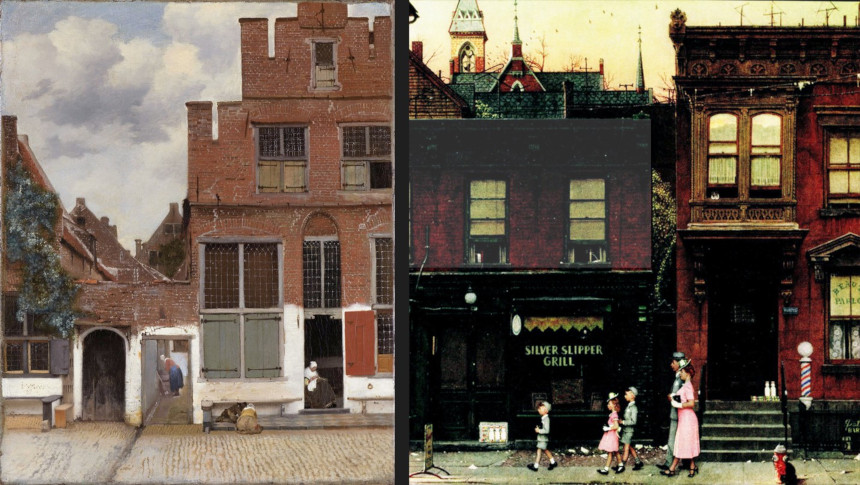
Why do artists use the work of other artists? Is that cheating? Have they run out of ideas?
If we take a closer look at Rockwell’s painting of the street scene, it will give us a better idea of what Rockwell is doing.
First we should note that this painting exemplifies everything that fans love about Rockwell. The story it tells is rich, interesting and multi-layered.
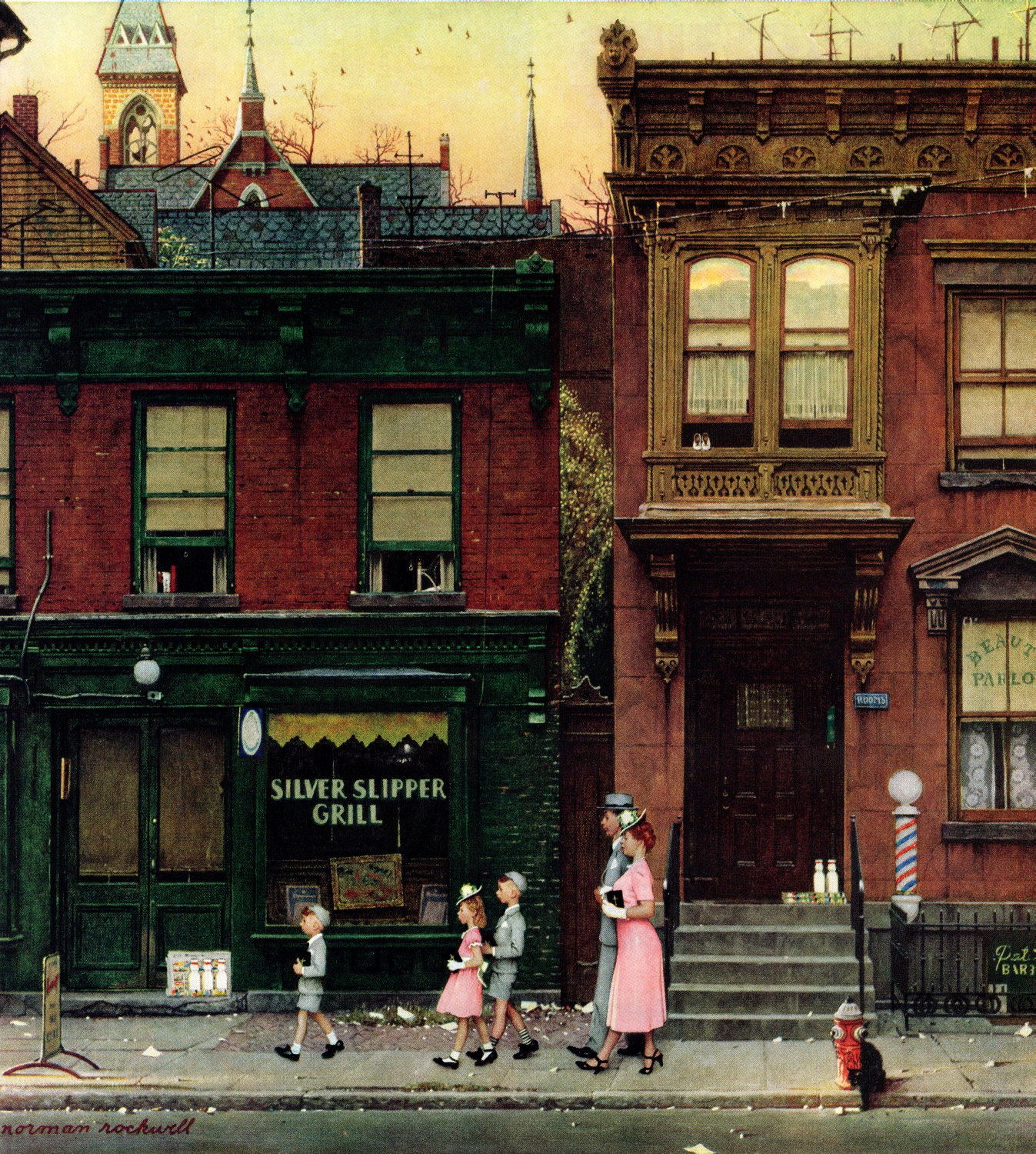
A family walking to church on Sunday morning, all dressed up with stiff — perhaps overly stiff — postures, averts their eyes from the seedy neighborhood through which they must walk. Notice that the milk bottles and Sunday morning newspapers are still on the front porches, so the local residents are still in bed. A pair of dancing shoes from the night before is airing out on a window ledge. For an especially nice touch, notice the flock of birds in the sky leaving the steeple, roused by the ringing of the morning church bells.
Go down an additional layer into this painting and you’ll realize that it describes how critics thought of Rockwell. They accused him of being myopic, his eyes fixed straight ahead, disregarding the seamy side of life all around him. True artists are supposed to notice details such as litter and broken sidewalks, but Rockwell was accused of living in a corny, idealized world.
But consider this: Rockwell’s tribute to Vermeer was painted at the exact same size as Vermeer’s masterpiece, using the exact same medium, and it comes off well by comparison. Rockwell may have been working on a deadline for a corporate employer, but he aimed high. He painted those bricks, captured the glow and the feel of old Dutch painting, studied Vermeer’s palette and composition. He appreciated Vermeer’s artistry and was able to work in that style the way very few, if any, fine artists of his day could. He may not have viewed himself as an artistic genius, but we can tell from his choices that he viewed the work of artistic geniuses as relevant to what he was doing.
Featured image: ©SEPS
How to Look at a Norman Rockwell Picture: Part 1 — Hands
Read all of art critic David Apatoff’s columns here.
A painting by Norman Rockwell can be viewed on many different levels. Some enjoy Rockwell as a story teller. Others like to go on a treasure hunt for details. Some like to look for a quick joke. But to fully appreciate the effort Rockwell put into his pictures, we should also look at his pictures as works of art. Rockwell put his heart and soul into the design, composition, color, and other characteristics of making “art” in the tradition of the greatest painters in history.
This is the first in a series about how to recognize and enjoy the “art” in Rockwell’s paintings.
Part 1: Hands
Human hands are expressive and beautiful, but they can also be very difficult to draw. They are anatomically complex, with a huge variety of possible positions. And even after an artist has mastered the technical skill of drawing hands, capturing their poetry — their expressiveness and their symbolism — adds a whole additional challenge.
The great Renaissance artist Caravaggio’s paintings of hands were famous for showing authentic callouses and dirt under their fingernails, rather than the idealized hands that previously dominated art. His “natural” look scandalized viewers and church patrons of his day. Here is Caravaggio’s famous painting of Bacchus, with a close up of his dirty fingernails.
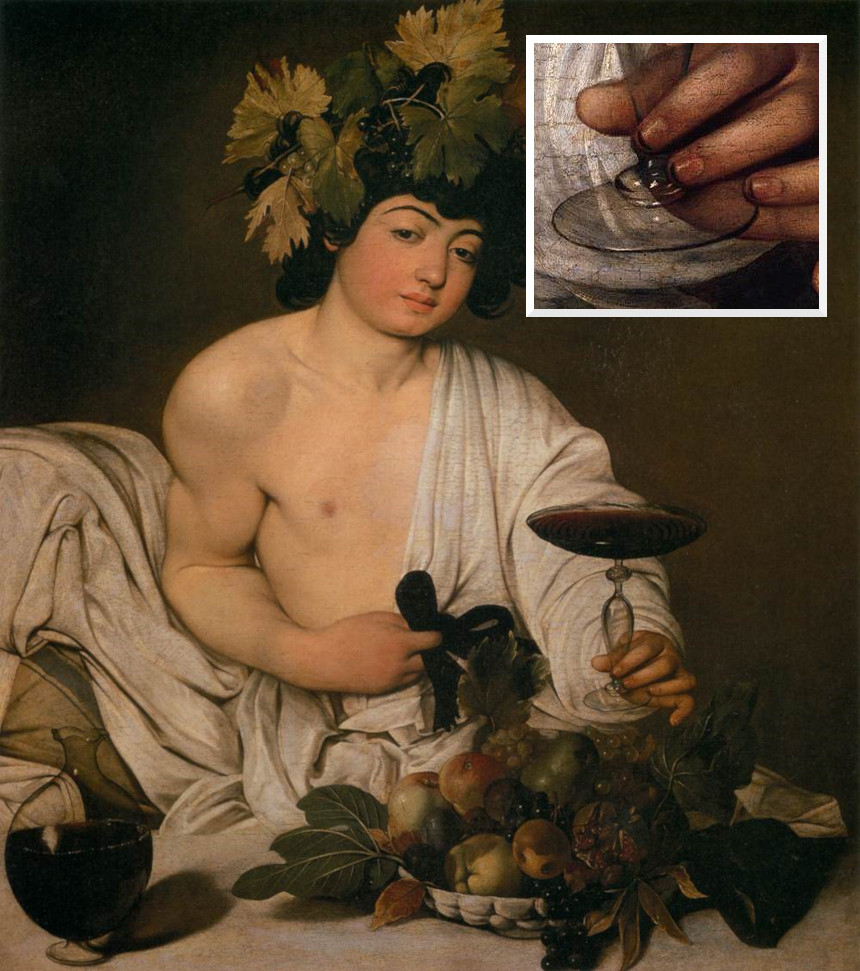
How shocking! But by painting the “real” hands of workmen and peasants, Caravaggio transformed the meaning of his paintings.
Because hands are so difficult to paint, many artists try to avoid painting them. They hide them in pockets or behind backs, as Elbert McGran Jackson did in this cover for the Post:
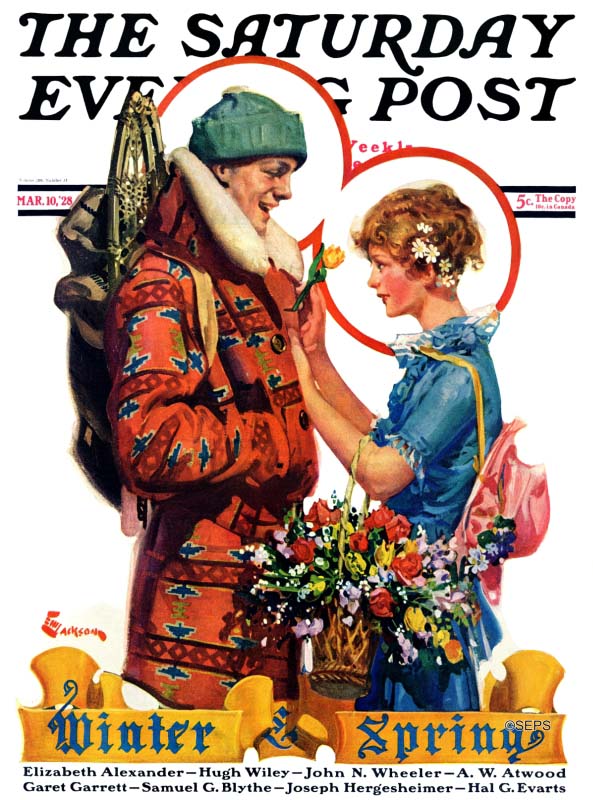
Many artists feel they can get by with hiding hands or giving them perfunctory treatment because hands are rarely central to a picture. They aren’t worth the trouble. Artists who want to realize the full potential for hands must exert a lot of additional effort.
If you look at almost any Rockwell painting, you’ll notice he went out of his way not only to draw hands, but to feature them prominently, and in the most interesting and expressive ways.
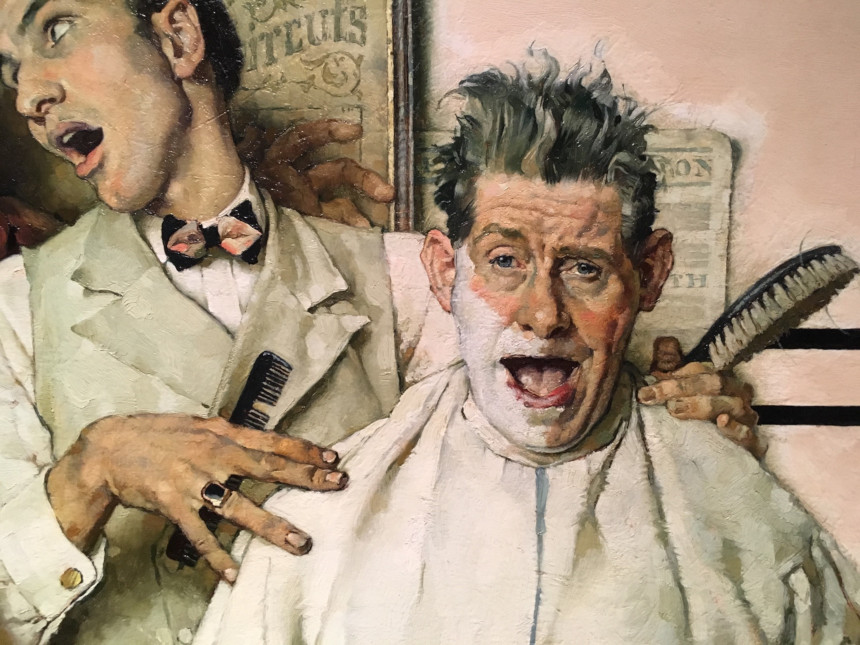
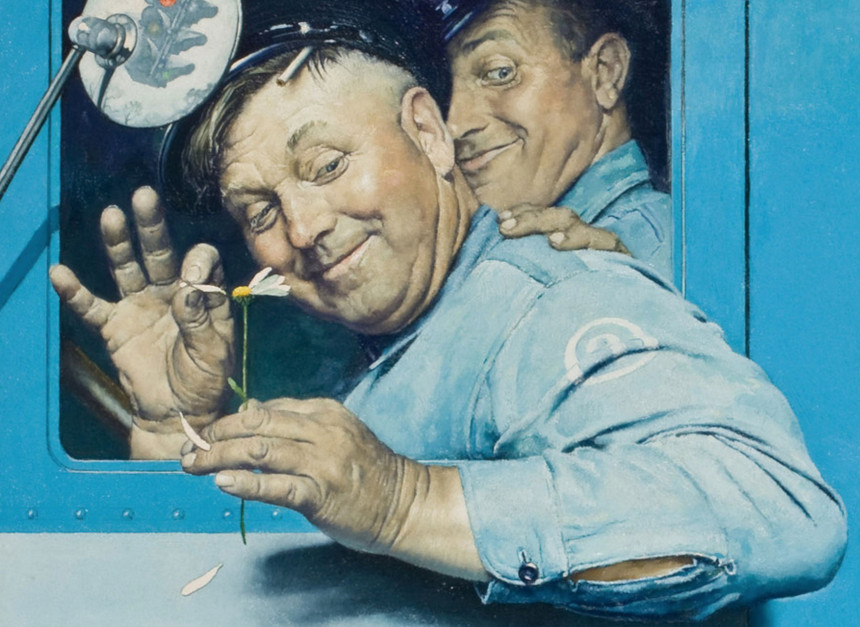
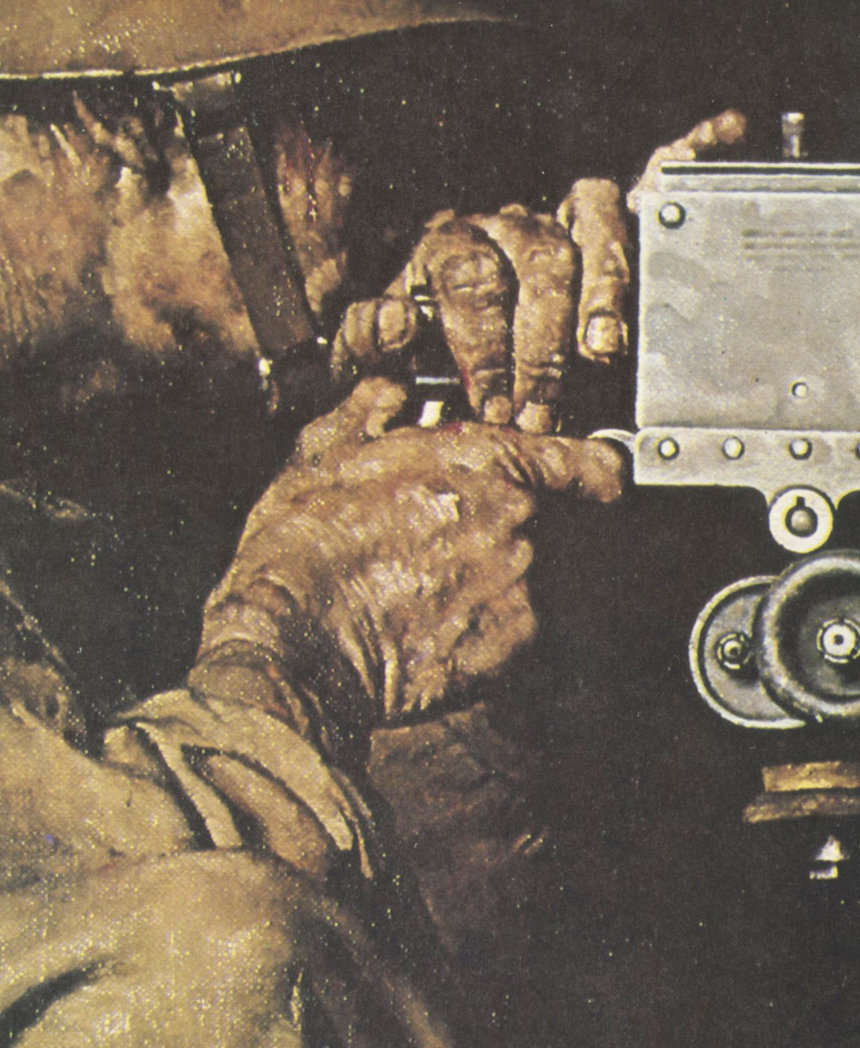
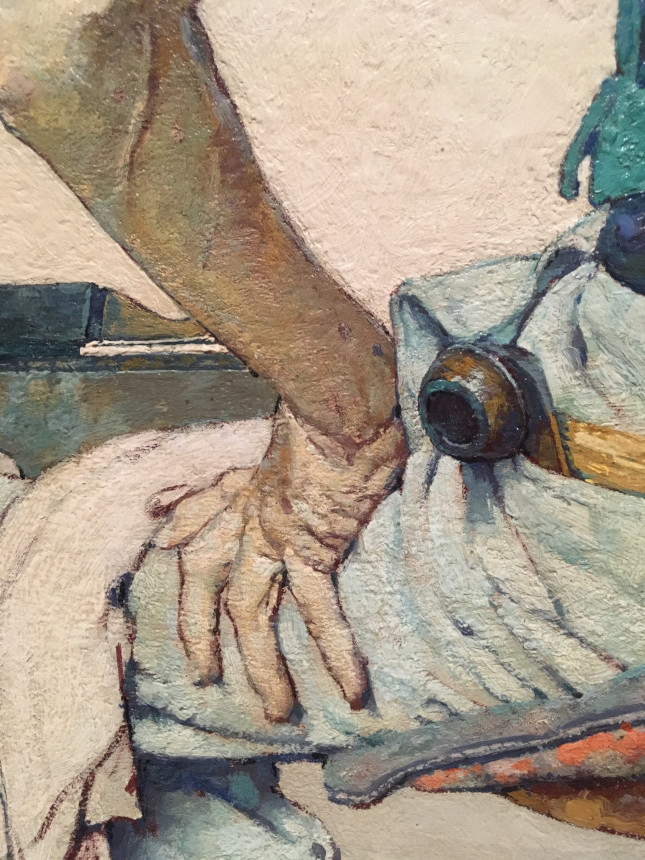
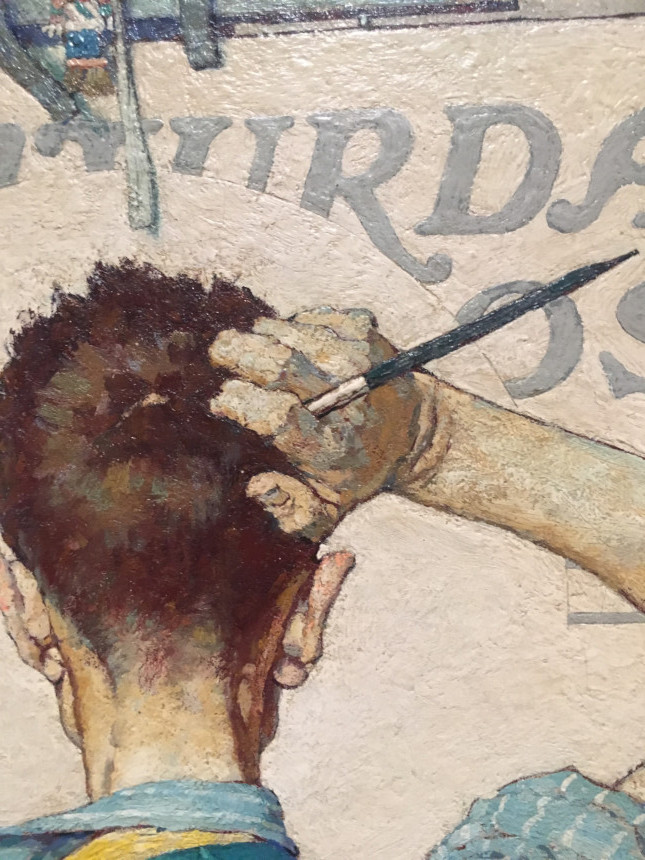
This required a great deal of additional effort, but the artist in Rockwell believed they were important to the overall painting.
Remember Caravaggio’s authentic hands of the workers and peasants? When Rockwell wanted to paint a common laborer standing up and expressing his opinion under the First Amendment, he was careful to show a workingman’s hands:
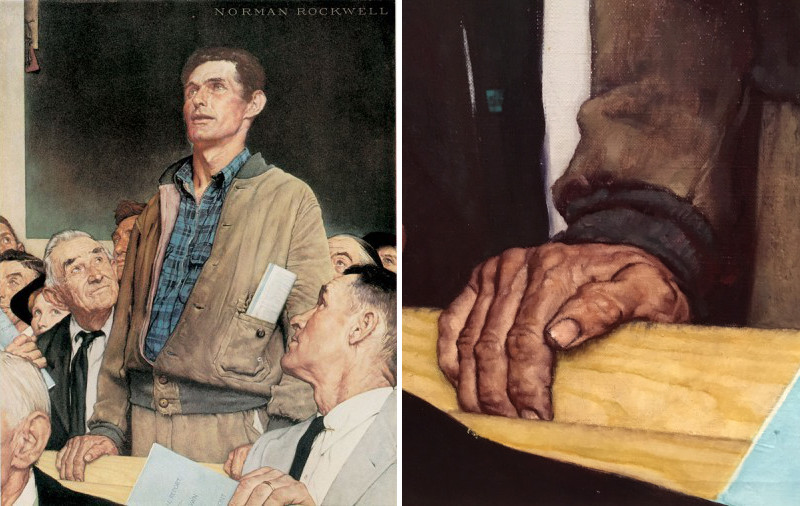
It would’ve been easy for Rockwell to avoid the extra work of painting another hand, but he clearly felt it was an important ingredient in his message about this man.
Rockwell’s hands are skillful, lovely and worthy of our attention, but what else do they tell us about Rockwell as an artist?
They reveal that Rockwell was a “materialist” in the best, old fashioned sense of the word. He had a rare appreciation for our material surroundings, their colors and patterns and textures, the nuances of skin as well as the structure of bone and muscle beneath the skin.
The way Rockwell painted hands gives us insight into an artistic virtue at the core of his work: his extraordinary ability to see the richness of our surroundings and draw our attention to the potential for poetry in even the humblest of details. Unlike some other fine artists, Rockwell did it for a broad audience and he did it under deadline. Still, as artistic virtues go, it’s hard to beat that one.
Featured image: Norman Rockwell, SEPS
Considering History: Remembering the Founding Fathers, Flaws and All, on the Fourth of July
This series by American studies professor Ben Railton explores the connections between America’s past and present.
On July 4, 1826, John Adams and Thomas Jefferson, America’s second and third presidents and two of the most famous and influential founding fathers, passed away within a few hours of each other. More than just a striking historical fact and one final interconnection between two friends and rivals whose lives and careers had often intertwined, Adams and Jefferson’s July 4 deaths offer a succinct illustration of how much the founders had already become, half a century after the Declaration of Independence, mythic figures with larger-than-life identities and stories.
Those myths are not without merit: the Declaration, Revolution, and Constitution were bold and impressive achievements, and a core group of figures played significant roles in all of them. As I argued in last year’s July 4 article, however, the Declaration also contains a hidden history that reflects darker and more divisive Revolutionary realities of slavery and hypocrisy. Similarly, founders like Adams and Jefferson were complex men, multi-layered historical figures whose flaws as well as their successes have a great deal to teach us about their period and America.
Jefferson’s worst failings are well known, and indeed have come to be defining aspects of our collective memories of him. Yet those flaws go deeper than the alleged (and historically likely, per both uncovered DNA evidence and the vital work of scholar Annette Gordon-Reed) repeated sexual assaults on one of his slaves, Sally Hemings. They also entail racist views of African Americans that become even more hypocritical when seen in light of those personal actions — views illustrated by the cut Declaration paragraph on slavery and the “foreign people” it had “obtruded upon” the colonists, but developed at much greater length in his Notes on the State of Virginia (1785).
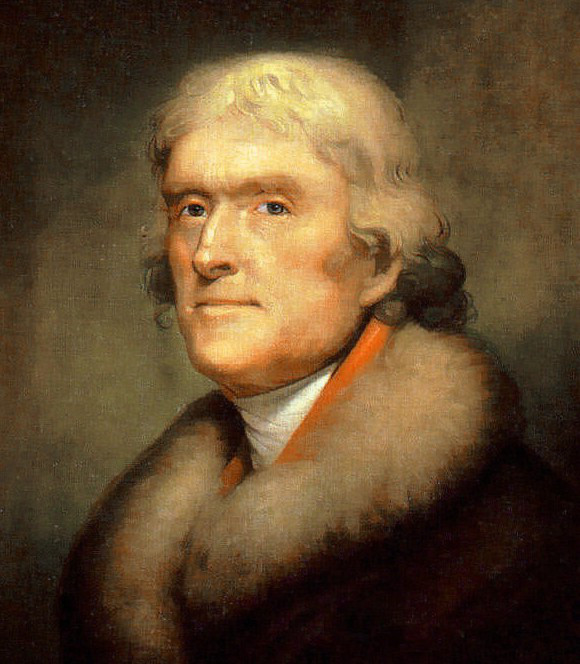
In one especially striking extended passage from Notes, Jefferson expounds at length on all the factors that make “the blacks … inferior to the whites in the endowments both of body and mind.” He remarks upon their “very strong and disagreeable odor,” their “want of forethought” and “transient griefs,” and their imaginations that are “dull, tasteless, and anomalous.” And he concludes, with particular hypocrisy for a lifelong slaveowner, that “This unfortunate difference of color, and perhaps of faculty, is a powerful obstacle to the emancipation of these people.” While that “perhaps of faculty” indicates an attempt at scientific nuance, the passage as a whole reflects a man unable or unwilling to learn the human truths of the enslaved African Americans all around him.
When it comes to John Adams’s flaws, there’s a general sense that he was one of the most elitist of the founders, a die-hard Federalist who at times feared the general public and its potential for disorder and sedition more than he sought to protect them in our framing documents. That’s a simplified but not inaccurate description of Adams’s overall political philosophies, yet I would argue that it hides a deeper flaw: as his impassioned legal defense of the British soldiers accused of murder at the 1770 Boston Massacre reveals, Adams’s elitism was also racially and culturally charged.
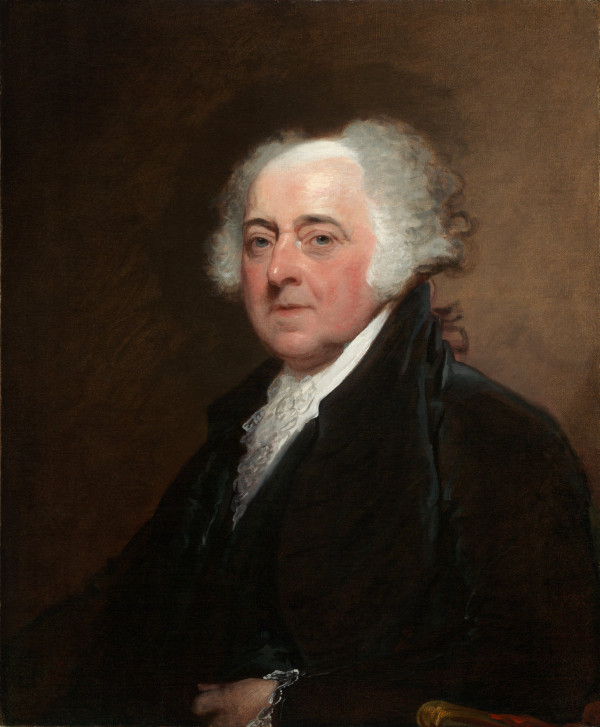
Defending the soldiers was Adams’s job as a young Boston lawyer, and one that he performed with fervor, particularly in an eloquent court monologue that helped win an acquittal for many of the accused. In the course of that statement, Adams deployed a series of stereotypical and bigoted images of the massacre’s first victim, Crispus Attucks. Attucks, Adams argued, had “undertaken to be the hero of the night” through his “mad behavior,” but exemplified instead the event’s “motley rabble of saucy boys, negroes and mulattos, Irish teagues and outlandish jack tars.” Given that Attucks was not only a mixed-race individual but also a fugitive slave, Adams’s language reveals the links between Revolutionary elitism and the same kinds of racist hypocrisy embodied by Jefferson.
So these famous founders weren’t just flawed — they were flawed in ways that reveal some of the exclusionary, white supremacist elements of the nation’s origins. Their vision of who was American — or at least who was most fully and definingly American—was certainly part of the Revolutionary era, and has continued to echo ever since. But it’s not the only side of the era, nor of these men and their lives and legacies. There are also genuinely inspiring sides to both Adams and Jefferson that embody our nation at its best.
Some of Adams’s most inspiring moments are directly tied to his marriage, and through them to his wife, the deeply impressive historical figure Abigail Smith Adams. Thanks to the work of historian Sara Georgini and the entire Adams Family Papers staff at the Massachusetts Historical Society, we have unparalleled access to materials like John Adams’s letters, many of which were exchanged with Abigail as the two were separated for more than a decade before, during, and after the events of the Revolution.
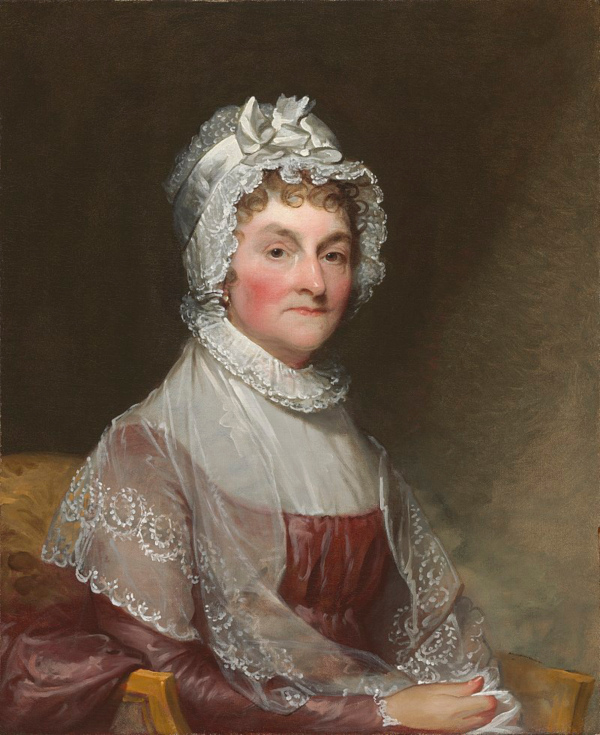
Those letters are justifiably famous for striking individual moments: John’s eerily accurate July 1776 predictions about future Independence Day celebrations; Abigail’s March 1776 letter imploring her husband and his fellow framers to “Remember the ladies” in their deliberations. But what the letters as a whole reveal more deeply are the sacrifices made by the founders during their decades of service to the nation for which they were fighting. That’s especially clear in an emotional July 1776 letter when John, having learned that his family had been suffering from smallpox without his knowledge, writes,
Do my Friends think that I have been a Politician so long as to have lost all feeling? Do they suppose I have forgotten my Wife and Children? … Or have they forgotten that you have a Husband and your Children a Father? What have I done, or omitted to do, that I should be thus forgotten and neglected in the most tender and affecting scene of my Life! Don’t mistake me, I don’t blame you. Your Time and Thoughts must have been wholly taken up, with your own and your Family’s situation and Necessities. But twenty other Persons might have informed me.
Thomas Jefferson had many important and influential moments throughout the Revolution as well as during its aftermath; he drafted the Declaration of Independence and served two terms as president. But to my mind it’s his philosophical, legal, and intellectual work over those same decades that offers his most inspiring contributions to that new America.

Exemplifying that vital work was Jefferson’s drafting of the 1786 Virginia Statute for Religious Freedom. This law, a key predecessor to the First Amendment’s protections of religious freedom, guaranteed that all Virginians “shall be free to profess, and by argument to maintain, their opinions in matters of religion, and that the same shall in no wise diminish, enlarge, or affect their civil capacities.” Jefferson put that philosophy in action through his professed support for Islam and Muslim Americans as part of these new civic communities. And a few decades later he created a community where such religious and intellectual freedom could flourish, founding the nation’s first non-sectarian public university, the University of Virginia, in 1819.

Jefferson wanted both the statute and the university memorialized on his tombstone (along with the Declaration), a moving illustration that as of July 4, 1826, such civic contributions remained critically important. The two towering figures who died that day left legacies that include some of America’s more divisive and bigoted histories to be sure. But they also contributed, through their lives and their ideas, to the founding of American ideals as well as the nation. Critical patriotism requires us to remember all these sides to Adams, Jefferson, and America on the Fourth of July.
Featured image: John Adams and Thomas Jefferson (Detail from postcard published by The Foundation Press, Inc., 1932. Reproduction of oil painting from the artist’s series: The Pageant of a Nation. Collection of the Virginia Historical Society, Library of Congress)
3D Printing the Old-Fashioned Way
In 2014, a team of imaging experts with Smithsonian created the first-ever 3D-scanned presidential portrait. In a little over seven minutes with a sitting President Obama, the team was able to capture sufficient data to 3D-print a life-size bust of him that was an objectively accurate rendering of his features.
And yet, the resulting model was lacking a lifelike quality.
At least, that’s what bronze sculptor Carolyn Palmer says. She remembers thinking that her profession could be in jeopardy with the arrival of this new technology. Despite Obama’s abundance of soul and personality, the 3D-printed presidential portrait is “very cold,” Palmer says. “In my belief, the sculptor brings life into a piece.”
Her theory about the necessity of the artist in sculpture seems to ring true, even as leaps in technology have made such reproductions possible. Palmer is busier than ever, receiving a constant stream of commissions for sculptures in marble and bronze. Her bronze busts of Franklin D. and Eleanor Roosevelt are currently travelling with Rockwell, Roosevelt, and the Four Freedoms, an exhibit organized by the Norman Rockwell Museum. Opening last May in New York, the exhibition will have made stops in Michigan, Washington, D.C., Normandy, Houston, and Denver before it closes at the Rockwell museum in 2020.
Rockwell’s Four Freedoms series was originally published in this magazine as an artistic response to a speech President Roosevelt gave to Congress in 1941 on the eve of World War II. The paintings, Freedom of Speech, Freedom of Worship, Freedom from Want, and Freedom from Fear, were published alongside essays by distinguished writers and became emblematic of the war effort.
“Who would say no to travelling with the Norman Rockwell Museum?” Palmer says. She visited the exhibit in New York, and she was thrilled to see her Roosevelt sculptures sitting among the works of the masterful American painter. Rockwell gained a reputation for painting faces so full of personality they seem as though they might come to life, and Palmer strives for a similar effect in her own work.
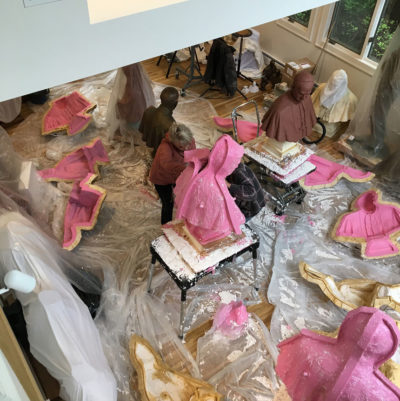
For 22 years, she has practiced the lost-wax method of casting bronze, which has itself been used for thousands of years. First, the artist creates a model in clay. This is covered with silicone rubber that will capture the finest details of the sculpture, then plaster for support. A wax model is made from this mold, which is then dipped into a ceramic slurry. The wax is “lost” when this new mold is heated. Finally, the bronze can be poured.
At every step, there are ample opportunities for disaster. A completed bronze sculpture requires an artist to oversee the work of many skilled artisans, and it can take months to finish. Palmer says she remains involved in the process at every step, particularly since she lost Edith Wharton. Her small clay model of the writer had been diligently sculpted with fine details, but it was destroyed when she handed it over to a newbie moldmaker.
Palmer received her degree in art education from Nazareth College, and she taught painting privately for a time while taking commissions for portraiture and logo design. She received her first opportunity to sculpt when one of her clients asked her to refer an artist to create a bronze Thomas Jefferson. “I said, ‘Oh please give me this opportunity, because I know I can sculpt!’ I offered to invest in the clays and told him if he didn’t like the piece he didn’t have to pay for it to go further into bronze,” Palmer says. Although she hadn’t studied sculpting much, Palmer remembered visiting her grandparents in Siesta Key when she was a little girl and carving forms at the beach: “Ever since I was a little girl I would make faces and people in the sand, and I would literally make them look like they were coming out of the sand.”
Since that first successful commission, Palmer has racked up an impressive resume of statuary that will stand in public and private spaces for generations. In 2015, she was chosen out of 68 sculptors to replace the infamous “Scary Lucy” statue in Lucille Ball’s hometown in New York. She has also completed likenesses of four popes, the Wright brothers, President Bill Clinton, Mario Cuomo, and Dr. William Osler. The last one might not ring a bell, but he is often described as the “Father of Modern Medicine” for his innovative practice of residency programs and bedside medical education. “There must not be a lot of Osler sculptors out there,” Palmer says, since she’s received orders on her Osler sculpture from around the world.
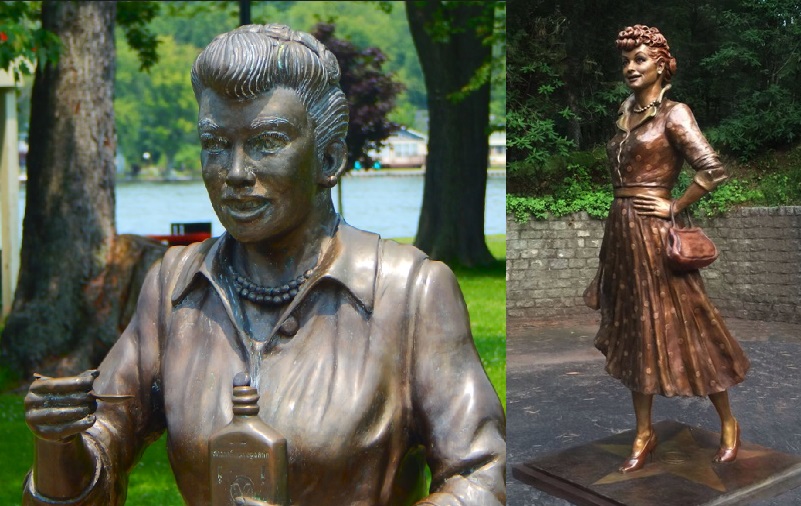
In the age of 3D-printing and automation, it might be difficult for many viewers of bronze and marble sculptures to appreciate the skilled process that goes into creating a lasting lifelike form. At best, they can be timeless, glowing tributes to humanity to marvel and inspire passersby. At worst, they can resemble the stuff of nightmares and serve as fodder for viral social media snark. The difference is all in the skill of the artist.
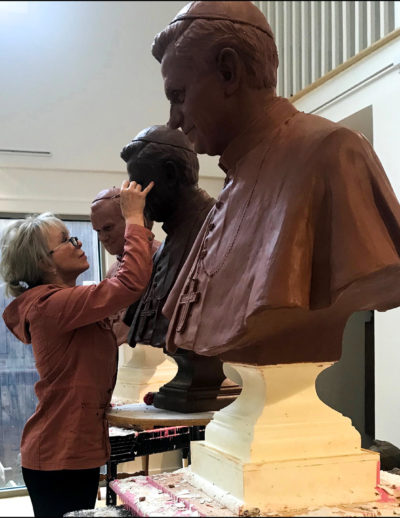
Palmer has always admired the works of sculptors like Jean-Baptiste Carpeaux, a 19th-century French artist. “He had a great taste for movement and spontaneity and he broke away from stiff, stoic looks on sculptures,” she says. “He could capture the intensity of a person’s personality or soul or essence.” Palmer refers to the bust of Robert Fulton by Jean Antoine Houdon that sits in the Metropolitan Museum of Art as an example of a work that comes to life. “When I start on a piece, I try to feel their personality,” she says. “You have to look with your heart, get to know them like an actor or an actress would get to know a role.” It’s certainly a slower process than 3D imaging, and much less forgiving. She’s currently chipping away at 800 pounds of marble in her studio as proof of that.
Featured image: MZ Studios
The Bizarre and Adorable Canine Comics of Robert L. Dickey
A Midwesterner through and through, Robert L. Dickey displayed a peculiar commitment to thick Scottish dialect in portraying his characters Sandy and Jean McNab. The McNabs were a spousal pair of Scottish Terriers in Dickey’s comic strip, “McNab and His Neighbors” that ran in this magazine through the 1920s. Whether the McNabs were beloved because of their innate cuteness or the silliness of lines of dialogue that would nowadays have readers running for a translator app (“It will seem guid to see some one frae home”) is difficult to say. But Dickey — in spite of his decades of animal illustration that may have changed the way we see our pets — has been all but forgotten. The once-celebrated artist has nary a Wikipedia page or accessible obituary.
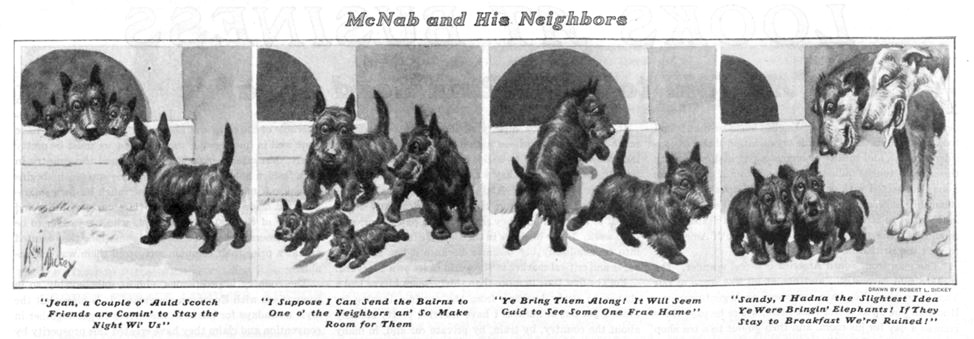
Before drawing adorable pooches, Dickey made his name as a horse illustrator for Chicago’s The Horse Review. As a child, he was enamored with animals, and at a young age he won first prize at the county fair for a drawing of Goldsmith Maid, a legendary mare of harness racing in the 19th century. His winnings amounted to one dollar and a ribbon, but he soon found himself taking commissions from race horse owners and local farmers from his hometown of Marshall, Michigan.
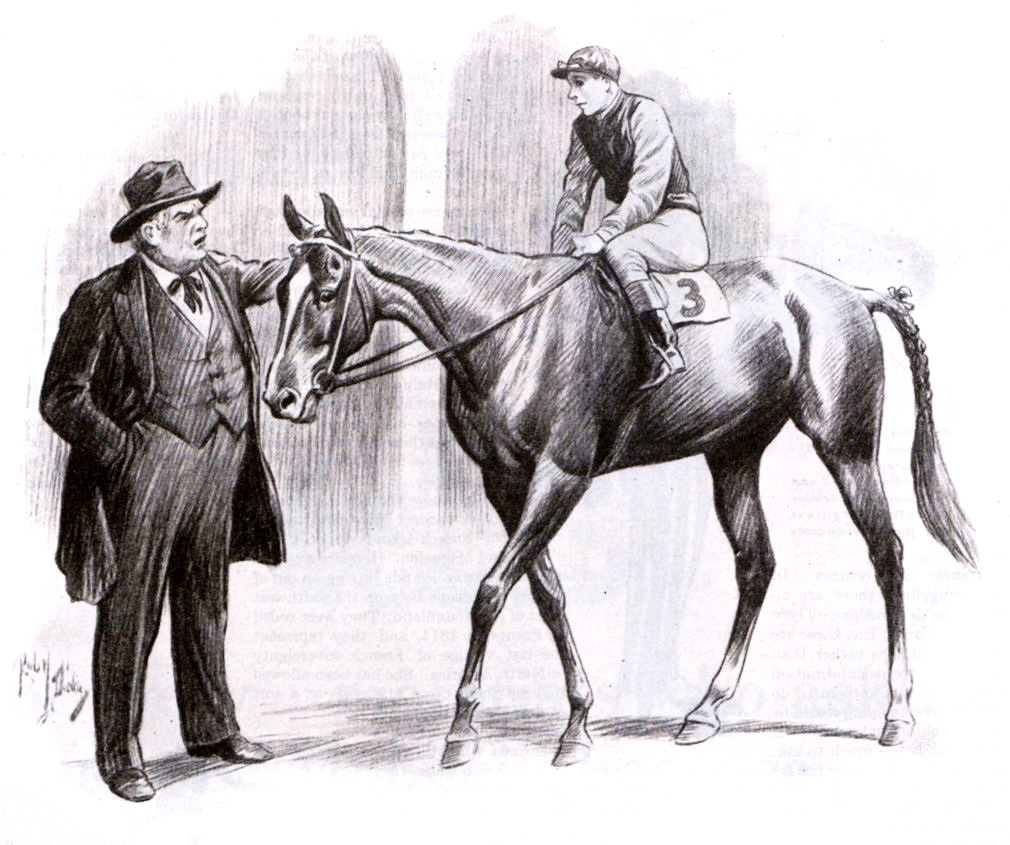
Though he sustained an enthusiasm for horse racing, Dickey’s true artistic muse became the canine. One specific canine, in fact: a white bull terrier named Chimmie Fadden. In the pages of this magazine, in 1929, Dickey proclaimed that his former pet had been a most important art teacher: “His one brindle eye and his two brindle ears could, to me and my family, express all the human emotions; admiration, adoration, adulation were all expressed in the big brown eyes, half hidden beneath the narrow lids of his breed. He could cock one brow in incredulity, and with eye, ear and tail express the utmost contempt.” Of his beloved Chimmie, Dickey also said, “He taught me all the vital things — the things that I have tried hard to get into my drawings — the expression and aliveness that are so important.”
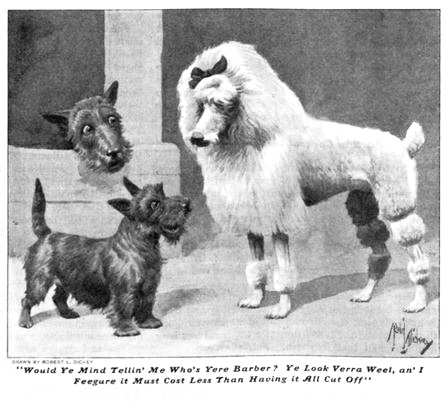
Dickey moved to New York and began publishing comics and illustrations with Life, at the encouragement of editors John Ames Mitchell and Thomas L. Masson. In Dogs from “Life” (1920), Masson calls Dickey “perhaps the best dog artist in this country,” and he credits that success to Life’s guidance, of course. Masson writes that Mitchell advised Dickey to give his dog illustrations more realistic qualities instead of making caricatures: “Don’t make your dogs humorous. You are too good an artist to attempt that sort of thing. Make your dogs true to life — just as they are.”
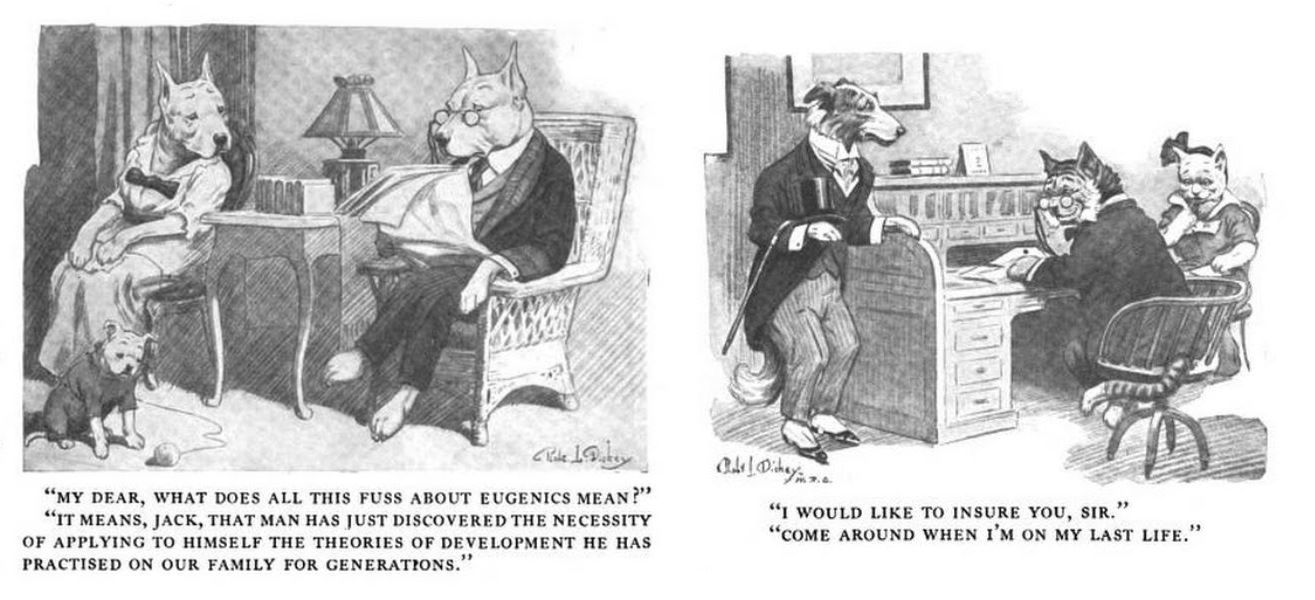
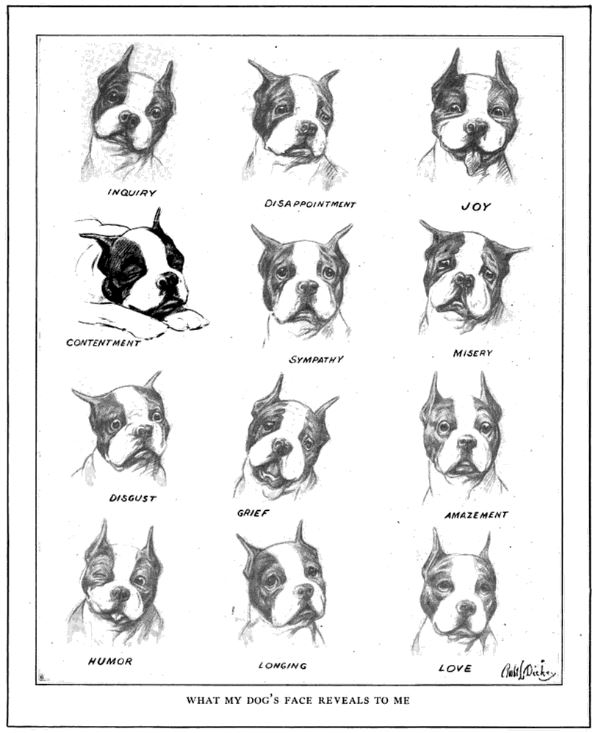
If Dickey followed the Life editor’s advice, he promptly disregarded it for his work in The Saturday Evening Post. After a few tries at political cartoons, Dickey settled in with some recurring characters for the “Short Turns and Encores” section. Throughout the ’20s, in strips like “Timmie and Tatters,” “McNab and His Neighbors,” and “Mr. and Mrs. Beans,” Dickey portrayed cute dogs of various breeds with the humorous hangups and eccentricities of everyday people. With an affinity for terriers, Dickey’s strips showed the lighter side of relationships, middle-class vanity, and machismo.
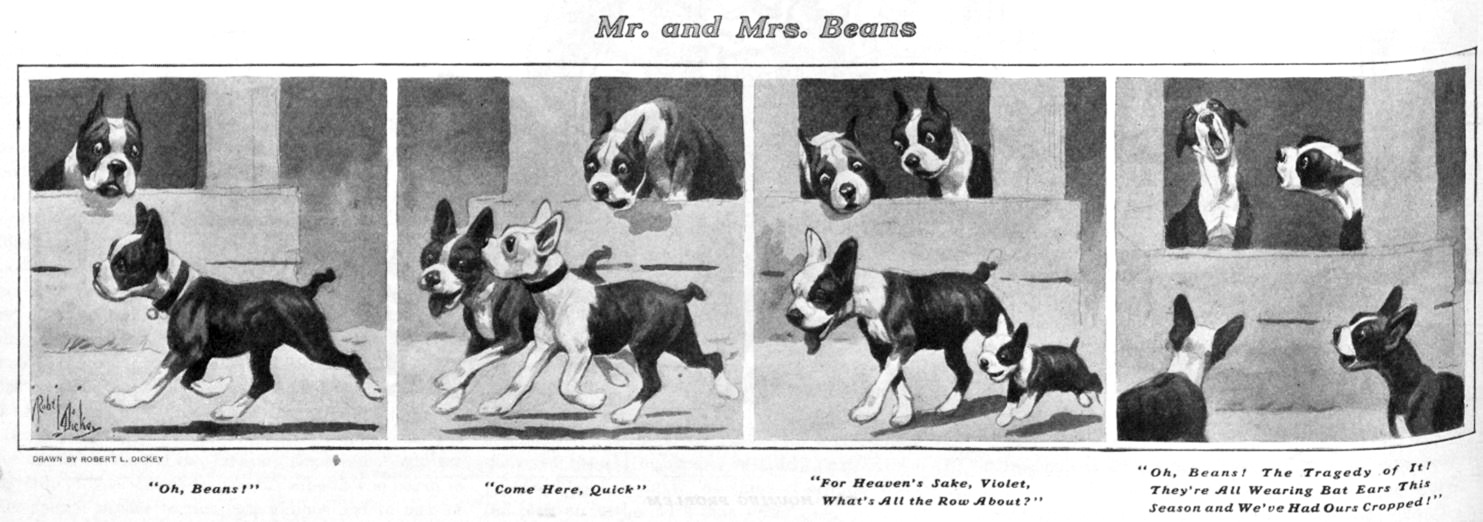
Beans and Violet, Dickey’s signature Boston Terriers in “Mr. and Mrs. Beans,” were named after his own Boston Terriers that travelled with the artist any time he left New York City. Dog historian Cathy Flamholtz credits Dickey for the immense popularity of the breed in the 1920s and ’30s (in Boston Terriers: The Early Years), writing, “While the critics may have scoffed at Robert Dickey’s drawings, the public loved them! Confirmed readers of the most popular magazines fell in love with the clownish dogs seen in the pages of their favorite publications. They wanted one of these dogs and they bought ‘America’s Dog’ in large numbers. Soon, Boston Terriers were one of the most popular breeds in the country.” Flamholtz notes of Dickey’s work in comic strips, tobacco ads, and magazine covers, “The drawings reflect the charm, curiosity, mischievousness, and intelligence of the Boston Terrier. They could only have been made by someone who knew the breed so intimately.”
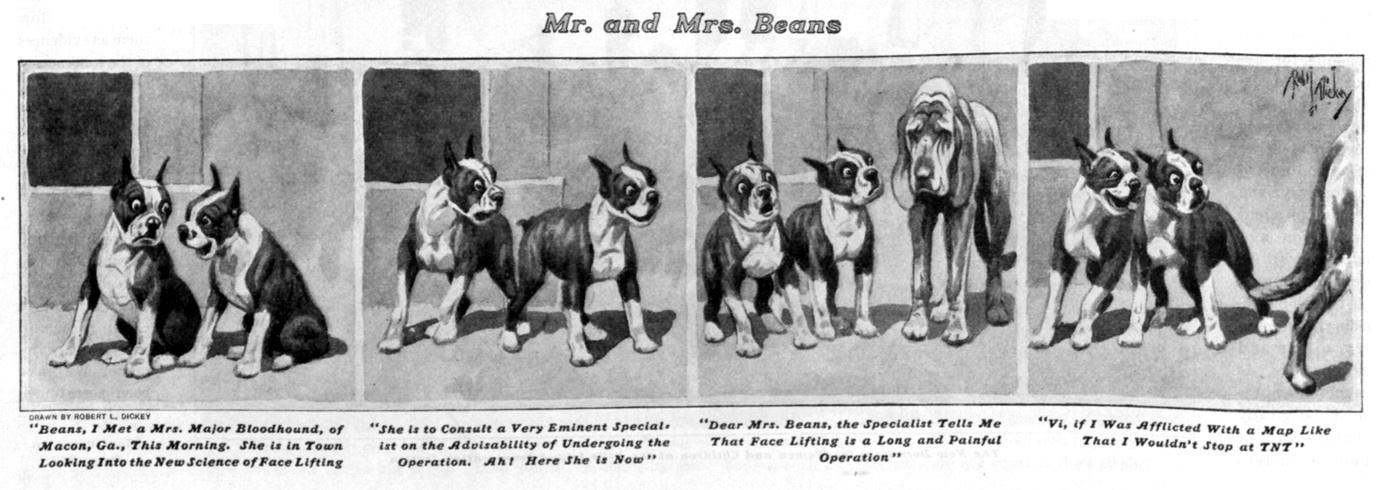
In spite of Dickey’s contributions to American illustration, he is scarcely remembered. His crowd-pleasing comics filled with “puppy dog eyes” and deviant hounds changed the way dogs were rendered in publication and likely altered the way people thought about their four-legged friends. His strips were printed in newspapers around the country as well as Ladies’ Home Journal, Century, and other magazines. He also illustrated the Barse edition of Black Beauty and books like Lad: A Dog and A Dog Named Chips by Albert Payson Terhune. But in his characters, Beans, Violet, and Sandy McNab, Dickey opened the door in the public imagination to the possibility of a dog expressing human faults, joys, and sorrows — and maybe even sporting a Scottish accent.
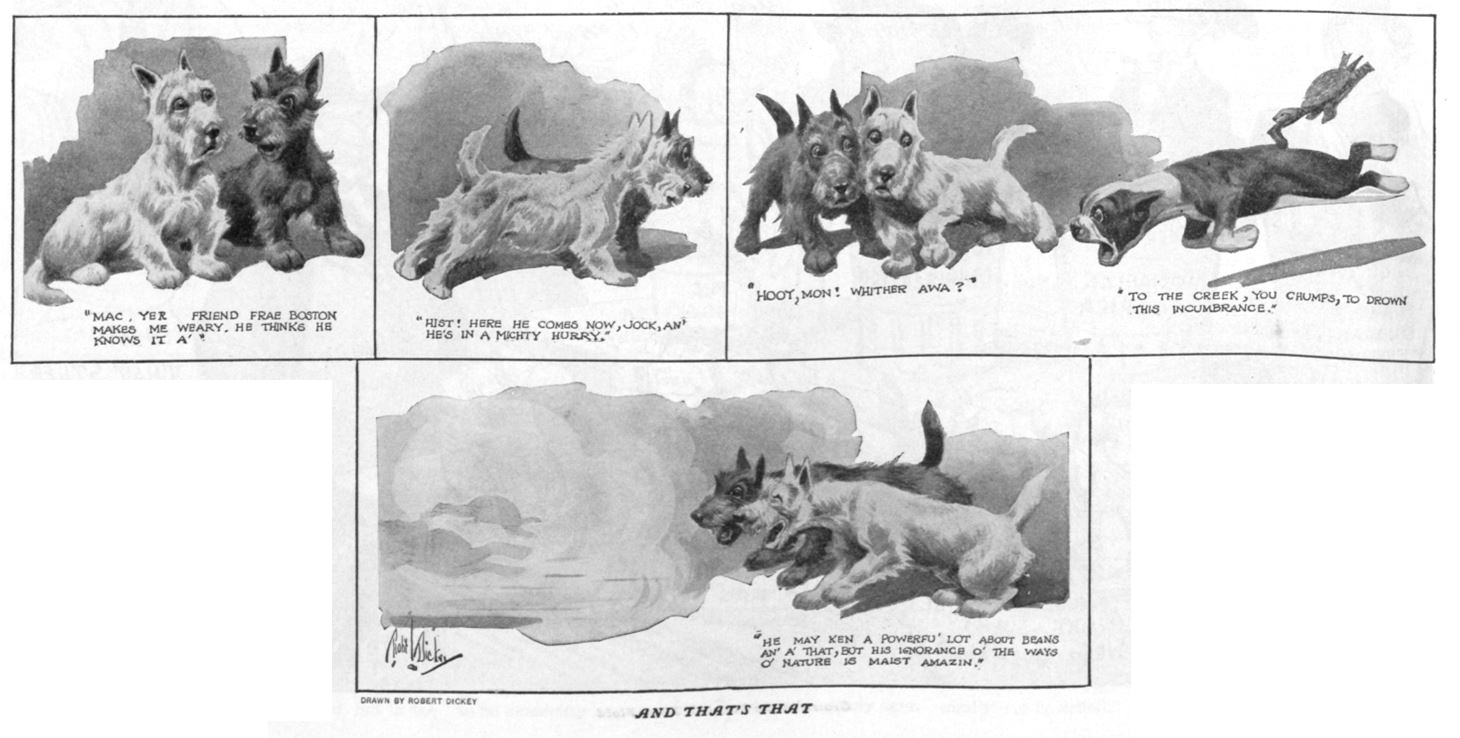
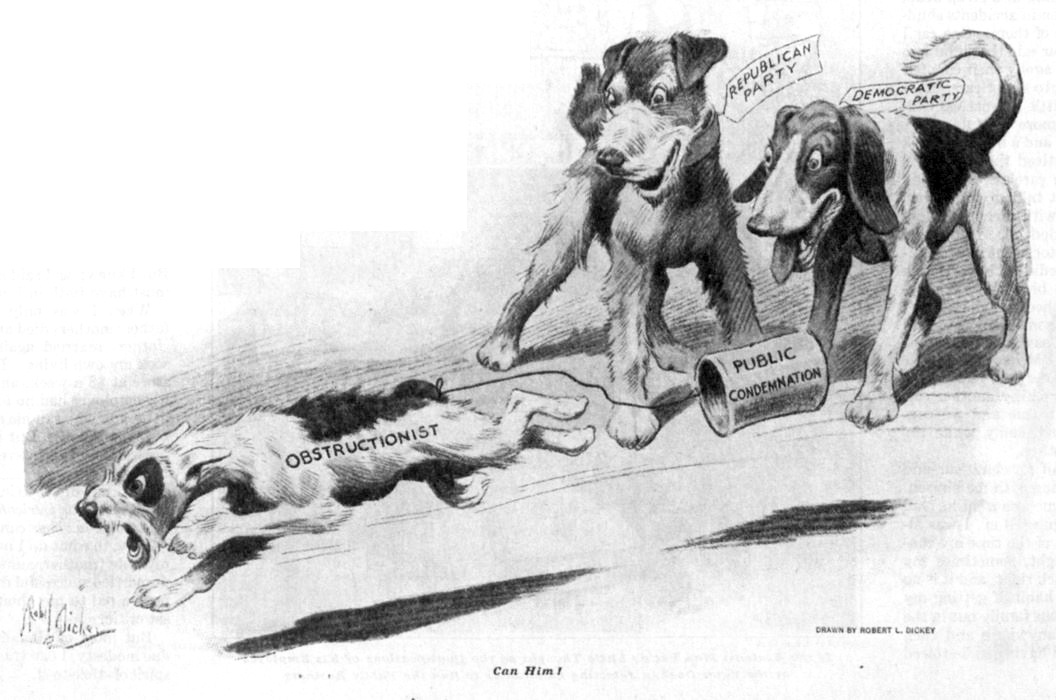
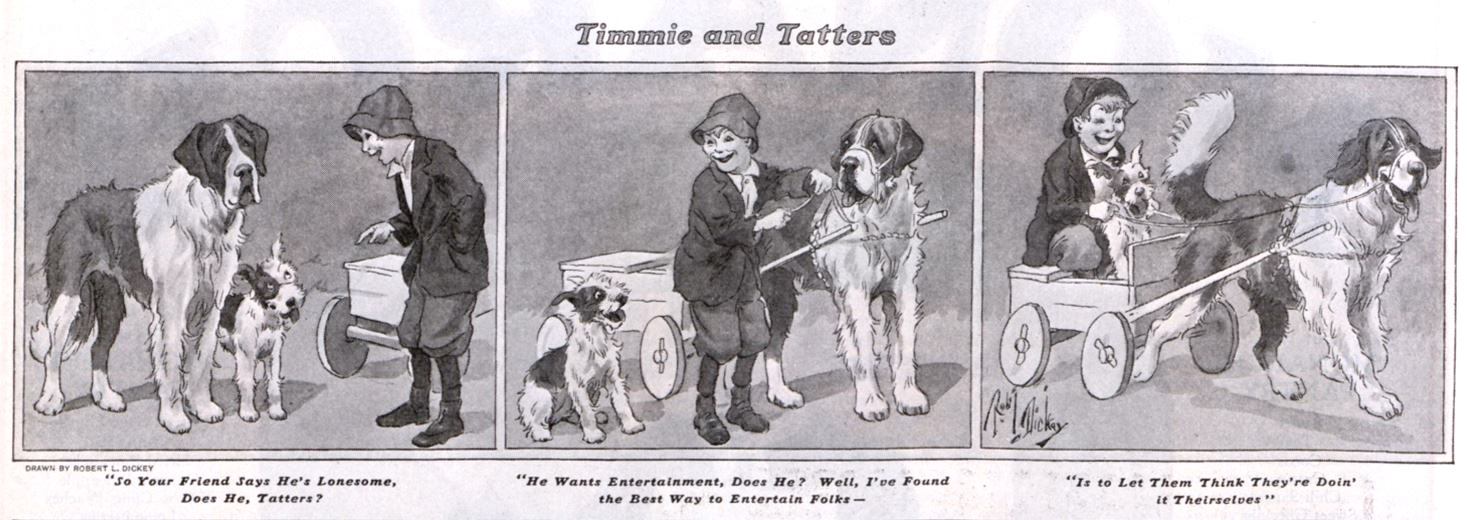
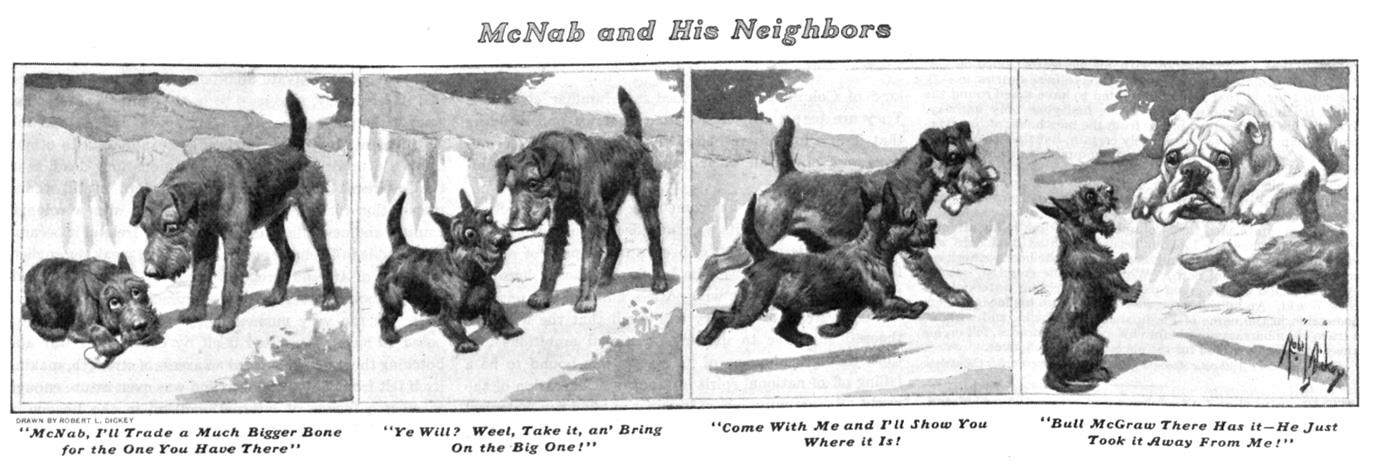
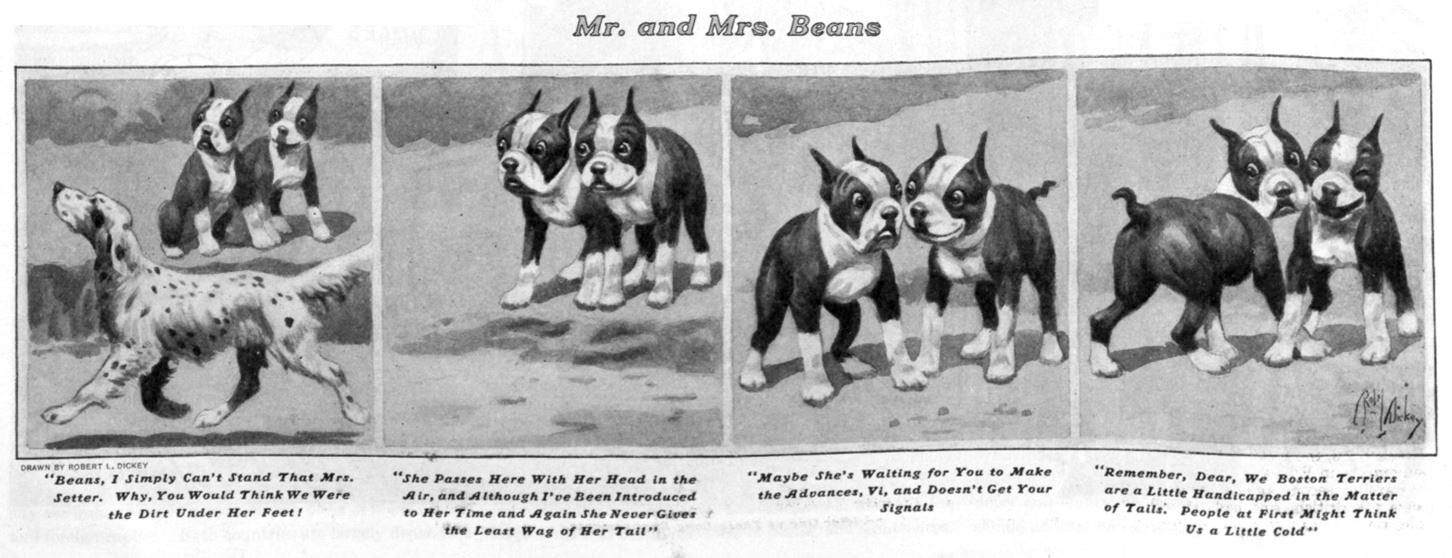
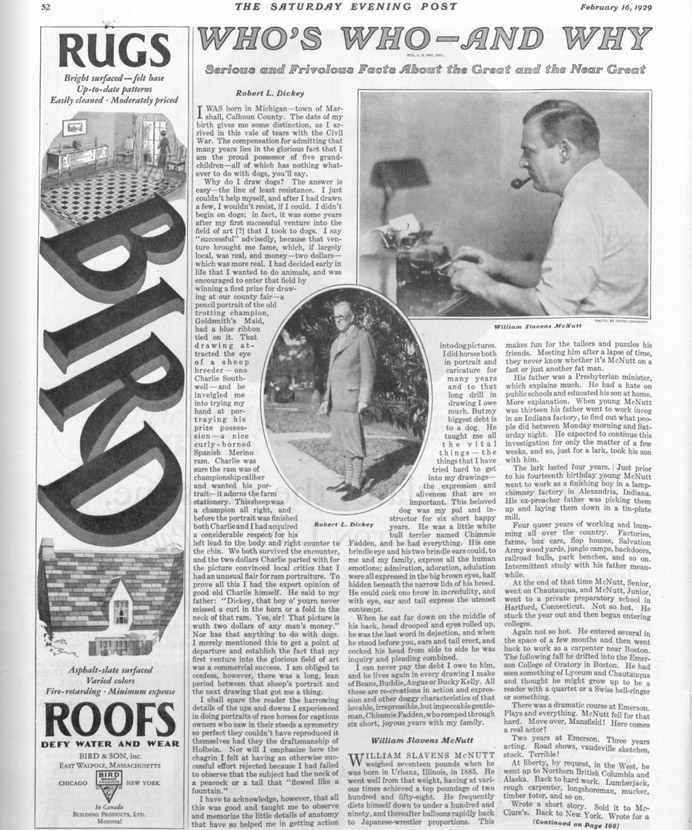
 Order a copy of The Saturday Evening Post: A Celebration of Dogs!, with full-color images by Robert L. Dickey, Norman Rockwell, and more.
Order a copy of The Saturday Evening Post: A Celebration of Dogs!, with full-color images by Robert L. Dickey, Norman Rockwell, and more. The Art of the Post: The Most Stubborn Illustrator
Read all of art critic David Apatoff’s columns here.
Of all the great artists whose works appeared in The Saturday Evening Post, none traveled farther to get there than Harvey Dunn.
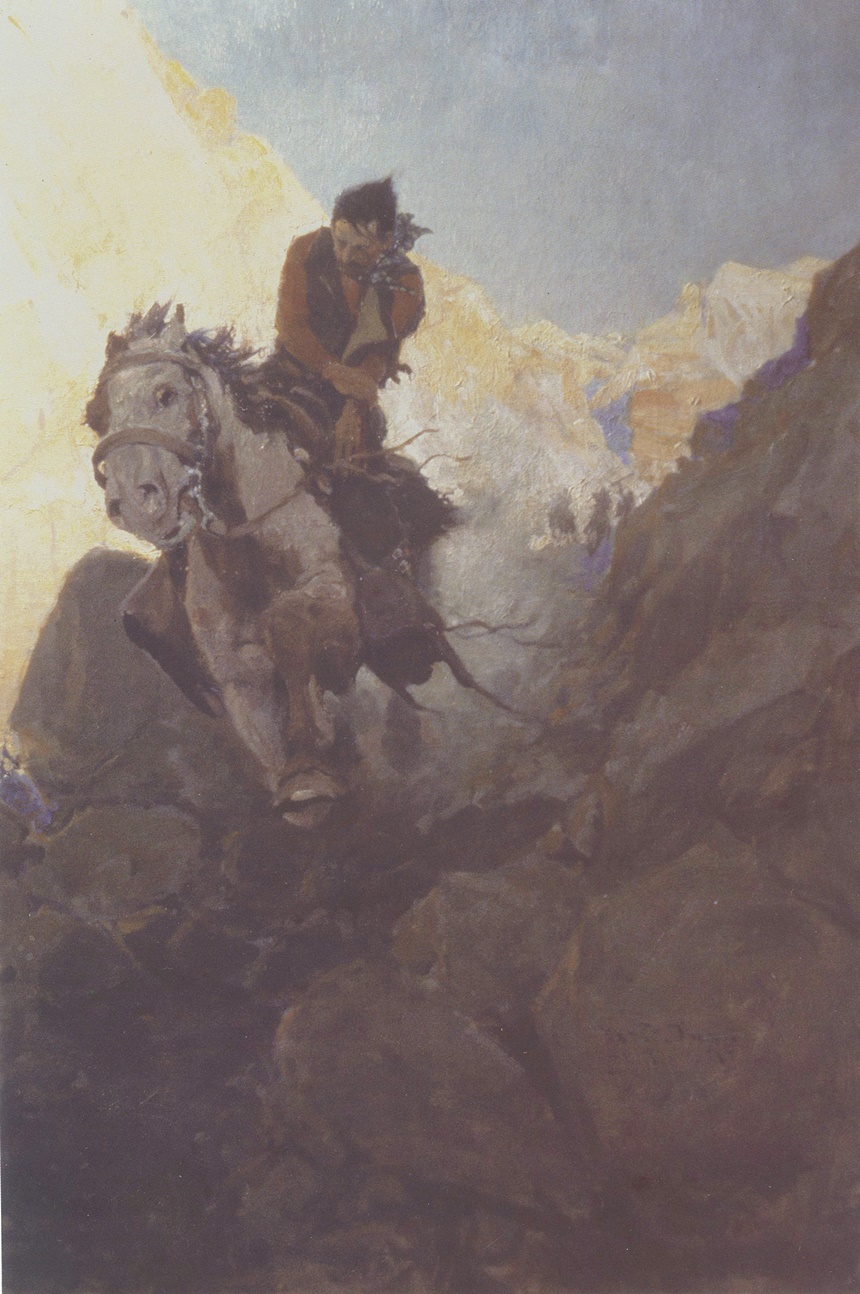
Dunn was born in 1884 on the prairie of South Dakota, along an ancient buffalo trail. His parents were homesteaders living in a seven by nine foot wooden shanty. Life was rugged and work was hard, but as the young family gradually tamed the land, their situation improved. When Dunn was four, his father was able to uproot their shanty and drag it by oxen to a better location. The family then acquired a few horses and added more land to their farm. Dunn grew up performing farm chores from sunrise to sunset, including plowing the hard soil and hoisting 150-pound sacks of wheat from the family’s thresher.
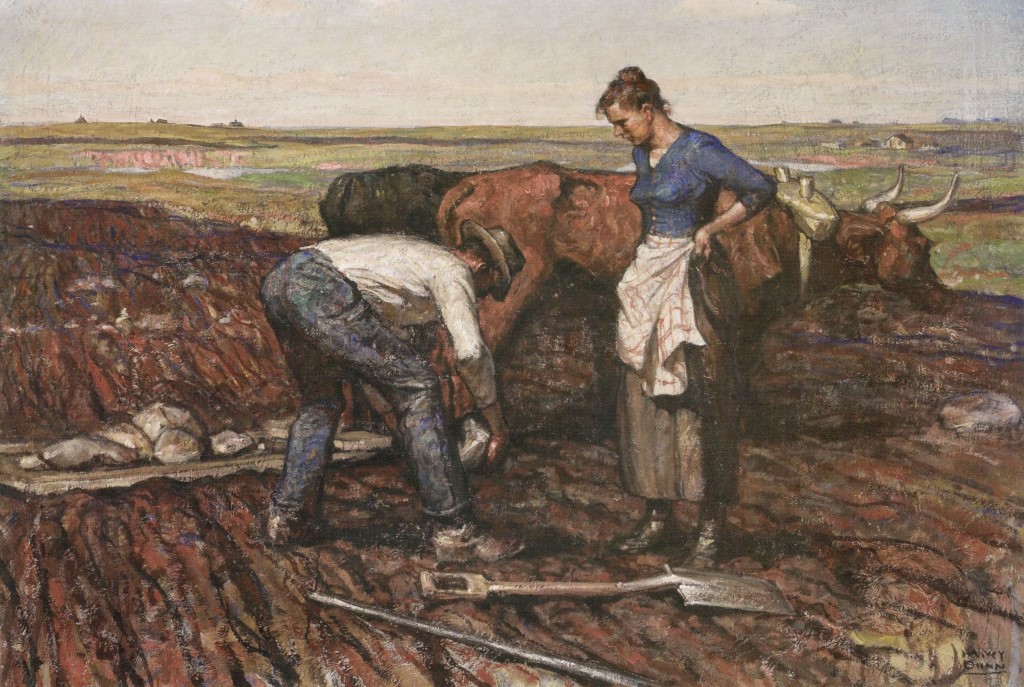
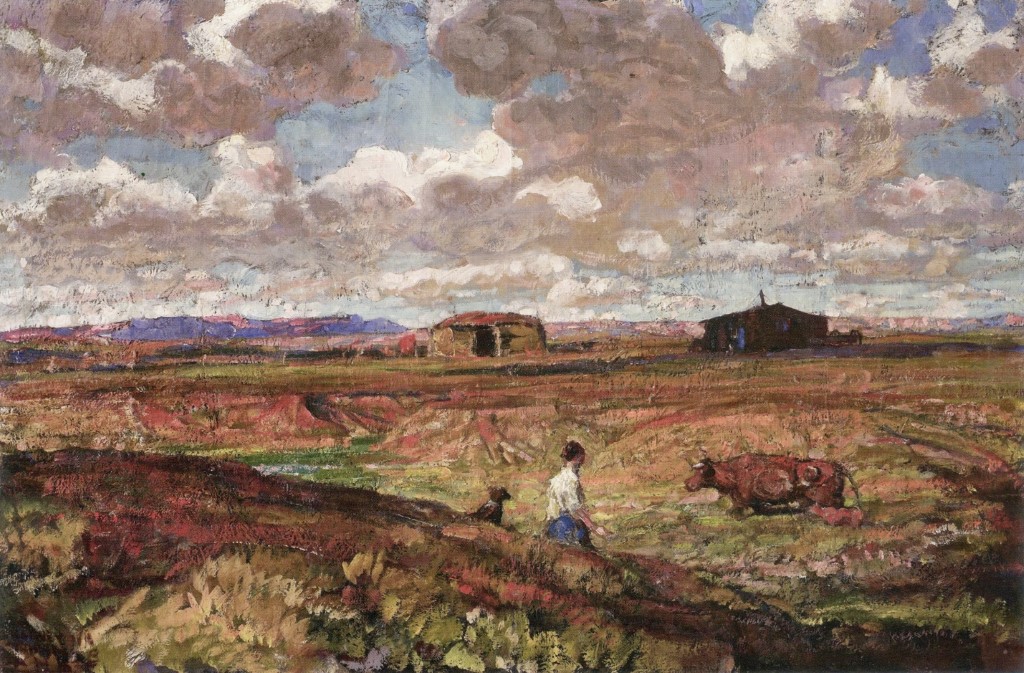
When he could, Dunn attended a one-room schoolhouse to learn basic reading, writing, and arithmetic. He was not a good student, but he loved to draw pictures on the side of the schoolhouse.
Dunn soon grew into a 6’2”, broad-shouldered young man with powerful features and a stubborn backbone. He would need every ounce of that strength and determination to plow his way from the prairie to the offices of The Saturday Evening Post in Philadelphia.
Dunn loved to draw and set his heart on becoming an artist. His father thought this was foolishness and tried to persuade Dunn to continue on the farm by offering him 640 acres of prime farmland for his very own. However, Dunn was determined to learn to draw and dreamed of going to the nearest school, the South Dakota Agricultural College in Brookings, South Dakota, 50 miles from the farm.
In order to pay for school, Dunn made extra money by plowing land for their neighbors. He was paid $1.25 an acre. He would start before daybreak and plow until 10 a.m. when the horses would become too exhausted to continue. He would then swap the initial team of five horses for a fresh team and go on plowing until 4 in the afternoon, when he once again swapped horses and continued plowing until well after sunset.
In 1901, at the age of 17, Dunn had earned enough money to enroll at the Agricultural College. An art teacher there soon recognized Dunn’s talent and urged him to continue his studies at a school that was better equipped to give him the training he needed — the Art Institute of Chicago. His family reluctantly agreed and Dunn went to Chicago to begin serious study in art. But the Art Institute turned out to be a more formal and rigid place then Dunn expected; they started him off in a junior composition class performing basic exercises such as organizing geometric shapes into compositions. Dunn thought this was a waste of time, so he went over the heads of his teachers to a senior class professor and showed his drawings of South Dakota. The professor agreed with Dunn so the young man was able to bypass some of the basic classes.
By 1904, Dunn was ready to skip ahead once again. He left the Art Institute for The Howard Pyle School of Illustration Art, the foremost school for illustrators in the country. Dunn went to study “under the grand old man Howard Pyle, whose main purpose was to quicken our souls that we might render services to the majesty of simple things.” With Pyle’s encouragement, Dunn began looking for work as an illustrator.
His very first art job came from The Saturday Evening Post in 1906. After being turned down by many other magazines, Dunn described his encounter with the Post: “[O]ne day I went to see Mr. Hardy at the Saturday Evening Post in Philadelphia. He looked my work over. Seemed delighted.” Dunn was skeptical. He had heard plenty of compliments from previous art directors, but they never resulted in a job, so he assumed Hardy was just brushing him off. However, “a week or so later, I was surprised to get a package from the Post and it is a manuscript with the note of the fact that they wanted five illustrations for it… I was in my seventh heaven.”
Dunn quickly painted all five illustrations in just five days. Then he discovered that he was supposed to submit preliminary sketches to the Post for approval before painting final versions. Dunn set the finished five paintings up against the wall and sketched them for approval by the Post. He described his next meeting with Hardy: “I went to Philadelphia with sketches and pictures in separate packages. I left the five paintings in the corridor outside while I went in to see Mr. Hardy with my sketches. He looked them over, seemed to like them. ‘Fine,’ he said. ‘Now when can I have them?’ ‘Just a minute, Mr. Hardy,’ and I went out into the corridor and brought in the five finished paintings.”
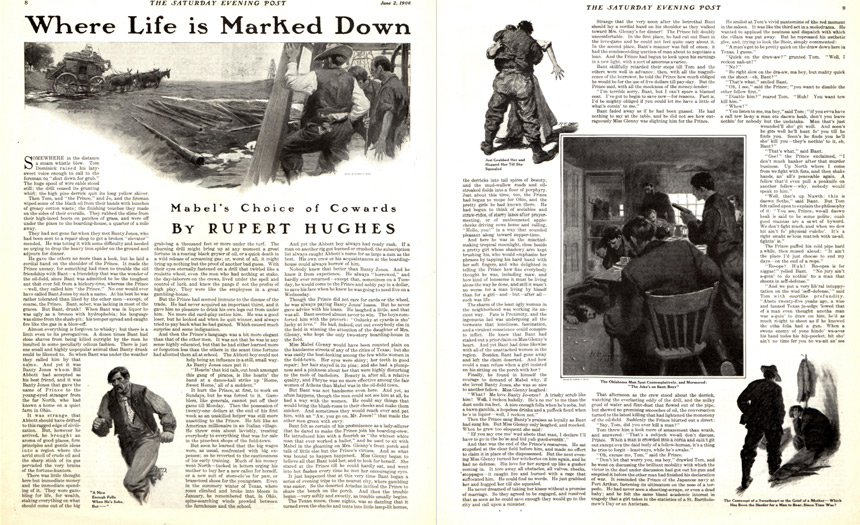
This was the beginning of a long and fruitful relationship for both the Post and Dunn. As one of Dunn’s biographers, Walt Reed wrote:
Dunn’s first patron and the longest lasting of his magazine affiliations was with the Saturday Evening Post. Its editor in chief was George Horace Lorimer, a man of strong convictions and a belief in the virtue of hard work as the route to success…. Lorimer saw that same spirit exemplified in the artwork of the young illustrator. Dunn’s ability to depict the cow hands, farmers, miners and factory workers who were the backbone of the country appealed to Lorimer, and he instructed the post art editor to keep the young Dunn supplied with manuscripts to illustrate. This association with the magazine continued over a period of 35 years.
Dunn went on to become one of the top illustrators in America. His work is displayed in fine art museums today, and is featured in several books. He also devoted a substantial portion of his career to teaching other young artists, and became famous as a mentor to a whole generation of talented illustrators.
Quite a distance to go for a young farmer from South Dakota.
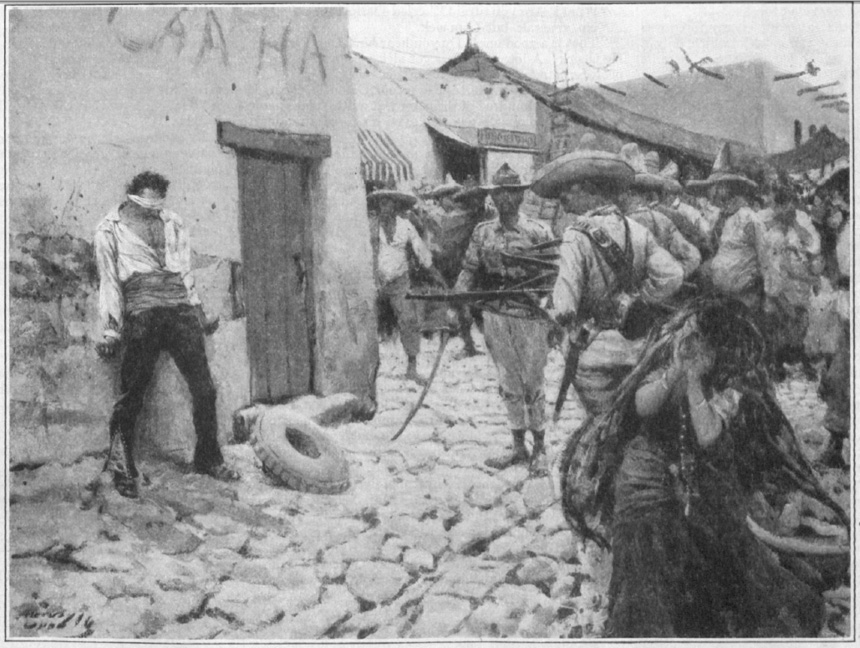
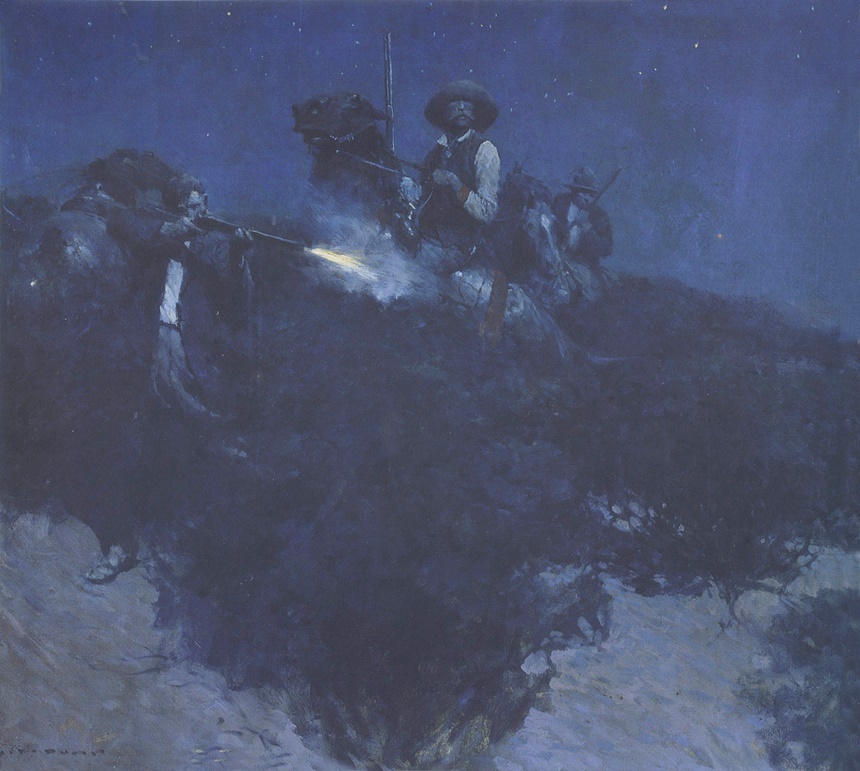
The Art of the Post: From the Pages of the Post to Museum Walls
Read all of art critic David Apatoff’s columns here.
The illustrations that appeared in The Saturday Evening Post were intended to last until the next issue came out. The Post was a “periodical,” designed only to fill a period of time until it was updated by a newer issue containing more current information, fashion trends, and merchandise for sale.
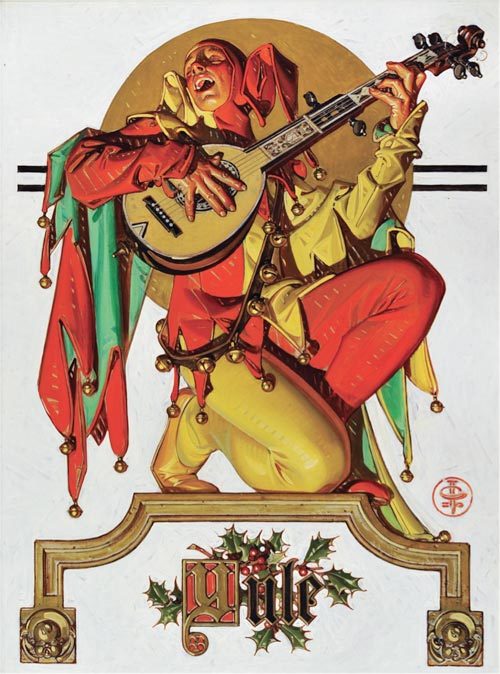
Generations of illustrators created beautiful pictures to fill the Post and other magazines, but it was always understood that they were creating temporary art; one day that thin magazine paper would turn brittle and yellow with age, and eventually crumble and return to mother nature.
It took a while for experts to recognize that illustrations had enduring value, but once Norman Rockwell’s 1951 cover for the Post, “Saying Grace,” sold for $46 million, even the most stubborn nay-sayers realized that this “temporary” art form was worth preserving.
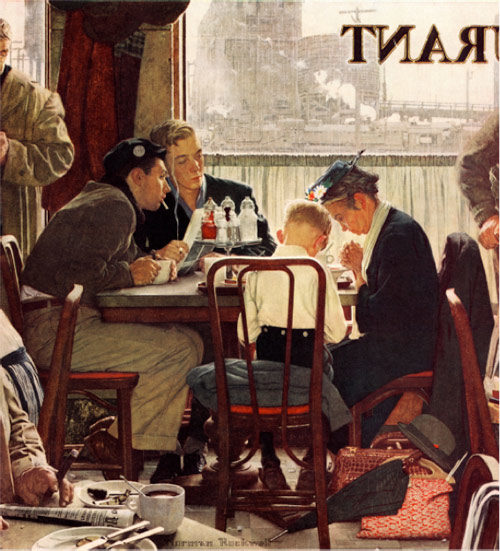
Today illustration art is being rescued and conserved by experts, to take its rightful place on museum walls.
During the decades when Rockwell and other illustrators were exiled from “fine” art, thousands of drawings and paintings were saved from the trash heap by a hardy band of collectors and artists who had the courage to ignore the condescension of highbrow art critics. These collectors weren’t intimidated by labels. Instead, they collected for the best possible reason: they loved the images. Their love of the pure art made them fearless, and they helped preserve the art form in private collections while the experts slowly had a change of heart.
One such collector was Andrew Sordoni III, who started out as a young boy smitten by the art in Sunday comic strips. He liked Dick Tracy and Krazy Kat and a handful of other strips that were delivered to his house in the funny papers. Fortunately, Sordoni’s mother was a fashion illustrator, and she taught him to respect the craft of good drawing. For many years “craftsmanship” was a dirty word in the fine arts community, but it served as a polar star for Sordoni’s collecting. Soon Sordoni began collecting unfashionable illustrators such as Maxfield Parrish. Today Parrish paintings have sold for millions of dollars.
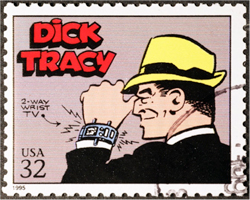 |
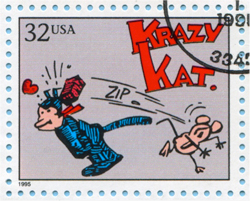 |
|
U.S. postage stamps featuring comics Dick Tracy and Krazy Kat. (Shutterstock) |
|
A lifetime of collecting has come to fruition in an opening this month of a large exhibition of American illustration art at the Sordoni Art Gallery in Wilkes-Barre, Pennsylvania.
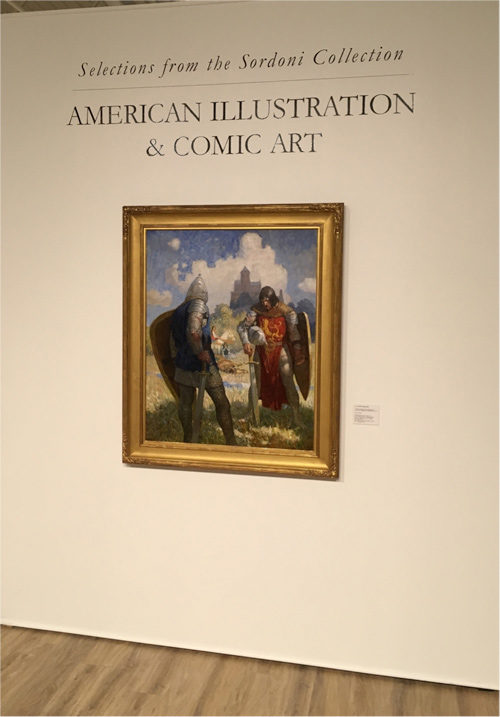
The show, which features one of the great private collections of American illustration, will run from April 7 to May 20, 2018. It was curated by Stanley I. Grand, Ph.D., a professor of art history and expert on the allegorical engravings from Giovanni Battista Ferrari’s De Florum Cultura.
The Sordoni show includes 135 works of art, including a number of illustrations that were originally seen in the pages of the Post, but which now can be seen as the artist created them.
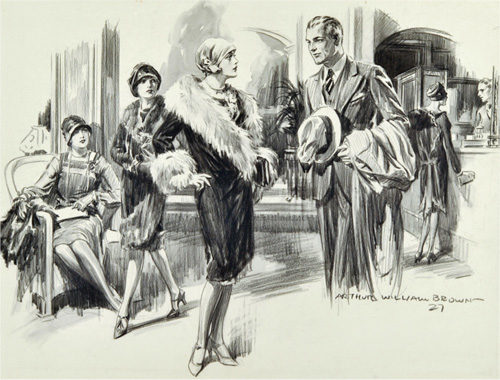
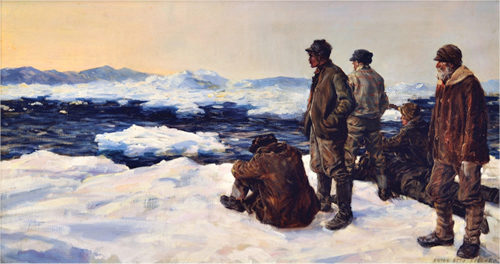
The collection reflects the personal taste of Sordoni, who collected what was once ignored as “lowbrow art.” As the catalog notes, “Andrew found his own way and collected works that were considered of lesser importance at the time, but are now highly regarded both in market and aesthetic terms.”
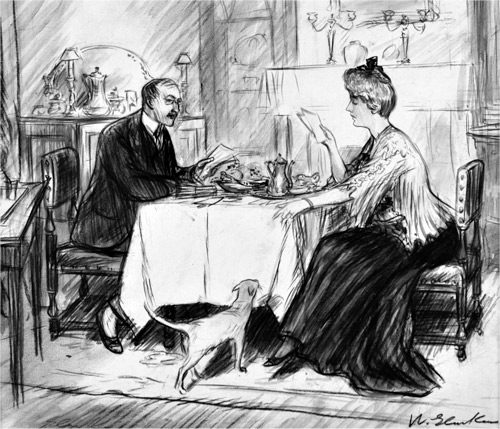
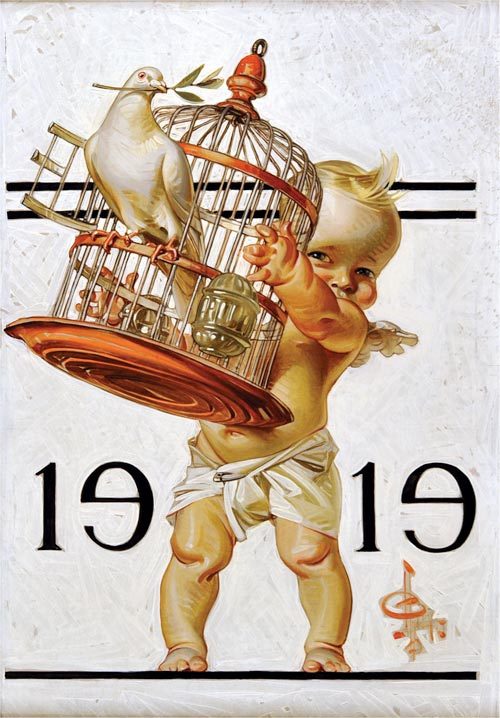
The art in the exhibit includes work by famed illustrators such as Rockwell, Parrish, and N.C. Wyeth. The substantial catalog accompanying the show is a prime example of how critical attention surrounding the field of illustration art has evolved from initial skepticism to serious study by respected academics and biographers who are devoting years and substantial critical analysis to multiple biographies.
While Rockwell was a groundbreaker in being accepted by the “fine” art community, other illustrators whose work appeared in the Post are hot on Rockwell’s heels. Artists such as J.C. Leyendecker, Dean Cornwell, Bernie Fuchs, Robert Fawcett, and others all have their own coffee table art books now, and the value of their original work at auction has increased dramatically. While illustration art was once auctioned in a separate category, much of it is now commingled and sold interchangeably with traditional American “fine” art.
When Art Could Shock
As visitors made their way into the art exhibition at the National Guard 69th Regiment Armory in New York 105 years ago, they passed through several partitioned rooms of sensible, American pieces before reaching the “chamber of horrors” in the back left corner. This was the room featuring cubist works of Marcel Duchamp, Albert Gleizes, and Jacques Villon, among others.
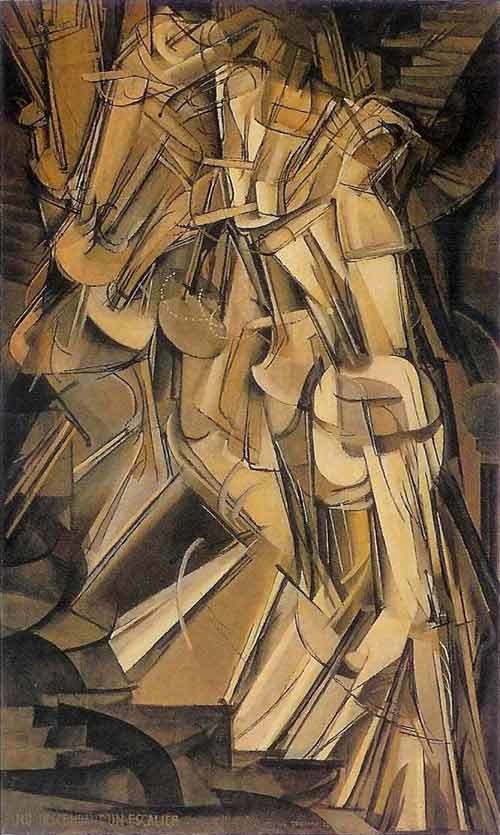
In the far corner of the cubist room was Duchamp’s Nude Descending a Staircase, No. 2. Inspired by time-lapse photography and new, avant-garde ideas of understanding time and space in art, Nude didn’t appear to resemble a nude at all, but rather an explosion. The painting delivered a cultural blow to the sensitivities of American art enthusiasts and became emblematic of the Armory Show’s legacy. American Art News lampooned the painting, offering 10 dollars to anyone who could “find the lady” in its mess of lines and shapes. Perhaps Duchamp had the last laugh when the piece sold for 324 dollars (about 7,800 dollars in today’s money).
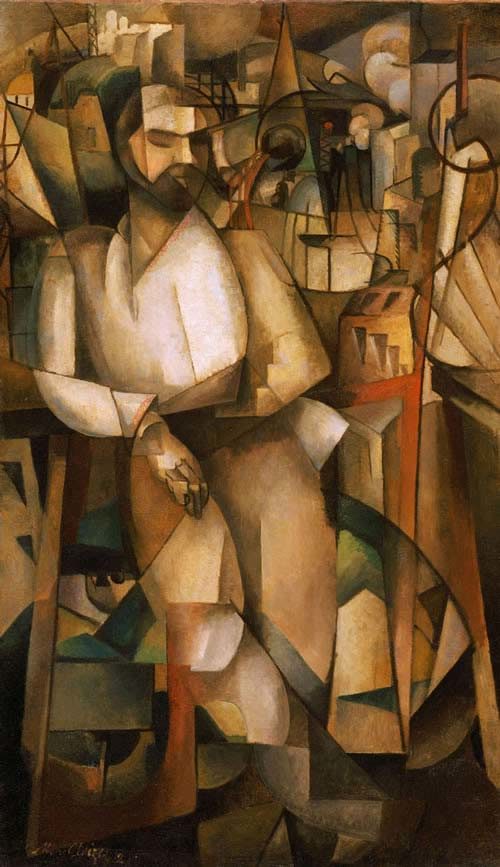
The 1913 Armory Show — also known as the International Exhibition of Modern Art — is considered the single most influential event in American modern art, completely disrupting the conservative tastes of early twentieth-century America. About 1,200 paintings were involved in the exhibition, two-thirds of which were the experimental stylings of Europe’s flourishing modernist movement.
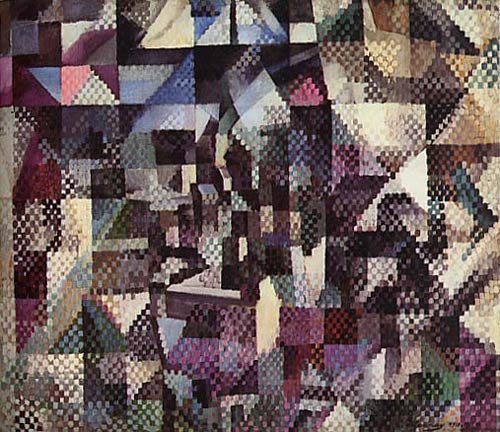
The real fun began at the exhibition’s next stop, in Chicago, where the amount of attendees was more than double that of New York. “I assert that Matisse is an impostor,” said an art historian from the University of Chicago, “that his pictures are lacking in all elements of true art, and that the cubists are just exactly nothing.” Students from the School of the Art Institute of Chicago held a protest, burning reproductions of Matisse works on the street in effigy. The Fauvist works of Henri Matisse — particularly his nudes — were appalling to conservatives in their tendency to abstract the human form and replace skin tones with bright colors.
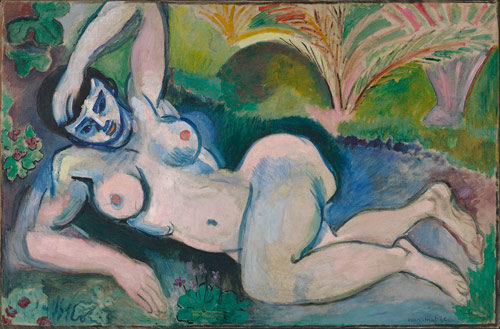
It would now be difficult for an art exhibition to elicit the same amount of shock and controversy. Dr. Jeff Hughes, a professor of art history and criticism at Webster University, says “it would be almost impossible to experience anything as new” in our current media environment “because we don’t experience it together.” In 1913, there was no television or color photography to bring these forward-thinking European movements to Americans in any significant way.
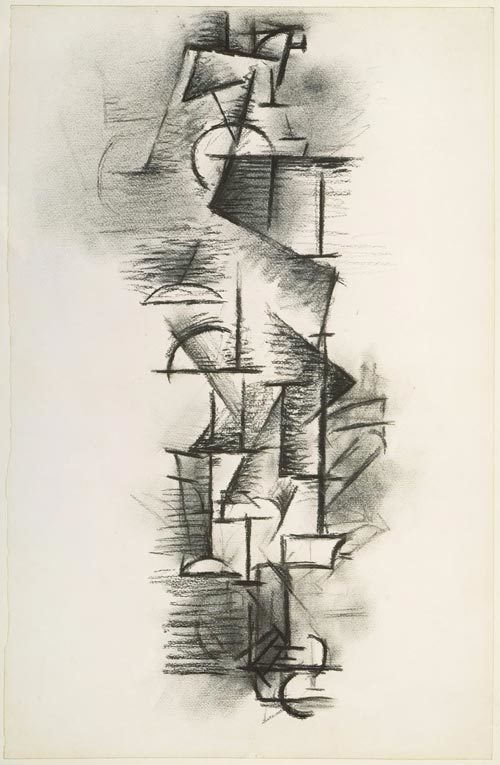
It’s no secret that the cultural conservatism of the U.S. differed greatly from Western Europe at the turn of the century, and this was reflected in the art world. Dr. Hughes attributes this to “a built-in notion in the Protestant work ethic that making art is not real work.” Part of the legacy of the Armory Show is that it was a large, international exhibition. International shows of this scope were uncommon at the time in Europe, and certainly in America, according to Dr. Hughes.
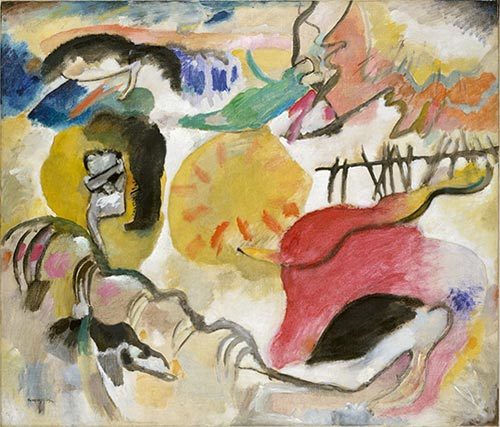
In 2014, art critic Jed Perl wrote of the show, in The New Republic, that “the conservatives lost. The avant-garde won. End of story.” Plenty of art movements since 1913 have caused a stir, like the postwar abstract expressionists or the pop art of the ’50s and ’60s. However, the Armory Show, arguably, launched an arc in American art in which these styles could have an audience.
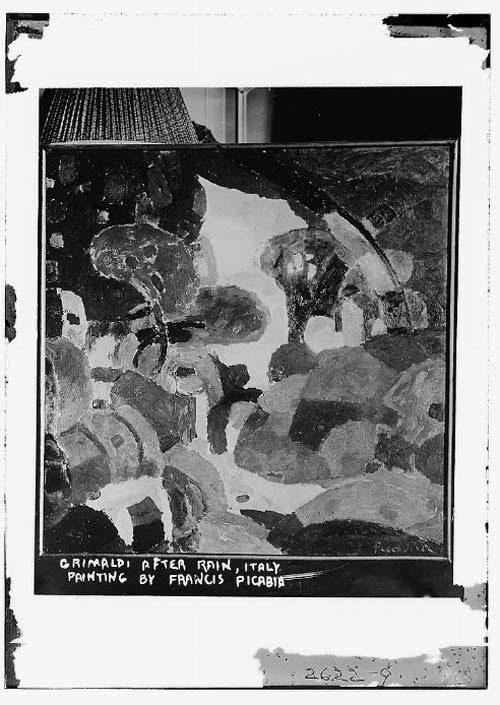
In the years after the exhibition, the country went to war, women won their right to vote, and Hollywood began churning out motion pictures. Duchamp, Picasso, and Matisse may have been an unwelcome shock, but the Armory Show was only a taste of the cultural changes to come.